Leadership Styles: An Analysis of Behavioral Theories
VerifiedAdded on 2019/09/16
|63
|18495
|380
Report
AI Summary
The behavioural theory of leadership refers to the various styles or approaches that a leader can adopt to manage and direct their team effectively. According to Fiedler's Contingency Theory, leadership effectiveness is dependent on the match between the leader's style and the situational factors. The assignment highlights several types of leadership styles, including directive, autocratic, transformational, transactional, and servant leadership. It also discusses the advantages and disadvantages of each style, as well as their applicability in different situations. Moreover, it touches upon trait theories of leadership, which emphasize the importance of a leader's personality, values, and skills in influencing their followers.
Contribute Materials
Your contribution can guide someone’s learning journey. Share your
documents today.
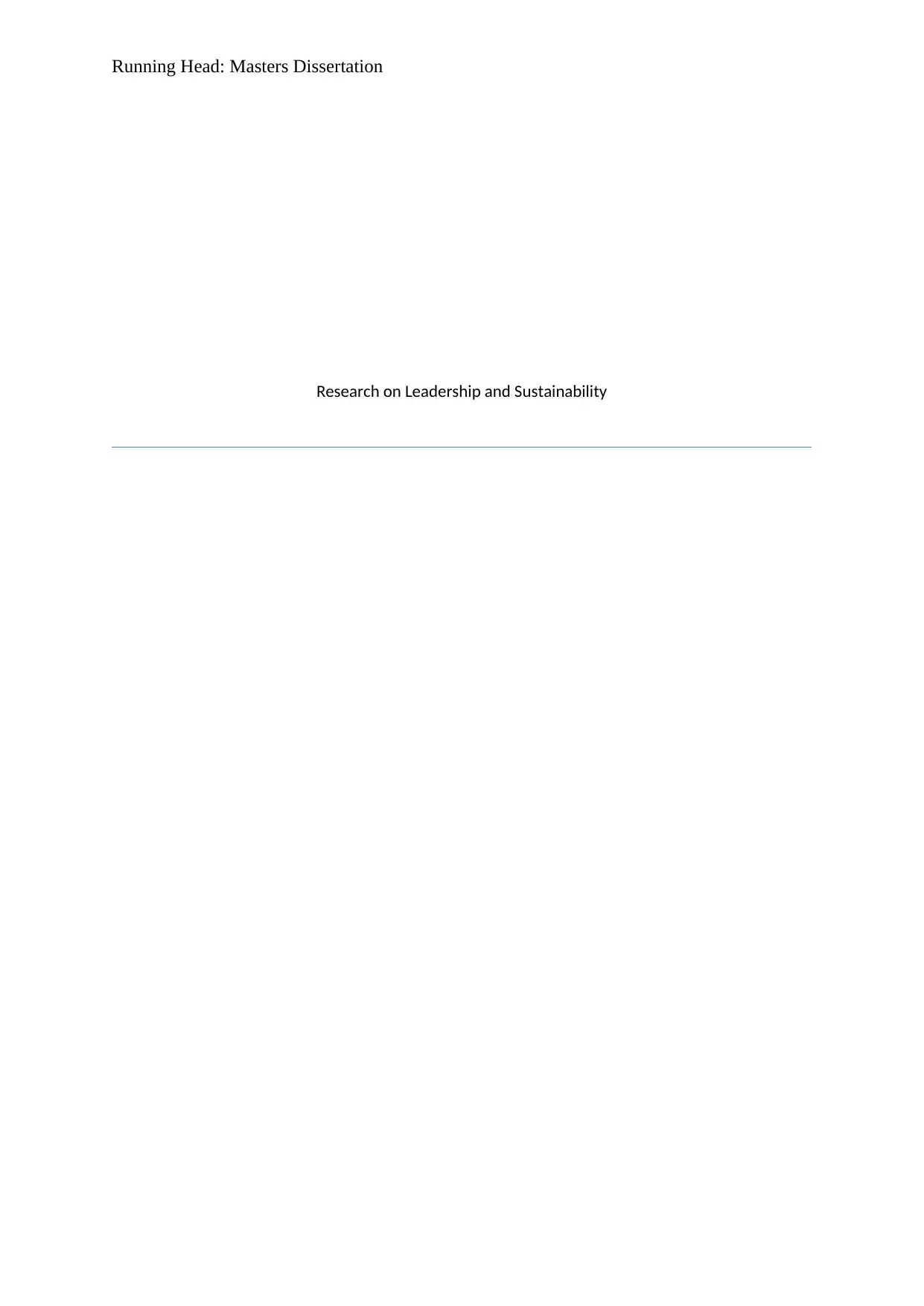
Running Head: Masters Dissertation
Research on Leadership and Sustainability
Research on Leadership and Sustainability
Secure Best Marks with AI Grader
Need help grading? Try our AI Grader for instant feedback on your assignments.
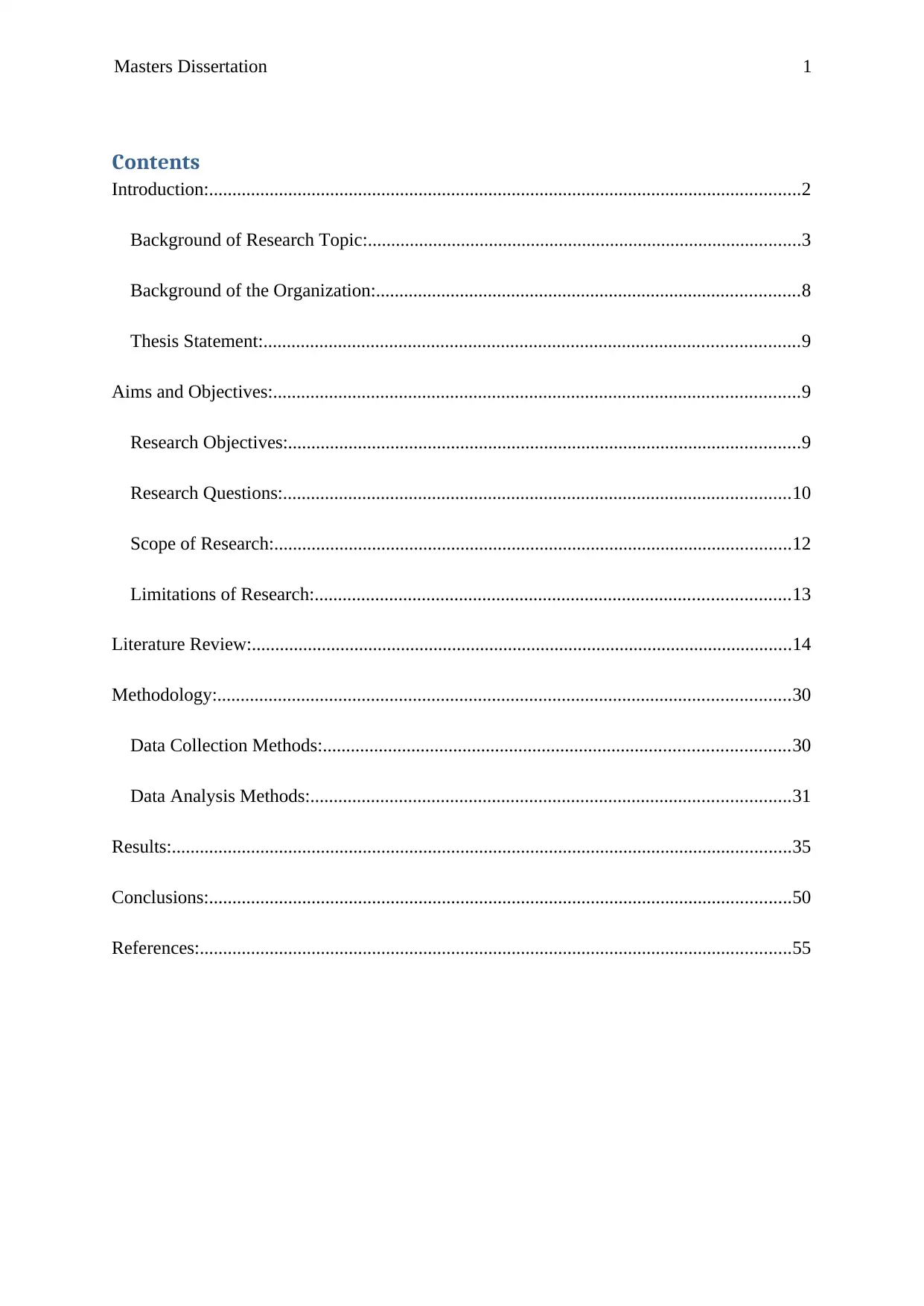
Masters Dissertation 1
Contents
Introduction:...............................................................................................................................2
Background of Research Topic:.............................................................................................3
Background of the Organization:...........................................................................................8
Thesis Statement:...................................................................................................................9
Aims and Objectives:.................................................................................................................9
Research Objectives:..............................................................................................................9
Research Questions:.............................................................................................................10
Scope of Research:...............................................................................................................12
Limitations of Research:......................................................................................................13
Literature Review:....................................................................................................................14
Methodology:...........................................................................................................................30
Data Collection Methods:....................................................................................................30
Data Analysis Methods:.......................................................................................................31
Results:.....................................................................................................................................35
Conclusions:.............................................................................................................................50
References:...............................................................................................................................55
Contents
Introduction:...............................................................................................................................2
Background of Research Topic:.............................................................................................3
Background of the Organization:...........................................................................................8
Thesis Statement:...................................................................................................................9
Aims and Objectives:.................................................................................................................9
Research Objectives:..............................................................................................................9
Research Questions:.............................................................................................................10
Scope of Research:...............................................................................................................12
Limitations of Research:......................................................................................................13
Literature Review:....................................................................................................................14
Methodology:...........................................................................................................................30
Data Collection Methods:....................................................................................................30
Data Analysis Methods:.......................................................................................................31
Results:.....................................................................................................................................35
Conclusions:.............................................................................................................................50
References:...............................................................................................................................55

Masters Dissertation 2
Introduction:
Contained in this report are the findings from a research study that has been undertaken on
the topic of leadership, decision-making and their impacts on sustainability of an
organization. The research has endeavoured to determine the various traits and characteristics
of leadership in terms of the ways it differs between the managers in the public and private
sectors. The research has also attempted to determine the impacts of leadership traits on
managerial decision-making along with finding out the impact of managerial leadership on
the sustainability of an organization. For this particular research study, the case of a medical
device group has been investigated. The company manufactures and sells various emergency
drugs and medical devices in Israel. The organization also markets its products in various
other countries like the US, China and a few other Asian countries. Three years back, the
company has entered into a merger with one of its suppliers and after that some issues have
emerged related to the quality of some of the medical products those needed to be recalled.
There was some lack of managerial leadership and effective decision-making that was
observed after a new Chief Executive Officer (CEO) was appointed as the head of the newly
formed company.
This decision was later on speculated to be non-effective and counter-productive for the
organization. This was because the current CEO belonged to a governmental organization
that was a part of the non-profit seeking sector of the industry. Naturally, he lacked the
managerial leadership and decision-making skills required in a much competitive private
sector. Moreover, he was not a person from the medical background and therefore it was
quite obvious that he would not be able to provide an impactful and goal-oriented leadership
in this newly formed organization because the leadership skills nurtured and developed in the
public sector are quite different than those needed to direct a private sector organization that
Introduction:
Contained in this report are the findings from a research study that has been undertaken on
the topic of leadership, decision-making and their impacts on sustainability of an
organization. The research has endeavoured to determine the various traits and characteristics
of leadership in terms of the ways it differs between the managers in the public and private
sectors. The research has also attempted to determine the impacts of leadership traits on
managerial decision-making along with finding out the impact of managerial leadership on
the sustainability of an organization. For this particular research study, the case of a medical
device group has been investigated. The company manufactures and sells various emergency
drugs and medical devices in Israel. The organization also markets its products in various
other countries like the US, China and a few other Asian countries. Three years back, the
company has entered into a merger with one of its suppliers and after that some issues have
emerged related to the quality of some of the medical products those needed to be recalled.
There was some lack of managerial leadership and effective decision-making that was
observed after a new Chief Executive Officer (CEO) was appointed as the head of the newly
formed company.
This decision was later on speculated to be non-effective and counter-productive for the
organization. This was because the current CEO belonged to a governmental organization
that was a part of the non-profit seeking sector of the industry. Naturally, he lacked the
managerial leadership and decision-making skills required in a much competitive private
sector. Moreover, he was not a person from the medical background and therefore it was
quite obvious that he would not be able to provide an impactful and goal-oriented leadership
in this newly formed organization because the leadership skills nurtured and developed in the
public sector are quite different than those needed to direct a private sector organization that
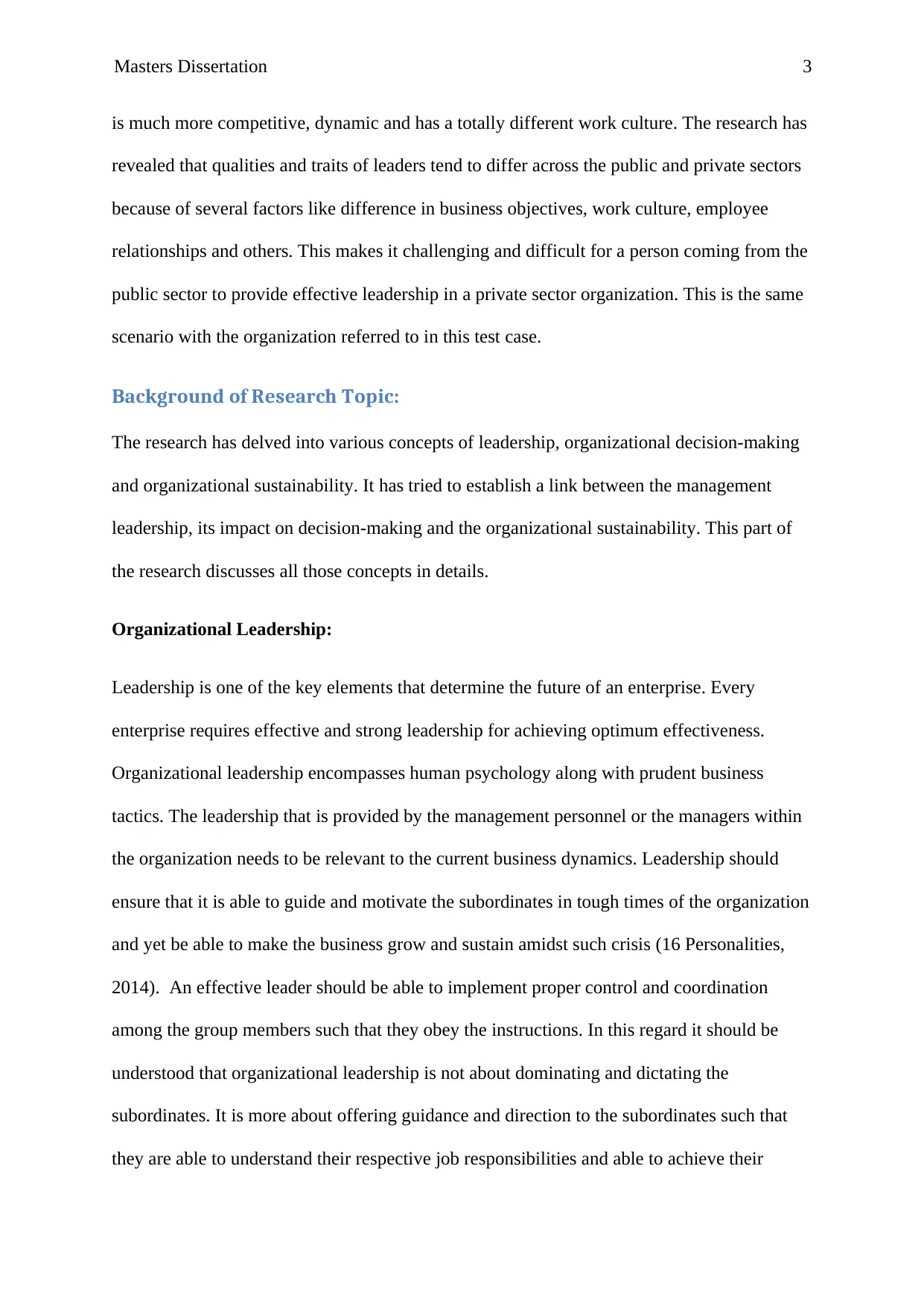
Masters Dissertation 3
is much more competitive, dynamic and has a totally different work culture. The research has
revealed that qualities and traits of leaders tend to differ across the public and private sectors
because of several factors like difference in business objectives, work culture, employee
relationships and others. This makes it challenging and difficult for a person coming from the
public sector to provide effective leadership in a private sector organization. This is the same
scenario with the organization referred to in this test case.
Background of Research Topic:
The research has delved into various concepts of leadership, organizational decision-making
and organizational sustainability. It has tried to establish a link between the management
leadership, its impact on decision-making and the organizational sustainability. This part of
the research discusses all those concepts in details.
Organizational Leadership:
Leadership is one of the key elements that determine the future of an enterprise. Every
enterprise requires effective and strong leadership for achieving optimum effectiveness.
Organizational leadership encompasses human psychology along with prudent business
tactics. The leadership that is provided by the management personnel or the managers within
the organization needs to be relevant to the current business dynamics. Leadership should
ensure that it is able to guide and motivate the subordinates in tough times of the organization
and yet be able to make the business grow and sustain amidst such crisis (16 Personalities,
2014). An effective leader should be able to implement proper control and coordination
among the group members such that they obey the instructions. In this regard it should be
understood that organizational leadership is not about dominating and dictating the
subordinates. It is more about offering guidance and direction to the subordinates such that
they are able to understand their respective job responsibilities and able to achieve their
is much more competitive, dynamic and has a totally different work culture. The research has
revealed that qualities and traits of leaders tend to differ across the public and private sectors
because of several factors like difference in business objectives, work culture, employee
relationships and others. This makes it challenging and difficult for a person coming from the
public sector to provide effective leadership in a private sector organization. This is the same
scenario with the organization referred to in this test case.
Background of Research Topic:
The research has delved into various concepts of leadership, organizational decision-making
and organizational sustainability. It has tried to establish a link between the management
leadership, its impact on decision-making and the organizational sustainability. This part of
the research discusses all those concepts in details.
Organizational Leadership:
Leadership is one of the key elements that determine the future of an enterprise. Every
enterprise requires effective and strong leadership for achieving optimum effectiveness.
Organizational leadership encompasses human psychology along with prudent business
tactics. The leadership that is provided by the management personnel or the managers within
the organization needs to be relevant to the current business dynamics. Leadership should
ensure that it is able to guide and motivate the subordinates in tough times of the organization
and yet be able to make the business grow and sustain amidst such crisis (16 Personalities,
2014). An effective leader should be able to implement proper control and coordination
among the group members such that they obey the instructions. In this regard it should be
understood that organizational leadership is not about dominating and dictating the
subordinates. It is more about offering guidance and direction to the subordinates such that
they are able to understand their respective job responsibilities and able to achieve their
Paraphrase This Document
Need a fresh take? Get an instant paraphrase of this document with our AI Paraphraser
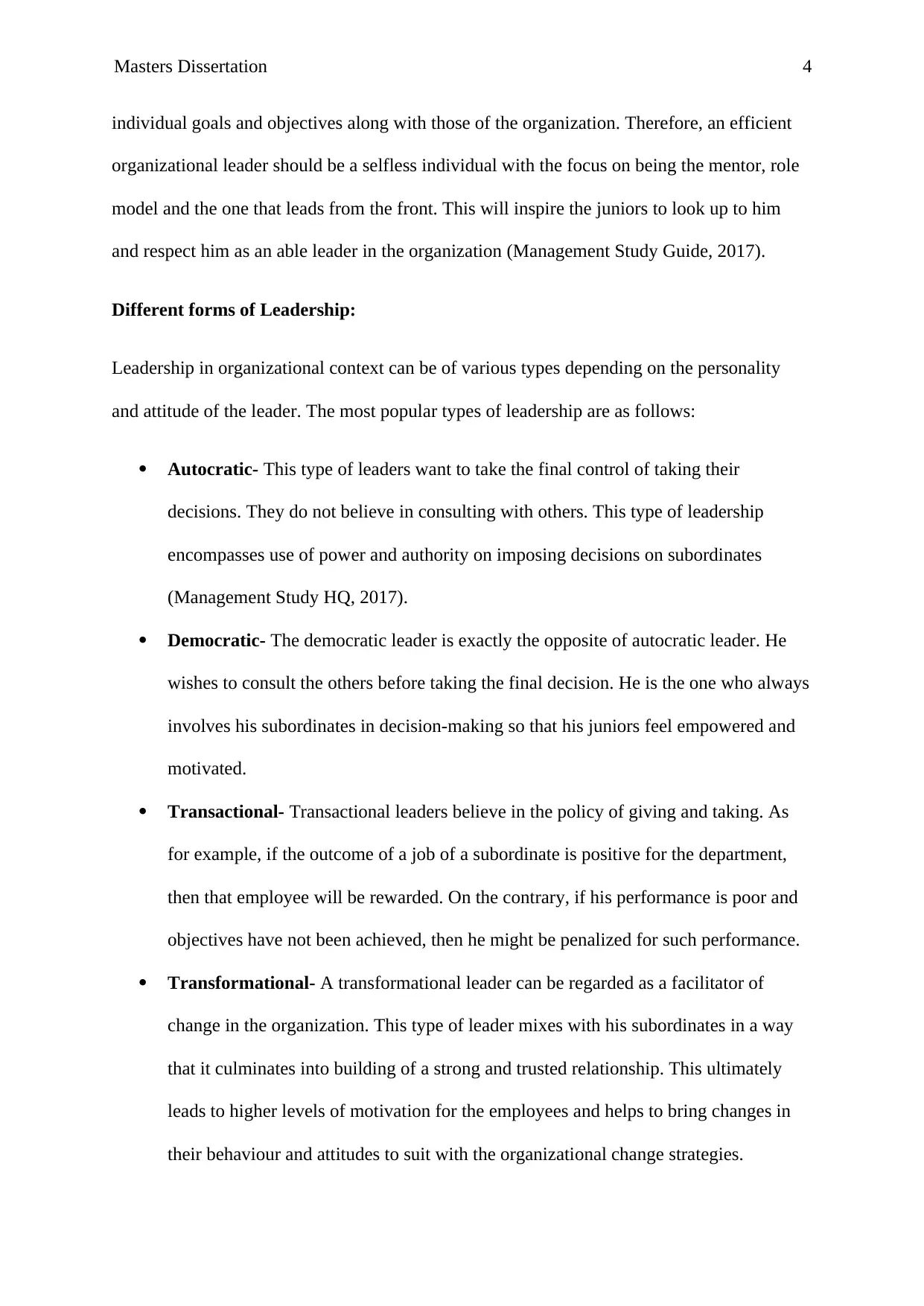
Masters Dissertation 4
individual goals and objectives along with those of the organization. Therefore, an efficient
organizational leader should be a selfless individual with the focus on being the mentor, role
model and the one that leads from the front. This will inspire the juniors to look up to him
and respect him as an able leader in the organization (Management Study Guide, 2017).
Different forms of Leadership:
Leadership in organizational context can be of various types depending on the personality
and attitude of the leader. The most popular types of leadership are as follows:
Autocratic- This type of leaders want to take the final control of taking their
decisions. They do not believe in consulting with others. This type of leadership
encompasses use of power and authority on imposing decisions on subordinates
(Management Study HQ, 2017).
Democratic- The democratic leader is exactly the opposite of autocratic leader. He
wishes to consult the others before taking the final decision. He is the one who always
involves his subordinates in decision-making so that his juniors feel empowered and
motivated.
Transactional- Transactional leaders believe in the policy of giving and taking. As
for example, if the outcome of a job of a subordinate is positive for the department,
then that employee will be rewarded. On the contrary, if his performance is poor and
objectives have not been achieved, then he might be penalized for such performance.
Transformational- A transformational leader can be regarded as a facilitator of
change in the organization. This type of leader mixes with his subordinates in a way
that it culminates into building of a strong and trusted relationship. This ultimately
leads to higher levels of motivation for the employees and helps to bring changes in
their behaviour and attitudes to suit with the organizational change strategies.
individual goals and objectives along with those of the organization. Therefore, an efficient
organizational leader should be a selfless individual with the focus on being the mentor, role
model and the one that leads from the front. This will inspire the juniors to look up to him
and respect him as an able leader in the organization (Management Study Guide, 2017).
Different forms of Leadership:
Leadership in organizational context can be of various types depending on the personality
and attitude of the leader. The most popular types of leadership are as follows:
Autocratic- This type of leaders want to take the final control of taking their
decisions. They do not believe in consulting with others. This type of leadership
encompasses use of power and authority on imposing decisions on subordinates
(Management Study HQ, 2017).
Democratic- The democratic leader is exactly the opposite of autocratic leader. He
wishes to consult the others before taking the final decision. He is the one who always
involves his subordinates in decision-making so that his juniors feel empowered and
motivated.
Transactional- Transactional leaders believe in the policy of giving and taking. As
for example, if the outcome of a job of a subordinate is positive for the department,
then that employee will be rewarded. On the contrary, if his performance is poor and
objectives have not been achieved, then he might be penalized for such performance.
Transformational- A transformational leader can be regarded as a facilitator of
change in the organization. This type of leader mixes with his subordinates in a way
that it culminates into building of a strong and trusted relationship. This ultimately
leads to higher levels of motivation for the employees and helps to bring changes in
their behaviour and attitudes to suit with the organizational change strategies.

Masters Dissertation 5
Laissez Faire- This type of leader does not believe in exercising direct control over
his subordinates. He does not offer continuous feedbacks as the employees are
expected to be committed towards their own responsibilities and it is expected that
they do not require continued supervision. This can often lead to under-performance
of team members due to lack of adequate control and supervision.
Situational- This type of leader believes in providing leadership based on the
prevailing situation. This form of leadership considers the characteristics of the team
members in the group those have to be led. It also accounts for the context of the
functioning of the group in order to offer effective leadership depending on the
situation (Pratt, 2017).
Differences of Leadership in Public and Private Sectors:
Leadership traits are found to differ across the private and the public sectors. This is because
there are differences in the goals and objectives of public and private sector organizations.
Some of the major differences include the strategies such as, for a private sector firm, the
emphasis is on generating the maximum possible financial returns on investments for the
benefit of the stakeholders (Get Smarter, 2017). Whereas, in case of the public sector
organizations the main business motive is to offer various products and services for the
benefit of the public and profitability is not the primary objective of this type of organization.
Apart from this, the private sector organizations are found to have more clearly defined
objectives those are focused on enhancing profitability as compared to the public sector
enterprises where the clarity of goals and objectives of the employees is much lower. This is
one of the prime reasons behind the form of leadership varying between the private and the
public sectors. The other major area of difference between leadership traits in public and
private sector organizations is the stakeholder expectations. In case of the public sector
organizations the major stakeholders are the public or the citizens of the country. Their
Laissez Faire- This type of leader does not believe in exercising direct control over
his subordinates. He does not offer continuous feedbacks as the employees are
expected to be committed towards their own responsibilities and it is expected that
they do not require continued supervision. This can often lead to under-performance
of team members due to lack of adequate control and supervision.
Situational- This type of leader believes in providing leadership based on the
prevailing situation. This form of leadership considers the characteristics of the team
members in the group those have to be led. It also accounts for the context of the
functioning of the group in order to offer effective leadership depending on the
situation (Pratt, 2017).
Differences of Leadership in Public and Private Sectors:
Leadership traits are found to differ across the private and the public sectors. This is because
there are differences in the goals and objectives of public and private sector organizations.
Some of the major differences include the strategies such as, for a private sector firm, the
emphasis is on generating the maximum possible financial returns on investments for the
benefit of the stakeholders (Get Smarter, 2017). Whereas, in case of the public sector
organizations the main business motive is to offer various products and services for the
benefit of the public and profitability is not the primary objective of this type of organization.
Apart from this, the private sector organizations are found to have more clearly defined
objectives those are focused on enhancing profitability as compared to the public sector
enterprises where the clarity of goals and objectives of the employees is much lower. This is
one of the prime reasons behind the form of leadership varying between the private and the
public sectors. The other major area of difference between leadership traits in public and
private sector organizations is the stakeholder expectations. In case of the public sector
organizations the major stakeholders are the public or the citizens of the country. Their
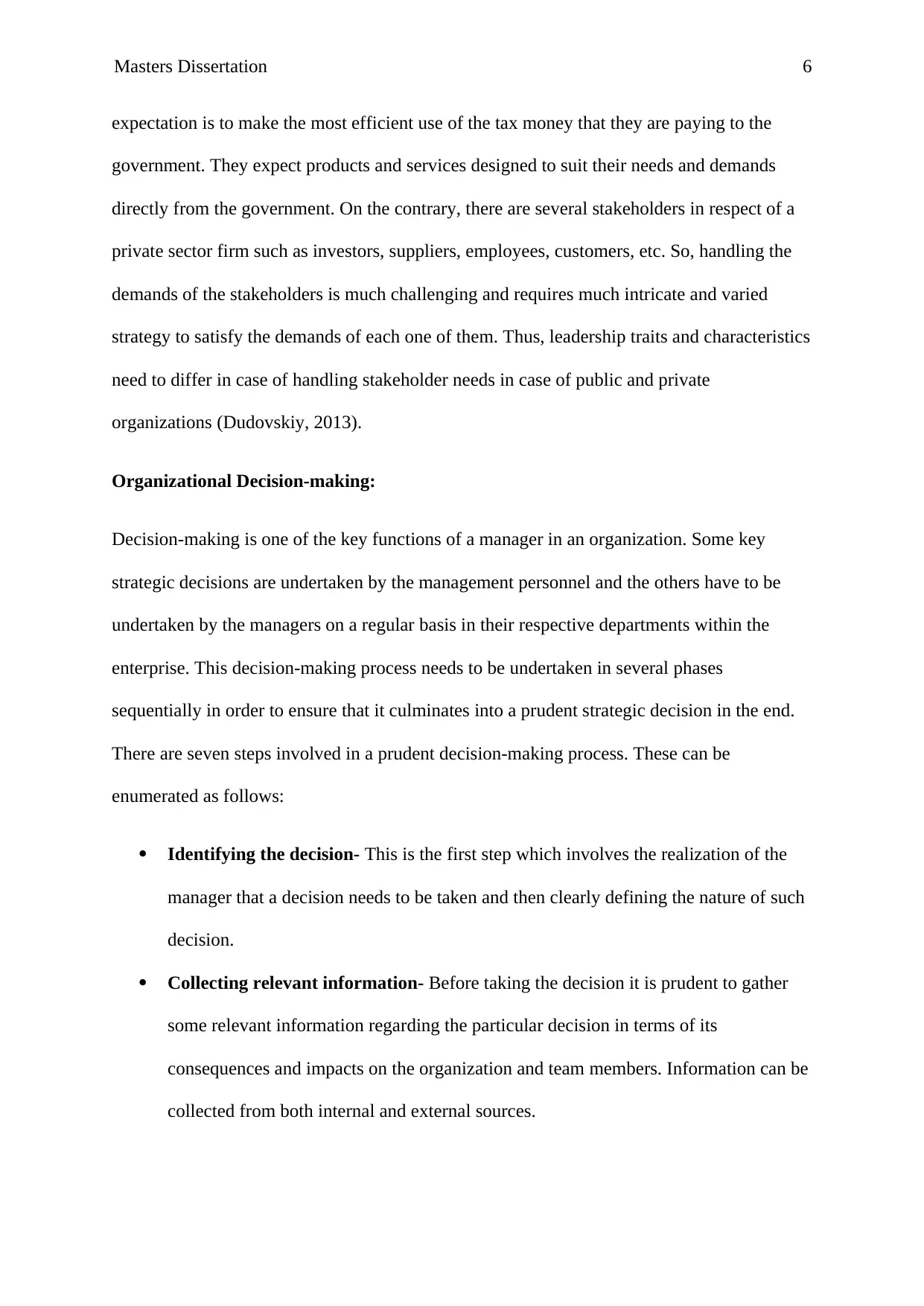
Masters Dissertation 6
expectation is to make the most efficient use of the tax money that they are paying to the
government. They expect products and services designed to suit their needs and demands
directly from the government. On the contrary, there are several stakeholders in respect of a
private sector firm such as investors, suppliers, employees, customers, etc. So, handling the
demands of the stakeholders is much challenging and requires much intricate and varied
strategy to satisfy the demands of each one of them. Thus, leadership traits and characteristics
need to differ in case of handling stakeholder needs in case of public and private
organizations (Dudovskiy, 2013).
Organizational Decision-making:
Decision-making is one of the key functions of a manager in an organization. Some key
strategic decisions are undertaken by the management personnel and the others have to be
undertaken by the managers on a regular basis in their respective departments within the
enterprise. This decision-making process needs to be undertaken in several phases
sequentially in order to ensure that it culminates into a prudent strategic decision in the end.
There are seven steps involved in a prudent decision-making process. These can be
enumerated as follows:
Identifying the decision- This is the first step which involves the realization of the
manager that a decision needs to be taken and then clearly defining the nature of such
decision.
Collecting relevant information- Before taking the decision it is prudent to gather
some relevant information regarding the particular decision in terms of its
consequences and impacts on the organization and team members. Information can be
collected from both internal and external sources.
expectation is to make the most efficient use of the tax money that they are paying to the
government. They expect products and services designed to suit their needs and demands
directly from the government. On the contrary, there are several stakeholders in respect of a
private sector firm such as investors, suppliers, employees, customers, etc. So, handling the
demands of the stakeholders is much challenging and requires much intricate and varied
strategy to satisfy the demands of each one of them. Thus, leadership traits and characteristics
need to differ in case of handling stakeholder needs in case of public and private
organizations (Dudovskiy, 2013).
Organizational Decision-making:
Decision-making is one of the key functions of a manager in an organization. Some key
strategic decisions are undertaken by the management personnel and the others have to be
undertaken by the managers on a regular basis in their respective departments within the
enterprise. This decision-making process needs to be undertaken in several phases
sequentially in order to ensure that it culminates into a prudent strategic decision in the end.
There are seven steps involved in a prudent decision-making process. These can be
enumerated as follows:
Identifying the decision- This is the first step which involves the realization of the
manager that a decision needs to be taken and then clearly defining the nature of such
decision.
Collecting relevant information- Before taking the decision it is prudent to gather
some relevant information regarding the particular decision in terms of its
consequences and impacts on the organization and team members. Information can be
collected from both internal and external sources.
Secure Best Marks with AI Grader
Need help grading? Try our AI Grader for instant feedback on your assignments.
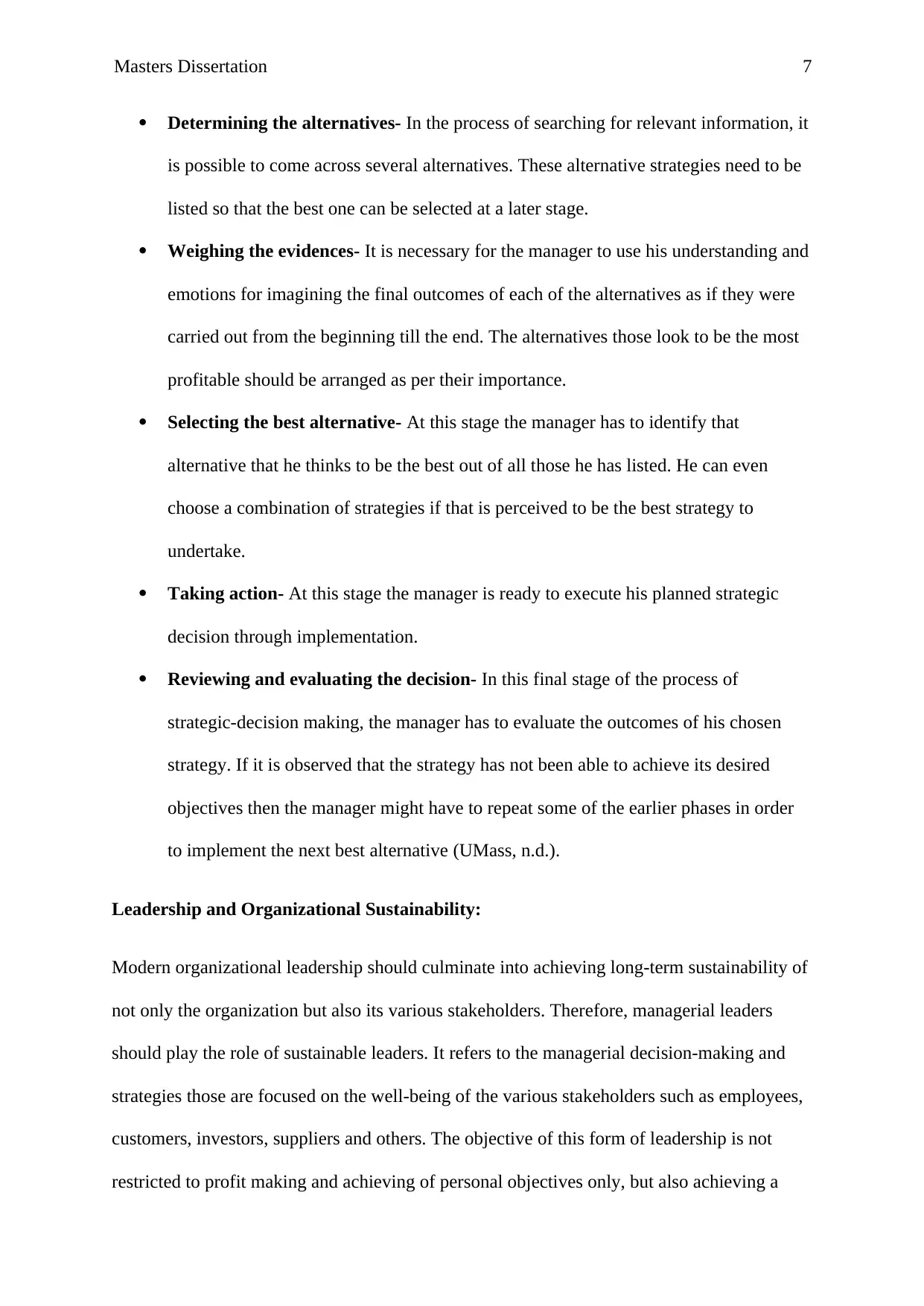
Masters Dissertation 7
Determining the alternatives- In the process of searching for relevant information, it
is possible to come across several alternatives. These alternative strategies need to be
listed so that the best one can be selected at a later stage.
Weighing the evidences- It is necessary for the manager to use his understanding and
emotions for imagining the final outcomes of each of the alternatives as if they were
carried out from the beginning till the end. The alternatives those look to be the most
profitable should be arranged as per their importance.
Selecting the best alternative- At this stage the manager has to identify that
alternative that he thinks to be the best out of all those he has listed. He can even
choose a combination of strategies if that is perceived to be the best strategy to
undertake.
Taking action- At this stage the manager is ready to execute his planned strategic
decision through implementation.
Reviewing and evaluating the decision- In this final stage of the process of
strategic-decision making, the manager has to evaluate the outcomes of his chosen
strategy. If it is observed that the strategy has not been able to achieve its desired
objectives then the manager might have to repeat some of the earlier phases in order
to implement the next best alternative (UMass, n.d.).
Leadership and Organizational Sustainability:
Modern organizational leadership should culminate into achieving long-term sustainability of
not only the organization but also its various stakeholders. Therefore, managerial leaders
should play the role of sustainable leaders. It refers to the managerial decision-making and
strategies those are focused on the well-being of the various stakeholders such as employees,
customers, investors, suppliers and others. The objective of this form of leadership is not
restricted to profit making and achieving of personal objectives only, but also achieving a
Determining the alternatives- In the process of searching for relevant information, it
is possible to come across several alternatives. These alternative strategies need to be
listed so that the best one can be selected at a later stage.
Weighing the evidences- It is necessary for the manager to use his understanding and
emotions for imagining the final outcomes of each of the alternatives as if they were
carried out from the beginning till the end. The alternatives those look to be the most
profitable should be arranged as per their importance.
Selecting the best alternative- At this stage the manager has to identify that
alternative that he thinks to be the best out of all those he has listed. He can even
choose a combination of strategies if that is perceived to be the best strategy to
undertake.
Taking action- At this stage the manager is ready to execute his planned strategic
decision through implementation.
Reviewing and evaluating the decision- In this final stage of the process of
strategic-decision making, the manager has to evaluate the outcomes of his chosen
strategy. If it is observed that the strategy has not been able to achieve its desired
objectives then the manager might have to repeat some of the earlier phases in order
to implement the next best alternative (UMass, n.d.).
Leadership and Organizational Sustainability:
Modern organizational leadership should culminate into achieving long-term sustainability of
not only the organization but also its various stakeholders. Therefore, managerial leaders
should play the role of sustainable leaders. It refers to the managerial decision-making and
strategies those are focused on the well-being of the various stakeholders such as employees,
customers, investors, suppliers and others. The objective of this form of leadership is not
restricted to profit making and achieving of personal objectives only, but also achieving a
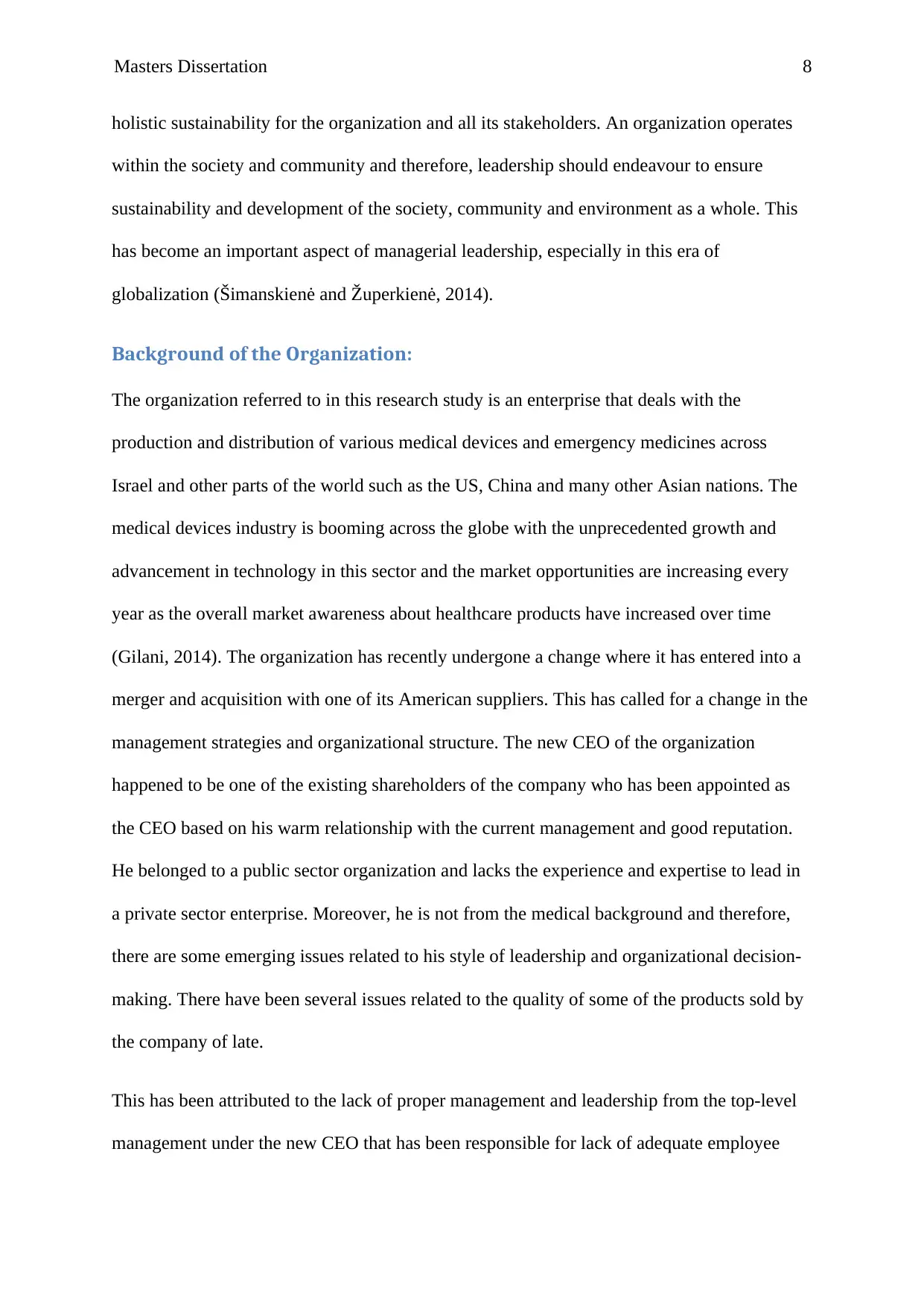
Masters Dissertation 8
holistic sustainability for the organization and all its stakeholders. An organization operates
within the society and community and therefore, leadership should endeavour to ensure
sustainability and development of the society, community and environment as a whole. This
has become an important aspect of managerial leadership, especially in this era of
globalization (Šimanskienė and Župerkienė, 2014).
Background of the Organization:
The organization referred to in this research study is an enterprise that deals with the
production and distribution of various medical devices and emergency medicines across
Israel and other parts of the world such as the US, China and many other Asian nations. The
medical devices industry is booming across the globe with the unprecedented growth and
advancement in technology in this sector and the market opportunities are increasing every
year as the overall market awareness about healthcare products have increased over time
(Gilani, 2014). The organization has recently undergone a change where it has entered into a
merger and acquisition with one of its American suppliers. This has called for a change in the
management strategies and organizational structure. The new CEO of the organization
happened to be one of the existing shareholders of the company who has been appointed as
the CEO based on his warm relationship with the current management and good reputation.
He belonged to a public sector organization and lacks the experience and expertise to lead in
a private sector enterprise. Moreover, he is not from the medical background and therefore,
there are some emerging issues related to his style of leadership and organizational decision-
making. There have been several issues related to the quality of some of the products sold by
the company of late.
This has been attributed to the lack of proper management and leadership from the top-level
management under the new CEO that has been responsible for lack of adequate employee
holistic sustainability for the organization and all its stakeholders. An organization operates
within the society and community and therefore, leadership should endeavour to ensure
sustainability and development of the society, community and environment as a whole. This
has become an important aspect of managerial leadership, especially in this era of
globalization (Šimanskienė and Župerkienė, 2014).
Background of the Organization:
The organization referred to in this research study is an enterprise that deals with the
production and distribution of various medical devices and emergency medicines across
Israel and other parts of the world such as the US, China and many other Asian nations. The
medical devices industry is booming across the globe with the unprecedented growth and
advancement in technology in this sector and the market opportunities are increasing every
year as the overall market awareness about healthcare products have increased over time
(Gilani, 2014). The organization has recently undergone a change where it has entered into a
merger and acquisition with one of its American suppliers. This has called for a change in the
management strategies and organizational structure. The new CEO of the organization
happened to be one of the existing shareholders of the company who has been appointed as
the CEO based on his warm relationship with the current management and good reputation.
He belonged to a public sector organization and lacks the experience and expertise to lead in
a private sector enterprise. Moreover, he is not from the medical background and therefore,
there are some emerging issues related to his style of leadership and organizational decision-
making. There have been several issues related to the quality of some of the products sold by
the company of late.
This has been attributed to the lack of proper management and leadership from the top-level
management under the new CEO that has been responsible for lack of adequate employee
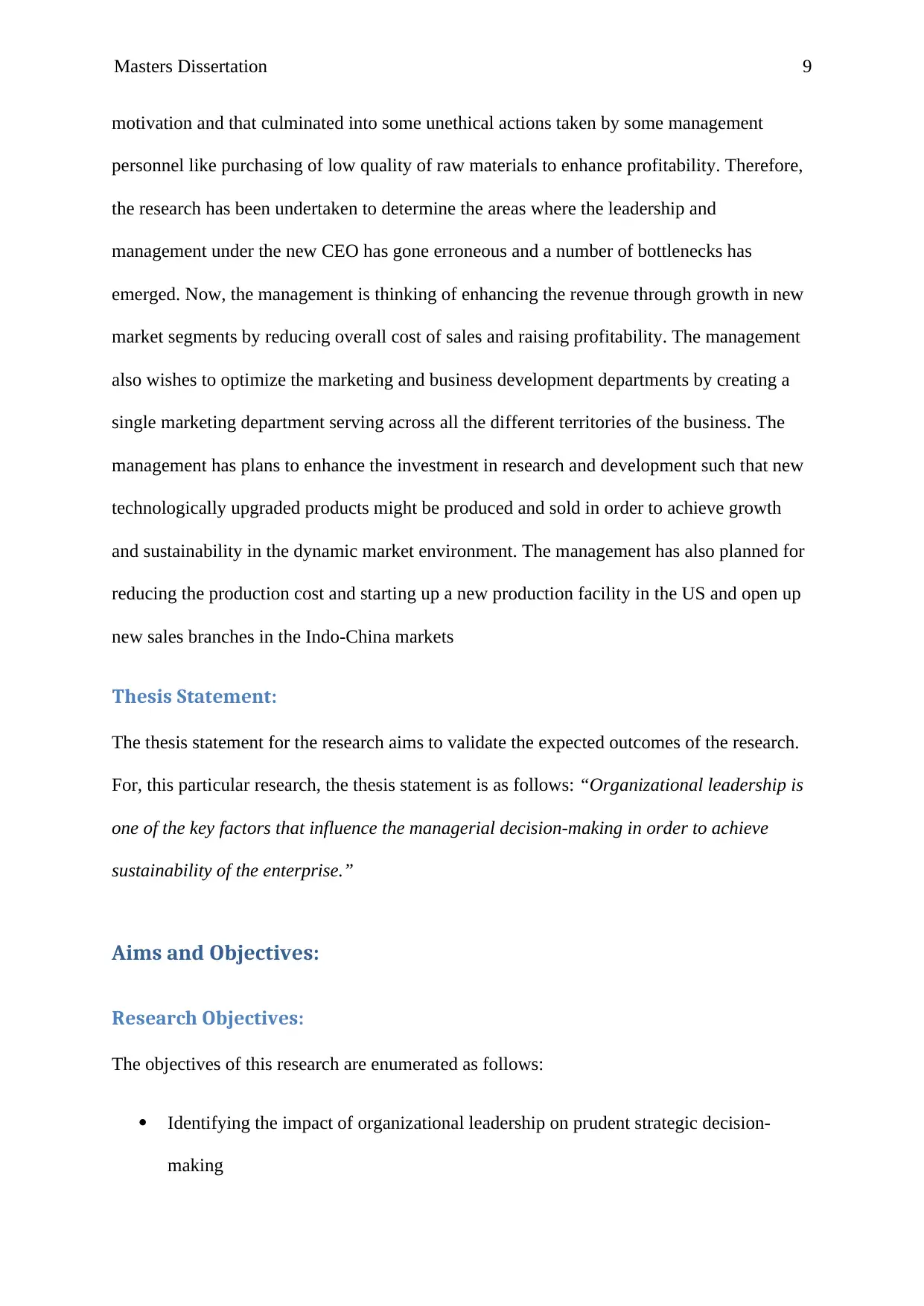
Masters Dissertation 9
motivation and that culminated into some unethical actions taken by some management
personnel like purchasing of low quality of raw materials to enhance profitability. Therefore,
the research has been undertaken to determine the areas where the leadership and
management under the new CEO has gone erroneous and a number of bottlenecks has
emerged. Now, the management is thinking of enhancing the revenue through growth in new
market segments by reducing overall cost of sales and raising profitability. The management
also wishes to optimize the marketing and business development departments by creating a
single marketing department serving across all the different territories of the business. The
management has plans to enhance the investment in research and development such that new
technologically upgraded products might be produced and sold in order to achieve growth
and sustainability in the dynamic market environment. The management has also planned for
reducing the production cost and starting up a new production facility in the US and open up
new sales branches in the Indo-China markets
Thesis Statement:
The thesis statement for the research aims to validate the expected outcomes of the research.
For, this particular research, the thesis statement is as follows: “Organizational leadership is
one of the key factors that influence the managerial decision-making in order to achieve
sustainability of the enterprise.”
Aims and Objectives:
Research Objectives:
The objectives of this research are enumerated as follows:
Identifying the impact of organizational leadership on prudent strategic decision-
making
motivation and that culminated into some unethical actions taken by some management
personnel like purchasing of low quality of raw materials to enhance profitability. Therefore,
the research has been undertaken to determine the areas where the leadership and
management under the new CEO has gone erroneous and a number of bottlenecks has
emerged. Now, the management is thinking of enhancing the revenue through growth in new
market segments by reducing overall cost of sales and raising profitability. The management
also wishes to optimize the marketing and business development departments by creating a
single marketing department serving across all the different territories of the business. The
management has plans to enhance the investment in research and development such that new
technologically upgraded products might be produced and sold in order to achieve growth
and sustainability in the dynamic market environment. The management has also planned for
reducing the production cost and starting up a new production facility in the US and open up
new sales branches in the Indo-China markets
Thesis Statement:
The thesis statement for the research aims to validate the expected outcomes of the research.
For, this particular research, the thesis statement is as follows: “Organizational leadership is
one of the key factors that influence the managerial decision-making in order to achieve
sustainability of the enterprise.”
Aims and Objectives:
Research Objectives:
The objectives of this research are enumerated as follows:
Identifying the impact of organizational leadership on prudent strategic decision-
making
Paraphrase This Document
Need a fresh take? Get an instant paraphrase of this document with our AI Paraphraser
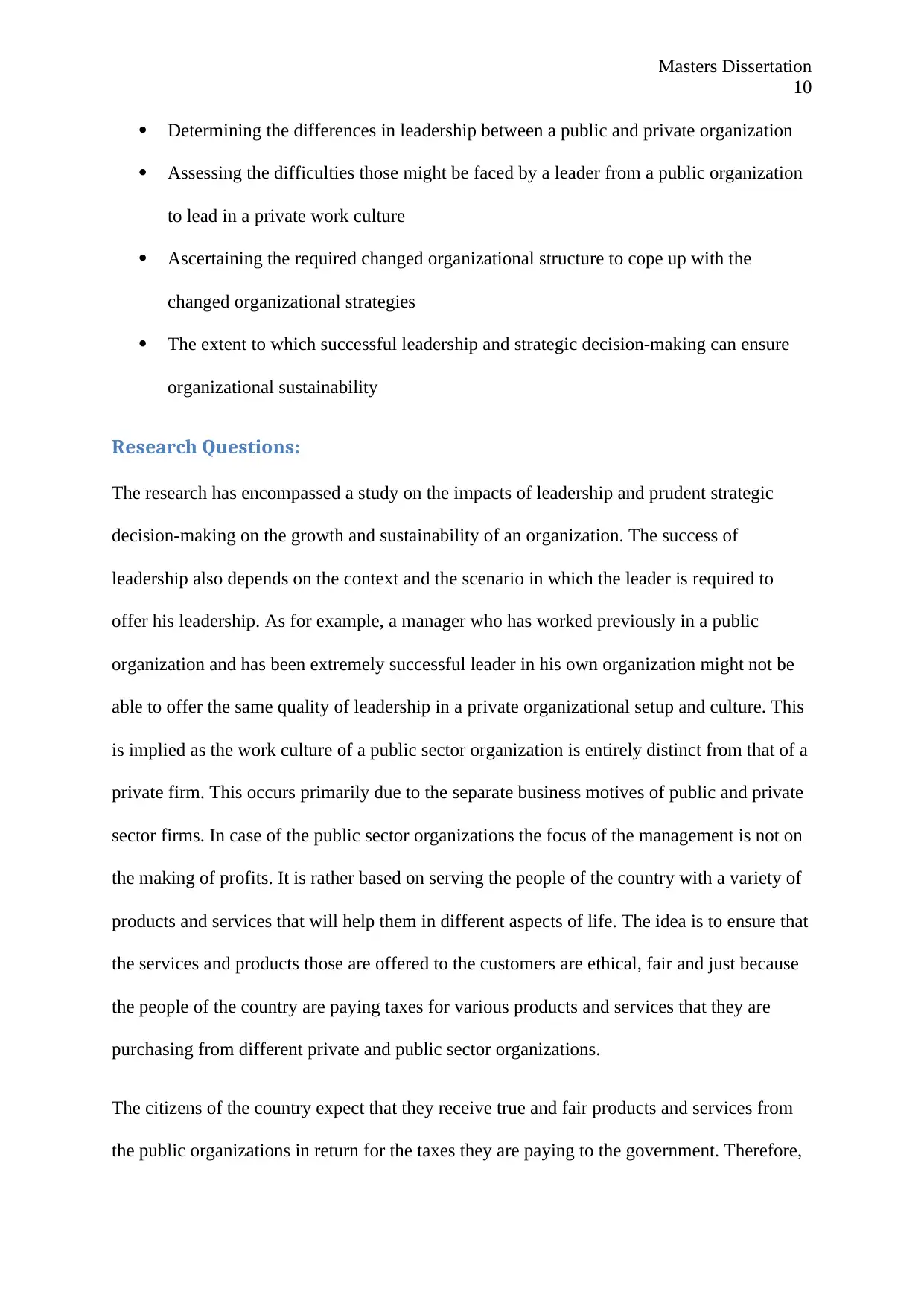
Masters Dissertation
10
Determining the differences in leadership between a public and private organization
Assessing the difficulties those might be faced by a leader from a public organization
to lead in a private work culture
Ascertaining the required changed organizational structure to cope up with the
changed organizational strategies
The extent to which successful leadership and strategic decision-making can ensure
organizational sustainability
Research Questions:
The research has encompassed a study on the impacts of leadership and prudent strategic
decision-making on the growth and sustainability of an organization. The success of
leadership also depends on the context and the scenario in which the leader is required to
offer his leadership. As for example, a manager who has worked previously in a public
organization and has been extremely successful leader in his own organization might not be
able to offer the same quality of leadership in a private organizational setup and culture. This
is implied as the work culture of a public sector organization is entirely distinct from that of a
private firm. This occurs primarily due to the separate business motives of public and private
sector firms. In case of the public sector organizations the focus of the management is not on
the making of profits. It is rather based on serving the people of the country with a variety of
products and services that will help them in different aspects of life. The idea is to ensure that
the services and products those are offered to the customers are ethical, fair and just because
the people of the country are paying taxes for various products and services that they are
purchasing from different private and public sector organizations.
The citizens of the country expect that they receive true and fair products and services from
the public organizations in return for the taxes they are paying to the government. Therefore,
10
Determining the differences in leadership between a public and private organization
Assessing the difficulties those might be faced by a leader from a public organization
to lead in a private work culture
Ascertaining the required changed organizational structure to cope up with the
changed organizational strategies
The extent to which successful leadership and strategic decision-making can ensure
organizational sustainability
Research Questions:
The research has encompassed a study on the impacts of leadership and prudent strategic
decision-making on the growth and sustainability of an organization. The success of
leadership also depends on the context and the scenario in which the leader is required to
offer his leadership. As for example, a manager who has worked previously in a public
organization and has been extremely successful leader in his own organization might not be
able to offer the same quality of leadership in a private organizational setup and culture. This
is implied as the work culture of a public sector organization is entirely distinct from that of a
private firm. This occurs primarily due to the separate business motives of public and private
sector firms. In case of the public sector organizations the focus of the management is not on
the making of profits. It is rather based on serving the people of the country with a variety of
products and services that will help them in different aspects of life. The idea is to ensure that
the services and products those are offered to the customers are ethical, fair and just because
the people of the country are paying taxes for various products and services that they are
purchasing from different private and public sector organizations.
The citizens of the country expect that they receive true and fair products and services from
the public organizations in return for the taxes they are paying to the government. Therefore,
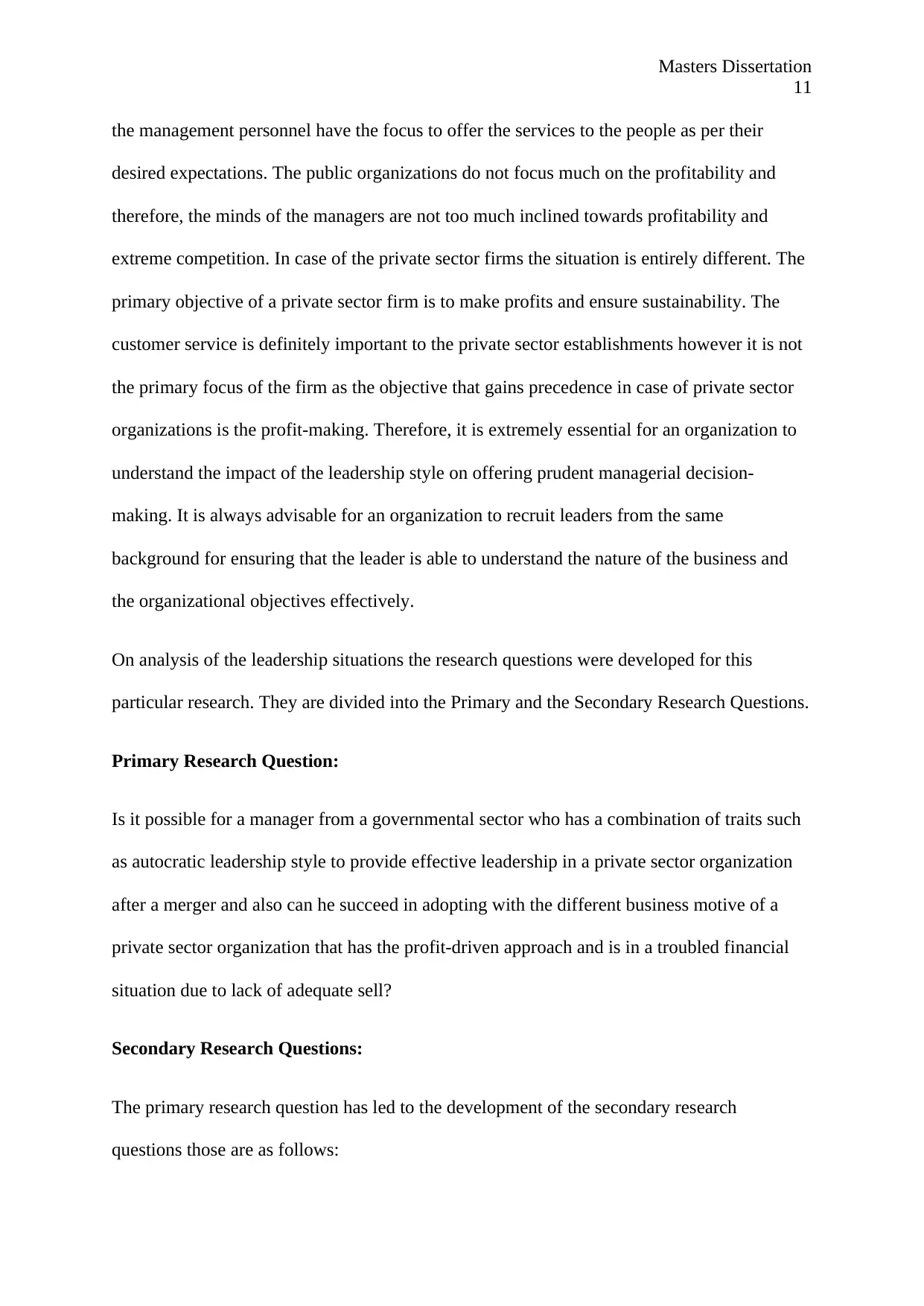
Masters Dissertation
11
the management personnel have the focus to offer the services to the people as per their
desired expectations. The public organizations do not focus much on the profitability and
therefore, the minds of the managers are not too much inclined towards profitability and
extreme competition. In case of the private sector firms the situation is entirely different. The
primary objective of a private sector firm is to make profits and ensure sustainability. The
customer service is definitely important to the private sector establishments however it is not
the primary focus of the firm as the objective that gains precedence in case of private sector
organizations is the profit-making. Therefore, it is extremely essential for an organization to
understand the impact of the leadership style on offering prudent managerial decision-
making. It is always advisable for an organization to recruit leaders from the same
background for ensuring that the leader is able to understand the nature of the business and
the organizational objectives effectively.
On analysis of the leadership situations the research questions were developed for this
particular research. They are divided into the Primary and the Secondary Research Questions.
Primary Research Question:
Is it possible for a manager from a governmental sector who has a combination of traits such
as autocratic leadership style to provide effective leadership in a private sector organization
after a merger and also can he succeed in adopting with the different business motive of a
private sector organization that has the profit-driven approach and is in a troubled financial
situation due to lack of adequate sell?
Secondary Research Questions:
The primary research question has led to the development of the secondary research
questions those are as follows:
11
the management personnel have the focus to offer the services to the people as per their
desired expectations. The public organizations do not focus much on the profitability and
therefore, the minds of the managers are not too much inclined towards profitability and
extreme competition. In case of the private sector firms the situation is entirely different. The
primary objective of a private sector firm is to make profits and ensure sustainability. The
customer service is definitely important to the private sector establishments however it is not
the primary focus of the firm as the objective that gains precedence in case of private sector
organizations is the profit-making. Therefore, it is extremely essential for an organization to
understand the impact of the leadership style on offering prudent managerial decision-
making. It is always advisable for an organization to recruit leaders from the same
background for ensuring that the leader is able to understand the nature of the business and
the organizational objectives effectively.
On analysis of the leadership situations the research questions were developed for this
particular research. They are divided into the Primary and the Secondary Research Questions.
Primary Research Question:
Is it possible for a manager from a governmental sector who has a combination of traits such
as autocratic leadership style to provide effective leadership in a private sector organization
after a merger and also can he succeed in adopting with the different business motive of a
private sector organization that has the profit-driven approach and is in a troubled financial
situation due to lack of adequate sell?
Secondary Research Questions:
The primary research question has led to the development of the secondary research
questions those are as follows:
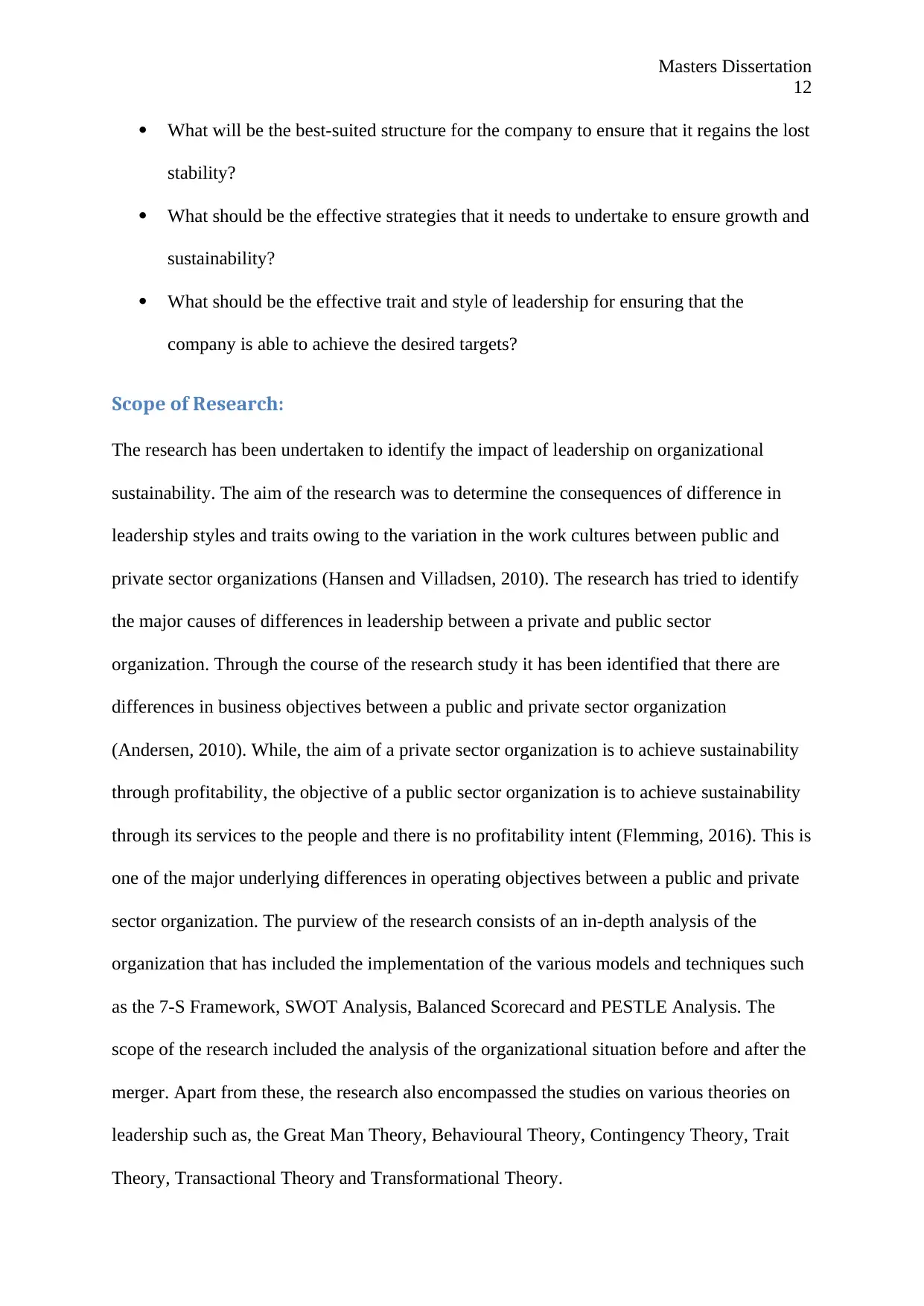
Masters Dissertation
12
What will be the best-suited structure for the company to ensure that it regains the lost
stability?
What should be the effective strategies that it needs to undertake to ensure growth and
sustainability?
What should be the effective trait and style of leadership for ensuring that the
company is able to achieve the desired targets?
Scope of Research:
The research has been undertaken to identify the impact of leadership on organizational
sustainability. The aim of the research was to determine the consequences of difference in
leadership styles and traits owing to the variation in the work cultures between public and
private sector organizations (Hansen and Villadsen, 2010). The research has tried to identify
the major causes of differences in leadership between a private and public sector
organization. Through the course of the research study it has been identified that there are
differences in business objectives between a public and private sector organization
(Andersen, 2010). While, the aim of a private sector organization is to achieve sustainability
through profitability, the objective of a public sector organization is to achieve sustainability
through its services to the people and there is no profitability intent (Flemming, 2016). This is
one of the major underlying differences in operating objectives between a public and private
sector organization. The purview of the research consists of an in-depth analysis of the
organization that has included the implementation of the various models and techniques such
as the 7-S Framework, SWOT Analysis, Balanced Scorecard and PESTLE Analysis. The
scope of the research included the analysis of the organizational situation before and after the
merger. Apart from these, the research also encompassed the studies on various theories on
leadership such as, the Great Man Theory, Behavioural Theory, Contingency Theory, Trait
Theory, Transactional Theory and Transformational Theory.
12
What will be the best-suited structure for the company to ensure that it regains the lost
stability?
What should be the effective strategies that it needs to undertake to ensure growth and
sustainability?
What should be the effective trait and style of leadership for ensuring that the
company is able to achieve the desired targets?
Scope of Research:
The research has been undertaken to identify the impact of leadership on organizational
sustainability. The aim of the research was to determine the consequences of difference in
leadership styles and traits owing to the variation in the work cultures between public and
private sector organizations (Hansen and Villadsen, 2010). The research has tried to identify
the major causes of differences in leadership between a private and public sector
organization. Through the course of the research study it has been identified that there are
differences in business objectives between a public and private sector organization
(Andersen, 2010). While, the aim of a private sector organization is to achieve sustainability
through profitability, the objective of a public sector organization is to achieve sustainability
through its services to the people and there is no profitability intent (Flemming, 2016). This is
one of the major underlying differences in operating objectives between a public and private
sector organization. The purview of the research consists of an in-depth analysis of the
organization that has included the implementation of the various models and techniques such
as the 7-S Framework, SWOT Analysis, Balanced Scorecard and PESTLE Analysis. The
scope of the research included the analysis of the organizational situation before and after the
merger. Apart from these, the research also encompassed the studies on various theories on
leadership such as, the Great Man Theory, Behavioural Theory, Contingency Theory, Trait
Theory, Transactional Theory and Transformational Theory.
Secure Best Marks with AI Grader
Need help grading? Try our AI Grader for instant feedback on your assignments.
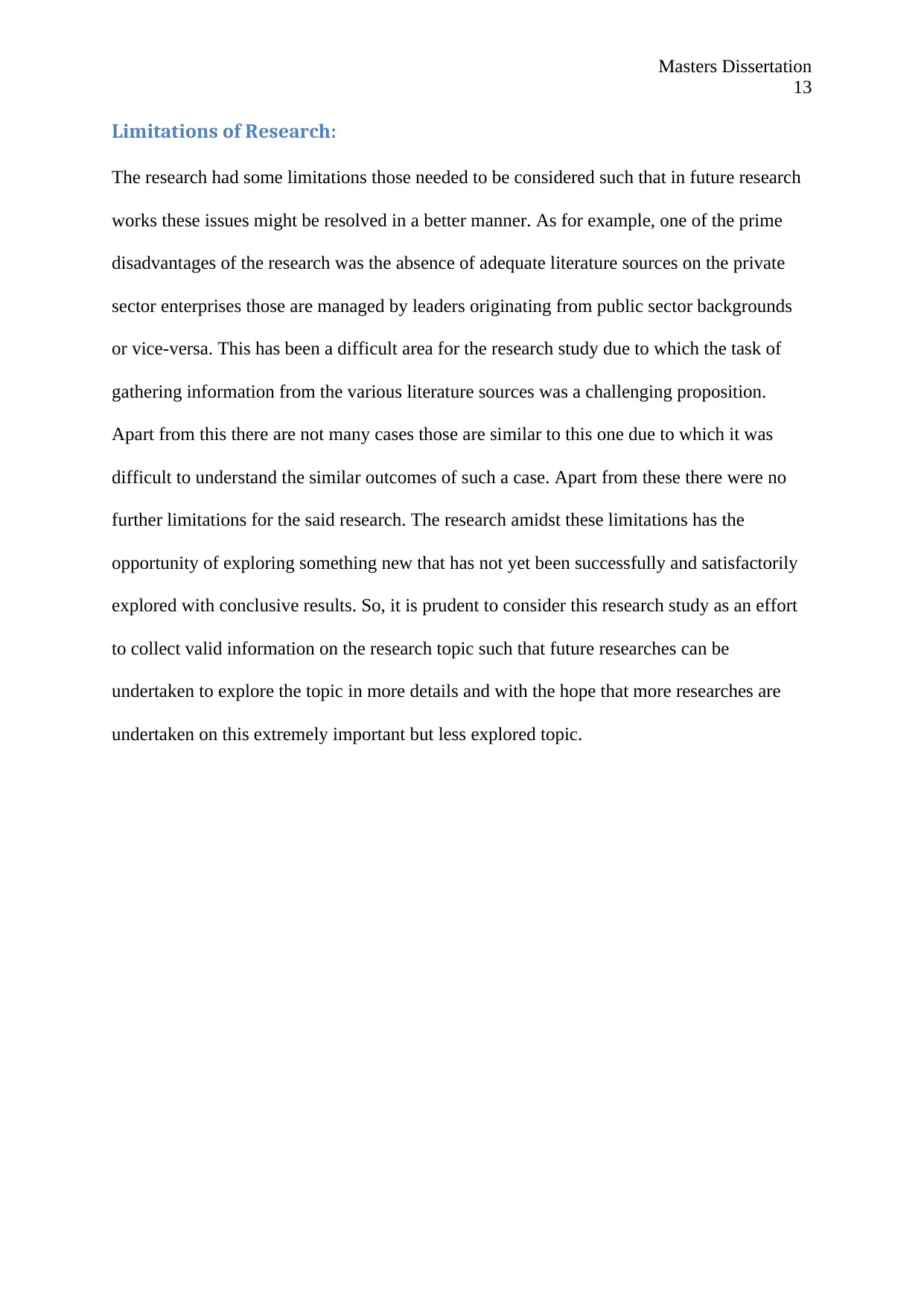
Masters Dissertation
13
Limitations of Research:
The research had some limitations those needed to be considered such that in future research
works these issues might be resolved in a better manner. As for example, one of the prime
disadvantages of the research was the absence of adequate literature sources on the private
sector enterprises those are managed by leaders originating from public sector backgrounds
or vice-versa. This has been a difficult area for the research study due to which the task of
gathering information from the various literature sources was a challenging proposition.
Apart from this there are not many cases those are similar to this one due to which it was
difficult to understand the similar outcomes of such a case. Apart from these there were no
further limitations for the said research. The research amidst these limitations has the
opportunity of exploring something new that has not yet been successfully and satisfactorily
explored with conclusive results. So, it is prudent to consider this research study as an effort
to collect valid information on the research topic such that future researches can be
undertaken to explore the topic in more details and with the hope that more researches are
undertaken on this extremely important but less explored topic.
13
Limitations of Research:
The research had some limitations those needed to be considered such that in future research
works these issues might be resolved in a better manner. As for example, one of the prime
disadvantages of the research was the absence of adequate literature sources on the private
sector enterprises those are managed by leaders originating from public sector backgrounds
or vice-versa. This has been a difficult area for the research study due to which the task of
gathering information from the various literature sources was a challenging proposition.
Apart from this there are not many cases those are similar to this one due to which it was
difficult to understand the similar outcomes of such a case. Apart from these there were no
further limitations for the said research. The research amidst these limitations has the
opportunity of exploring something new that has not yet been successfully and satisfactorily
explored with conclusive results. So, it is prudent to consider this research study as an effort
to collect valid information on the research topic such that future researches can be
undertaken to explore the topic in more details and with the hope that more researches are
undertaken on this extremely important but less explored topic.
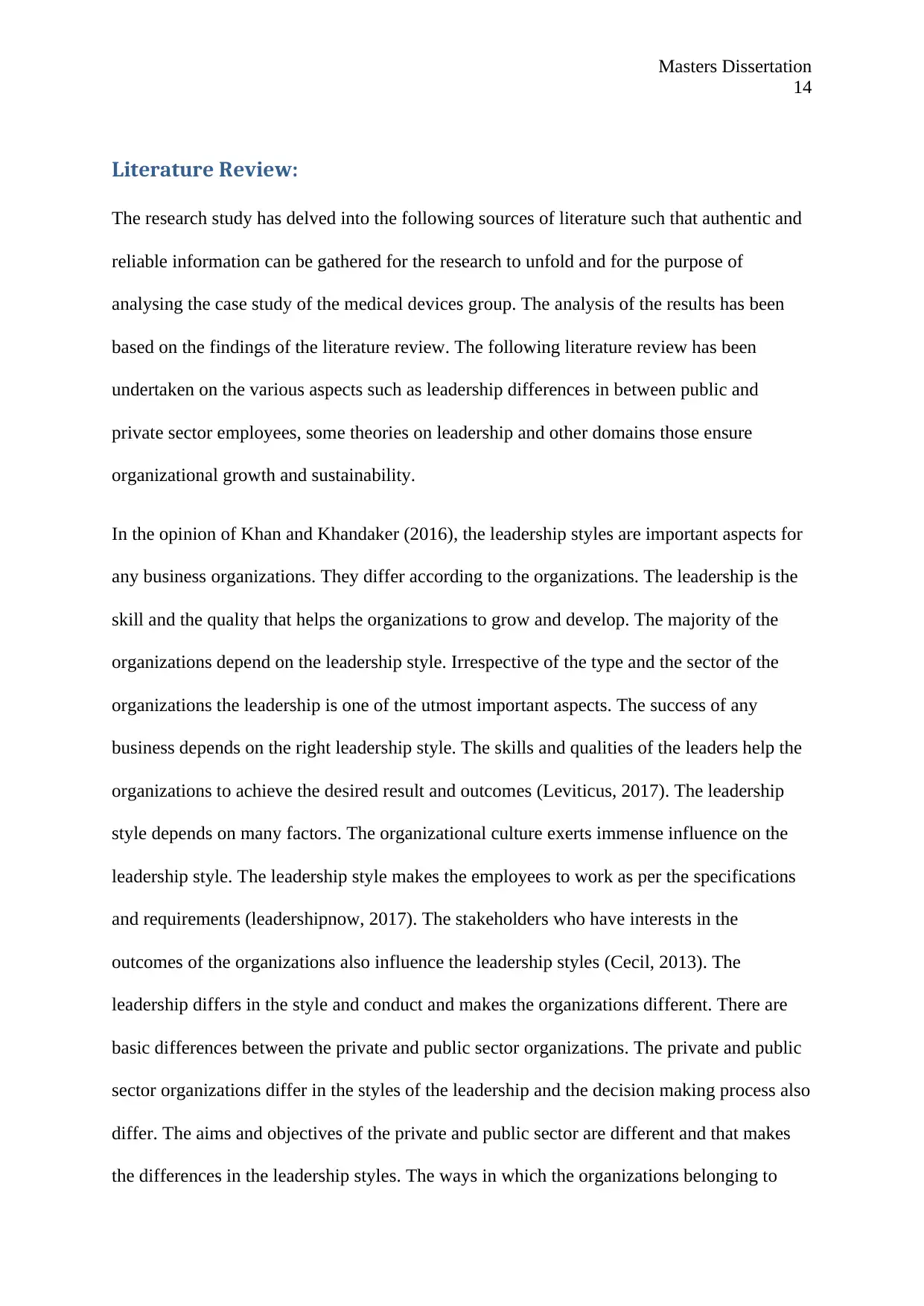
Masters Dissertation
14
Literature Review:
The research study has delved into the following sources of literature such that authentic and
reliable information can be gathered for the research to unfold and for the purpose of
analysing the case study of the medical devices group. The analysis of the results has been
based on the findings of the literature review. The following literature review has been
undertaken on the various aspects such as leadership differences in between public and
private sector employees, some theories on leadership and other domains those ensure
organizational growth and sustainability.
In the opinion of Khan and Khandaker (2016), the leadership styles are important aspects for
any business organizations. They differ according to the organizations. The leadership is the
skill and the quality that helps the organizations to grow and develop. The majority of the
organizations depend on the leadership style. Irrespective of the type and the sector of the
organizations the leadership is one of the utmost important aspects. The success of any
business depends on the right leadership style. The skills and qualities of the leaders help the
organizations to achieve the desired result and outcomes (Leviticus, 2017). The leadership
style depends on many factors. The organizational culture exerts immense influence on the
leadership style. The leadership style makes the employees to work as per the specifications
and requirements (leadershipnow, 2017). The stakeholders who have interests in the
outcomes of the organizations also influence the leadership styles (Cecil, 2013). The
leadership differs in the style and conduct and makes the organizations different. There are
basic differences between the private and public sector organizations. The private and public
sector organizations differ in the styles of the leadership and the decision making process also
differ. The aims and objectives of the private and public sector are different and that makes
the differences in the leadership styles. The ways in which the organizations belonging to
14
Literature Review:
The research study has delved into the following sources of literature such that authentic and
reliable information can be gathered for the research to unfold and for the purpose of
analysing the case study of the medical devices group. The analysis of the results has been
based on the findings of the literature review. The following literature review has been
undertaken on the various aspects such as leadership differences in between public and
private sector employees, some theories on leadership and other domains those ensure
organizational growth and sustainability.
In the opinion of Khan and Khandaker (2016), the leadership styles are important aspects for
any business organizations. They differ according to the organizations. The leadership is the
skill and the quality that helps the organizations to grow and develop. The majority of the
organizations depend on the leadership style. Irrespective of the type and the sector of the
organizations the leadership is one of the utmost important aspects. The success of any
business depends on the right leadership style. The skills and qualities of the leaders help the
organizations to achieve the desired result and outcomes (Leviticus, 2017). The leadership
style depends on many factors. The organizational culture exerts immense influence on the
leadership style. The leadership style makes the employees to work as per the specifications
and requirements (leadershipnow, 2017). The stakeholders who have interests in the
outcomes of the organizations also influence the leadership styles (Cecil, 2013). The
leadership differs in the style and conduct and makes the organizations different. There are
basic differences between the private and public sector organizations. The private and public
sector organizations differ in the styles of the leadership and the decision making process also
differ. The aims and objectives of the private and public sector are different and that makes
the differences in the leadership styles. The ways in which the organizations belonging to
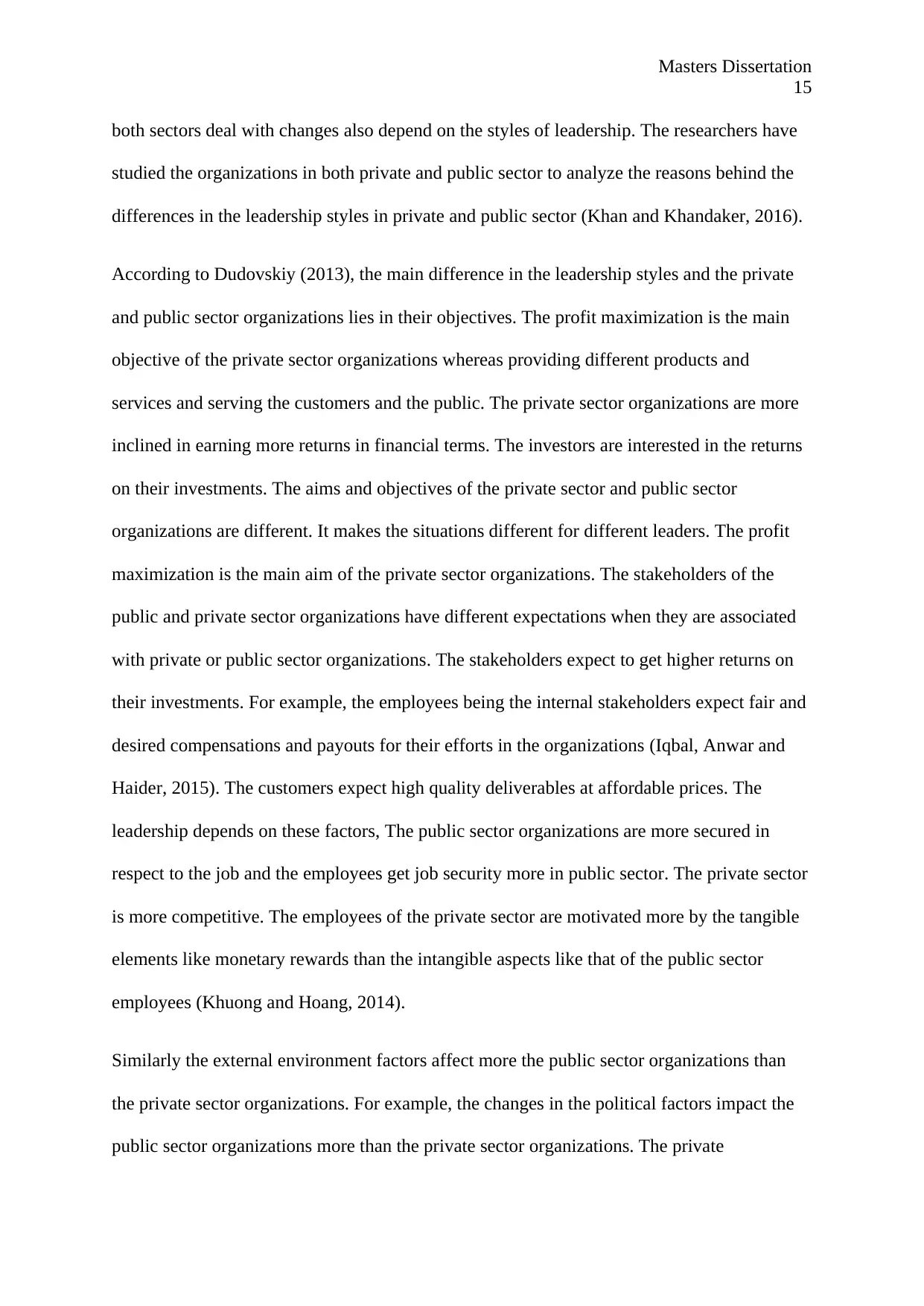
Masters Dissertation
15
both sectors deal with changes also depend on the styles of leadership. The researchers have
studied the organizations in both private and public sector to analyze the reasons behind the
differences in the leadership styles in private and public sector (Khan and Khandaker, 2016).
According to Dudovskiy (2013), the main difference in the leadership styles and the private
and public sector organizations lies in their objectives. The profit maximization is the main
objective of the private sector organizations whereas providing different products and
services and serving the customers and the public. The private sector organizations are more
inclined in earning more returns in financial terms. The investors are interested in the returns
on their investments. The aims and objectives of the private sector and public sector
organizations are different. It makes the situations different for different leaders. The profit
maximization is the main aim of the private sector organizations. The stakeholders of the
public and private sector organizations have different expectations when they are associated
with private or public sector organizations. The stakeholders expect to get higher returns on
their investments. For example, the employees being the internal stakeholders expect fair and
desired compensations and payouts for their efforts in the organizations (Iqbal, Anwar and
Haider, 2015). The customers expect high quality deliverables at affordable prices. The
leadership depends on these factors, The public sector organizations are more secured in
respect to the job and the employees get job security more in public sector. The private sector
is more competitive. The employees of the private sector are motivated more by the tangible
elements like monetary rewards than the intangible aspects like that of the public sector
employees (Khuong and Hoang, 2014).
Similarly the external environment factors affect more the public sector organizations than
the private sector organizations. For example, the changes in the political factors impact the
public sector organizations more than the private sector organizations. The private
15
both sectors deal with changes also depend on the styles of leadership. The researchers have
studied the organizations in both private and public sector to analyze the reasons behind the
differences in the leadership styles in private and public sector (Khan and Khandaker, 2016).
According to Dudovskiy (2013), the main difference in the leadership styles and the private
and public sector organizations lies in their objectives. The profit maximization is the main
objective of the private sector organizations whereas providing different products and
services and serving the customers and the public. The private sector organizations are more
inclined in earning more returns in financial terms. The investors are interested in the returns
on their investments. The aims and objectives of the private sector and public sector
organizations are different. It makes the situations different for different leaders. The profit
maximization is the main aim of the private sector organizations. The stakeholders of the
public and private sector organizations have different expectations when they are associated
with private or public sector organizations. The stakeholders expect to get higher returns on
their investments. For example, the employees being the internal stakeholders expect fair and
desired compensations and payouts for their efforts in the organizations (Iqbal, Anwar and
Haider, 2015). The customers expect high quality deliverables at affordable prices. The
leadership depends on these factors, The public sector organizations are more secured in
respect to the job and the employees get job security more in public sector. The private sector
is more competitive. The employees of the private sector are motivated more by the tangible
elements like monetary rewards than the intangible aspects like that of the public sector
employees (Khuong and Hoang, 2014).
Similarly the external environment factors affect more the public sector organizations than
the private sector organizations. For example, the changes in the political factors impact the
public sector organizations more than the private sector organizations. The private
Paraphrase This Document
Need a fresh take? Get an instant paraphrase of this document with our AI Paraphraser

Masters Dissertation
16
organizations become bound to react to the changes in the political factors. The changes in
the economic factors affect the private organizations more than the public sector. The
economic changes impact the decision-making process and the other related issues. So the
leadership differences take place because of these aspects (Dudovskiy, 2013).
According to Andersen (2010), there are certain differences in behaviors of the managers of
the private and public sector organizations. There have been studies on the behavioral
differences of the managers and the differences in the leadership styles in private and public
sector organizations. It has been observed that the transformational leadership styles are more
found in case of public sector organizations (Reynolds, 2015). The leadership style that the
researchers have observed in this case is more inclined towards the learning and sharing of
knowledge so as to transform the employees to be competent and skilled for the particular
jobs profiles. The leadership style that is predominant in the private sector organizations is
more inclined towards relations. The managers of the public sector are influenced and
motivated by the power and they are intuitive in making decisions. The public sector
managers are also intuitive while making important decisions but the leadership style is more
directed towards the changes (Bolden, 2005 ). The change oriented style of leadership is more
profound in the public sector organizations. They are more interested in the achievements and
that motivate them the most. From the analysis it can be said that the leadership styles in
public and private sectors are different in respect to the motivations, behaviors of the
managers and decision-making. The organizational differences also contribute to the changes
in the leadership styles and the behaviors of the managers of the public and private sector
organizations (Andersen, 2010).
In the opinion of Hansen and Villadsen (2010), the public sector leaders and managers use
more participative leadership styles. On the other hand, the private sector leaders are more
16
organizations become bound to react to the changes in the political factors. The changes in
the economic factors affect the private organizations more than the public sector. The
economic changes impact the decision-making process and the other related issues. So the
leadership differences take place because of these aspects (Dudovskiy, 2013).
According to Andersen (2010), there are certain differences in behaviors of the managers of
the private and public sector organizations. There have been studies on the behavioral
differences of the managers and the differences in the leadership styles in private and public
sector organizations. It has been observed that the transformational leadership styles are more
found in case of public sector organizations (Reynolds, 2015). The leadership style that the
researchers have observed in this case is more inclined towards the learning and sharing of
knowledge so as to transform the employees to be competent and skilled for the particular
jobs profiles. The leadership style that is predominant in the private sector organizations is
more inclined towards relations. The managers of the public sector are influenced and
motivated by the power and they are intuitive in making decisions. The public sector
managers are also intuitive while making important decisions but the leadership style is more
directed towards the changes (Bolden, 2005 ). The change oriented style of leadership is more
profound in the public sector organizations. They are more interested in the achievements and
that motivate them the most. From the analysis it can be said that the leadership styles in
public and private sectors are different in respect to the motivations, behaviors of the
managers and decision-making. The organizational differences also contribute to the changes
in the leadership styles and the behaviors of the managers of the public and private sector
organizations (Andersen, 2010).
In the opinion of Hansen and Villadsen (2010), the public sector leaders and managers use
more participative leadership styles. On the other hand, the private sector leaders are more
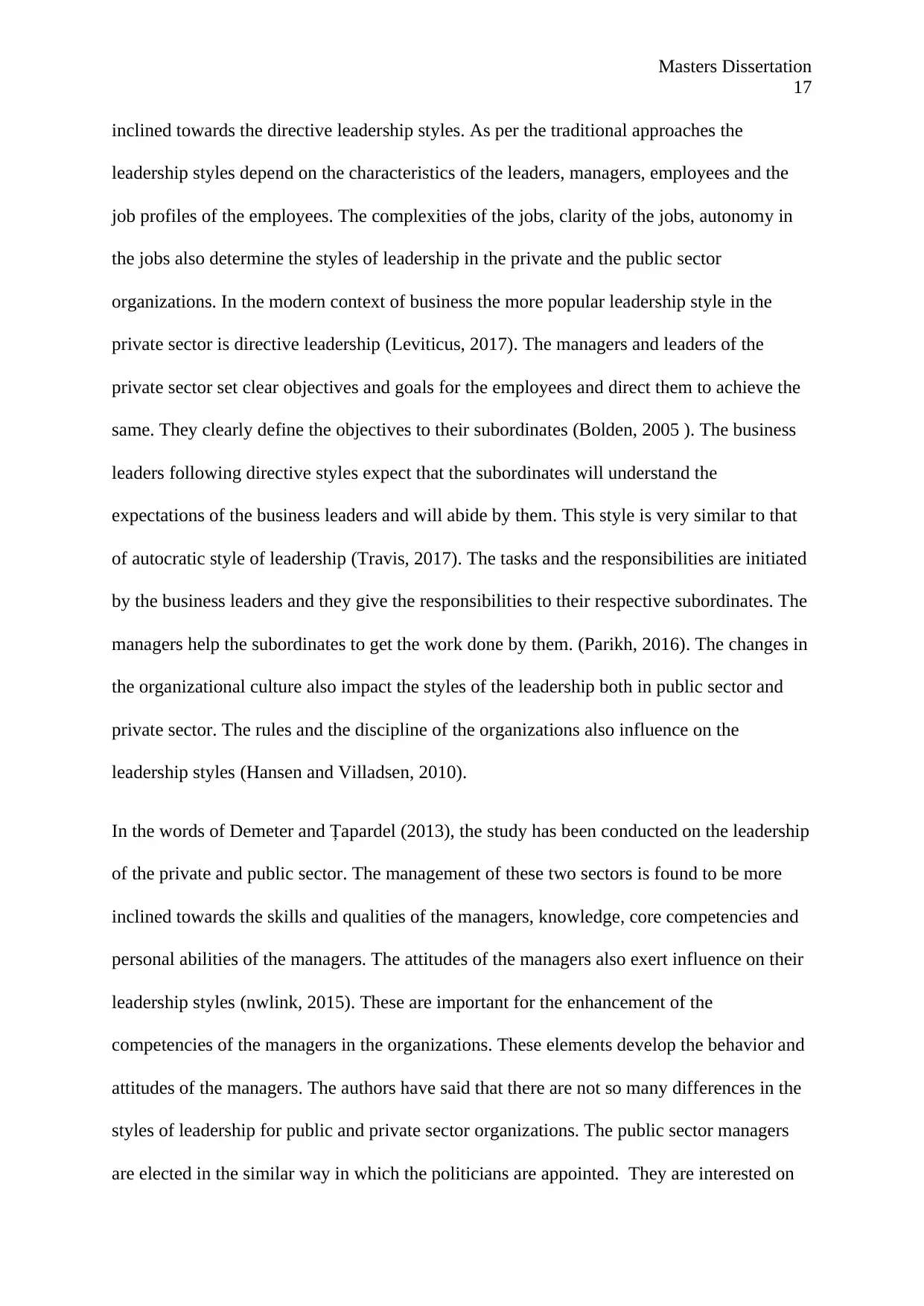
Masters Dissertation
17
inclined towards the directive leadership styles. As per the traditional approaches the
leadership styles depend on the characteristics of the leaders, managers, employees and the
job profiles of the employees. The complexities of the jobs, clarity of the jobs, autonomy in
the jobs also determine the styles of leadership in the private and the public sector
organizations. In the modern context of business the more popular leadership style in the
private sector is directive leadership (Leviticus, 2017). The managers and leaders of the
private sector set clear objectives and goals for the employees and direct them to achieve the
same. They clearly define the objectives to their subordinates (Bolden, 2005 ). The business
leaders following directive styles expect that the subordinates will understand the
expectations of the business leaders and will abide by them. This style is very similar to that
of autocratic style of leadership (Travis, 2017). The tasks and the responsibilities are initiated
by the business leaders and they give the responsibilities to their respective subordinates. The
managers help the subordinates to get the work done by them. (Parikh, 2016). The changes in
the organizational culture also impact the styles of the leadership both in public sector and
private sector. The rules and the discipline of the organizations also influence on the
leadership styles (Hansen and Villadsen, 2010).
In the words of Demeter and Țapardel (2013), the study has been conducted on the leadership
of the private and public sector. The management of these two sectors is found to be more
inclined towards the skills and qualities of the managers, knowledge, core competencies and
personal abilities of the managers. The attitudes of the managers also exert influence on their
leadership styles (nwlink, 2015). These are important for the enhancement of the
competencies of the managers in the organizations. These elements develop the behavior and
attitudes of the managers. The authors have said that there are not so many differences in the
styles of leadership for public and private sector organizations. The public sector managers
are elected in the similar way in which the politicians are appointed. They are interested on
17
inclined towards the directive leadership styles. As per the traditional approaches the
leadership styles depend on the characteristics of the leaders, managers, employees and the
job profiles of the employees. The complexities of the jobs, clarity of the jobs, autonomy in
the jobs also determine the styles of leadership in the private and the public sector
organizations. In the modern context of business the more popular leadership style in the
private sector is directive leadership (Leviticus, 2017). The managers and leaders of the
private sector set clear objectives and goals for the employees and direct them to achieve the
same. They clearly define the objectives to their subordinates (Bolden, 2005 ). The business
leaders following directive styles expect that the subordinates will understand the
expectations of the business leaders and will abide by them. This style is very similar to that
of autocratic style of leadership (Travis, 2017). The tasks and the responsibilities are initiated
by the business leaders and they give the responsibilities to their respective subordinates. The
managers help the subordinates to get the work done by them. (Parikh, 2016). The changes in
the organizational culture also impact the styles of the leadership both in public sector and
private sector. The rules and the discipline of the organizations also influence on the
leadership styles (Hansen and Villadsen, 2010).
In the words of Demeter and Țapardel (2013), the study has been conducted on the leadership
of the private and public sector. The management of these two sectors is found to be more
inclined towards the skills and qualities of the managers, knowledge, core competencies and
personal abilities of the managers. The attitudes of the managers also exert influence on their
leadership styles (nwlink, 2015). These are important for the enhancement of the
competencies of the managers in the organizations. These elements develop the behavior and
attitudes of the managers. The authors have said that there are not so many differences in the
styles of leadership for public and private sector organizations. The public sector managers
are elected in the similar way in which the politicians are appointed. They are interested on
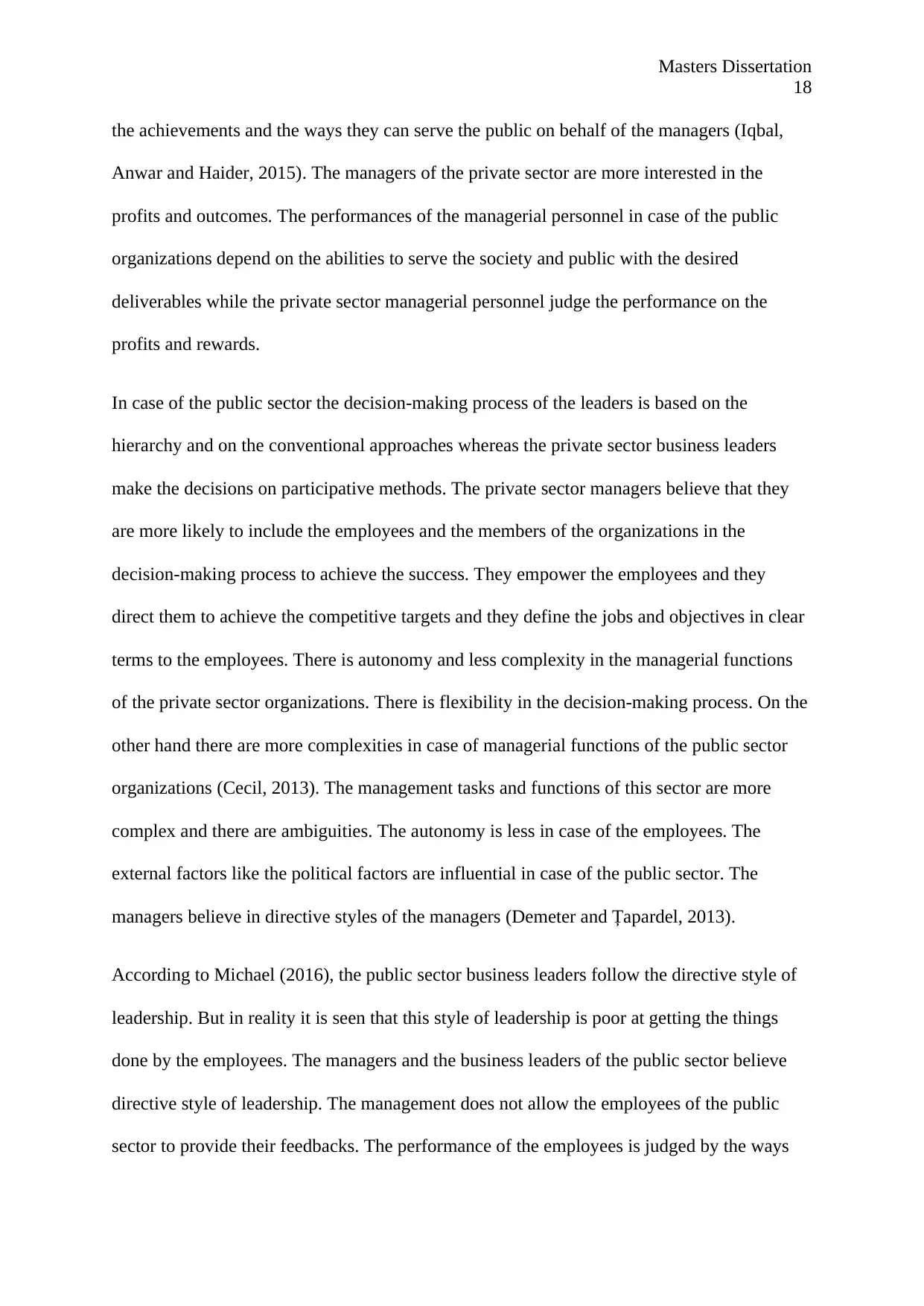
Masters Dissertation
18
the achievements and the ways they can serve the public on behalf of the managers (Iqbal,
Anwar and Haider, 2015). The managers of the private sector are more interested in the
profits and outcomes. The performances of the managerial personnel in case of the public
organizations depend on the abilities to serve the society and public with the desired
deliverables while the private sector managerial personnel judge the performance on the
profits and rewards.
In case of the public sector the decision-making process of the leaders is based on the
hierarchy and on the conventional approaches whereas the private sector business leaders
make the decisions on participative methods. The private sector managers believe that they
are more likely to include the employees and the members of the organizations in the
decision-making process to achieve the success. They empower the employees and they
direct them to achieve the competitive targets and they define the jobs and objectives in clear
terms to the employees. There is autonomy and less complexity in the managerial functions
of the private sector organizations. There is flexibility in the decision-making process. On the
other hand there are more complexities in case of managerial functions of the public sector
organizations (Cecil, 2013). The management tasks and functions of this sector are more
complex and there are ambiguities. The autonomy is less in case of the employees. The
external factors like the political factors are influential in case of the public sector. The
managers believe in directive styles of the managers (Demeter and Țapardel, 2013).
According to Michael (2016), the public sector business leaders follow the directive style of
leadership. But in reality it is seen that this style of leadership is poor at getting the things
done by the employees. The managers and the business leaders of the public sector believe
directive style of leadership. The management does not allow the employees of the public
sector to provide their feedbacks. The performance of the employees is judged by the ways
18
the achievements and the ways they can serve the public on behalf of the managers (Iqbal,
Anwar and Haider, 2015). The managers of the private sector are more interested in the
profits and outcomes. The performances of the managerial personnel in case of the public
organizations depend on the abilities to serve the society and public with the desired
deliverables while the private sector managerial personnel judge the performance on the
profits and rewards.
In case of the public sector the decision-making process of the leaders is based on the
hierarchy and on the conventional approaches whereas the private sector business leaders
make the decisions on participative methods. The private sector managers believe that they
are more likely to include the employees and the members of the organizations in the
decision-making process to achieve the success. They empower the employees and they
direct them to achieve the competitive targets and they define the jobs and objectives in clear
terms to the employees. There is autonomy and less complexity in the managerial functions
of the private sector organizations. There is flexibility in the decision-making process. On the
other hand there are more complexities in case of managerial functions of the public sector
organizations (Cecil, 2013). The management tasks and functions of this sector are more
complex and there are ambiguities. The autonomy is less in case of the employees. The
external factors like the political factors are influential in case of the public sector. The
managers believe in directive styles of the managers (Demeter and Țapardel, 2013).
According to Michael (2016), the public sector business leaders follow the directive style of
leadership. But in reality it is seen that this style of leadership is poor at getting the things
done by the employees. The managers and the business leaders of the public sector believe
directive style of leadership. The management does not allow the employees of the public
sector to provide their feedbacks. The performance of the employees is judged by the ways
Secure Best Marks with AI Grader
Need help grading? Try our AI Grader for instant feedback on your assignments.

Masters Dissertation
19
through which they complete their assigned jobs. The employees in case of public sector are
found to be unfulfilled and they are not that satisfied by their jobs. They have security in
respect to jobs but they do not have the content that they are expected to have. The private
sector business leaders are more towards developing the motivation and content of the
employees (Helmrich, 2016). They provide the employees with clear objectives and expect
them to participate in the decision making process. The private sector managers have more
inclination towards keeping the employees satisfied with different elements of motivation
both intrinsic and extrinsic (Alliance , 2017). The employees of the private sector are found
to be more competent and skillful as they are provided with better training and development
facilities.
The private sector business leaders instill the biggest objective of the organizations within the
minds of the employees and let them grow and develop as per the requirement (Post, 2017).
Furthermore it can be said that the leadership styles help the employees to move to the right
directions. The private sector leaders and managers are found to develop the employees in
such a way that they become active contributors towards achieving the competitive
advantages. The employees of the public sector do not have the competitive mentality and
they work with job security which on hand keeps them satisfied and on other hand makes
them to perform less (MICHAEL, 2016).
According to Kimberling (2015), it is important to observe the nature of the challenges of the
leadership in both public and private sectors. The leadership styles are affected by the type
and nature of the challenges. There are several cases where the leadership challenges are
similar for both the sectors. The leaders of both public and private sectors face the challenges
while balancing the priorities of the multiple tasks, spanning the boundaries, creating
changes, developing transitions in roles, influencing, interpersonal conflicts, directing
19
through which they complete their assigned jobs. The employees in case of public sector are
found to be unfulfilled and they are not that satisfied by their jobs. They have security in
respect to jobs but they do not have the content that they are expected to have. The private
sector business leaders are more towards developing the motivation and content of the
employees (Helmrich, 2016). They provide the employees with clear objectives and expect
them to participate in the decision making process. The private sector managers have more
inclination towards keeping the employees satisfied with different elements of motivation
both intrinsic and extrinsic (Alliance , 2017). The employees of the private sector are found
to be more competent and skillful as they are provided with better training and development
facilities.
The private sector business leaders instill the biggest objective of the organizations within the
minds of the employees and let them grow and develop as per the requirement (Post, 2017).
Furthermore it can be said that the leadership styles help the employees to move to the right
directions. The private sector leaders and managers are found to develop the employees in
such a way that they become active contributors towards achieving the competitive
advantages. The employees of the public sector do not have the competitive mentality and
they work with job security which on hand keeps them satisfied and on other hand makes
them to perform less (MICHAEL, 2016).
According to Kimberling (2015), it is important to observe the nature of the challenges of the
leadership in both public and private sectors. The leadership styles are affected by the type
and nature of the challenges. There are several cases where the leadership challenges are
similar for both the sectors. The leaders of both public and private sectors face the challenges
while balancing the priorities of the multiple tasks, spanning the boundaries, creating
changes, developing transitions in roles, influencing, interpersonal conflicts, directing
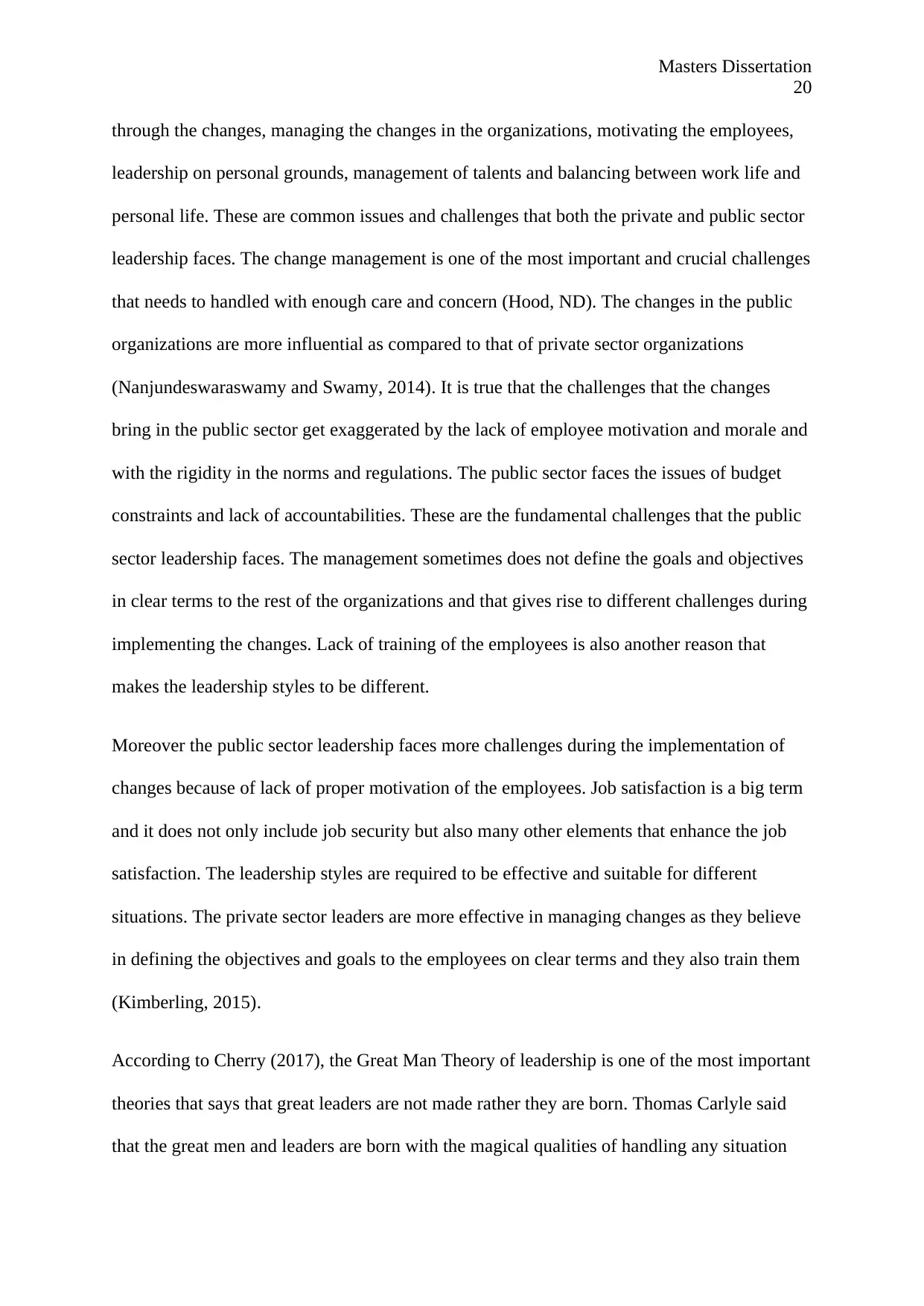
Masters Dissertation
20
through the changes, managing the changes in the organizations, motivating the employees,
leadership on personal grounds, management of talents and balancing between work life and
personal life. These are common issues and challenges that both the private and public sector
leadership faces. The change management is one of the most important and crucial challenges
that needs to handled with enough care and concern (Hood, ND). The changes in the public
organizations are more influential as compared to that of private sector organizations
(Nanjundeswaraswamy and Swamy, 2014). It is true that the challenges that the changes
bring in the public sector get exaggerated by the lack of employee motivation and morale and
with the rigidity in the norms and regulations. The public sector faces the issues of budget
constraints and lack of accountabilities. These are the fundamental challenges that the public
sector leadership faces. The management sometimes does not define the goals and objectives
in clear terms to the rest of the organizations and that gives rise to different challenges during
implementing the changes. Lack of training of the employees is also another reason that
makes the leadership styles to be different.
Moreover the public sector leadership faces more challenges during the implementation of
changes because of lack of proper motivation of the employees. Job satisfaction is a big term
and it does not only include job security but also many other elements that enhance the job
satisfaction. The leadership styles are required to be effective and suitable for different
situations. The private sector leaders are more effective in managing changes as they believe
in defining the objectives and goals to the employees on clear terms and they also train them
(Kimberling, 2015).
According to Cherry (2017), the Great Man Theory of leadership is one of the most important
theories that says that great leaders are not made rather they are born. Thomas Carlyle said
that the great men and leaders are born with the magical qualities of handling any situation
20
through the changes, managing the changes in the organizations, motivating the employees,
leadership on personal grounds, management of talents and balancing between work life and
personal life. These are common issues and challenges that both the private and public sector
leadership faces. The change management is one of the most important and crucial challenges
that needs to handled with enough care and concern (Hood, ND). The changes in the public
organizations are more influential as compared to that of private sector organizations
(Nanjundeswaraswamy and Swamy, 2014). It is true that the challenges that the changes
bring in the public sector get exaggerated by the lack of employee motivation and morale and
with the rigidity in the norms and regulations. The public sector faces the issues of budget
constraints and lack of accountabilities. These are the fundamental challenges that the public
sector leadership faces. The management sometimes does not define the goals and objectives
in clear terms to the rest of the organizations and that gives rise to different challenges during
implementing the changes. Lack of training of the employees is also another reason that
makes the leadership styles to be different.
Moreover the public sector leadership faces more challenges during the implementation of
changes because of lack of proper motivation of the employees. Job satisfaction is a big term
and it does not only include job security but also many other elements that enhance the job
satisfaction. The leadership styles are required to be effective and suitable for different
situations. The private sector leaders are more effective in managing changes as they believe
in defining the objectives and goals to the employees on clear terms and they also train them
(Kimberling, 2015).
According to Cherry (2017), the Great Man Theory of leadership is one of the most important
theories that says that great leaders are not made rather they are born. Thomas Carlyle said
that the great men and leaders are born with the magical qualities of handling any situation
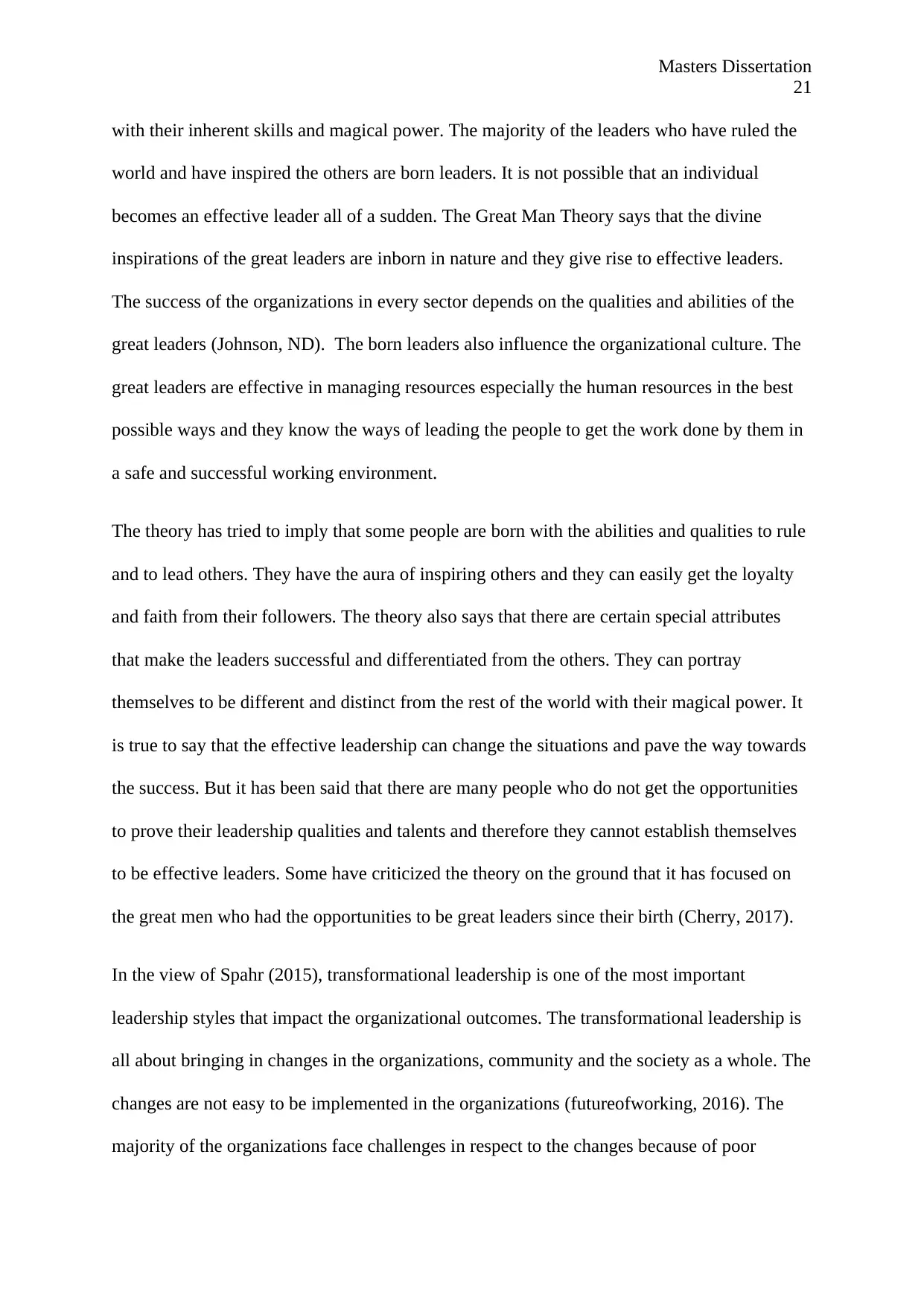
Masters Dissertation
21
with their inherent skills and magical power. The majority of the leaders who have ruled the
world and have inspired the others are born leaders. It is not possible that an individual
becomes an effective leader all of a sudden. The Great Man Theory says that the divine
inspirations of the great leaders are inborn in nature and they give rise to effective leaders.
The success of the organizations in every sector depends on the qualities and abilities of the
great leaders (Johnson, ND). The born leaders also influence the organizational culture. The
great leaders are effective in managing resources especially the human resources in the best
possible ways and they know the ways of leading the people to get the work done by them in
a safe and successful working environment.
The theory has tried to imply that some people are born with the abilities and qualities to rule
and to lead others. They have the aura of inspiring others and they can easily get the loyalty
and faith from their followers. The theory also says that there are certain special attributes
that make the leaders successful and differentiated from the others. They can portray
themselves to be different and distinct from the rest of the world with their magical power. It
is true to say that the effective leadership can change the situations and pave the way towards
the success. But it has been said that there are many people who do not get the opportunities
to prove their leadership qualities and talents and therefore they cannot establish themselves
to be effective leaders. Some have criticized the theory on the ground that it has focused on
the great men who had the opportunities to be great leaders since their birth (Cherry, 2017).
In the view of Spahr (2015), transformational leadership is one of the most important
leadership styles that impact the organizational outcomes. The transformational leadership is
all about bringing in changes in the organizations, community and the society as a whole. The
changes are not easy to be implemented in the organizations (futureofworking, 2016). The
majority of the organizations face challenges in respect to the changes because of poor
21
with their inherent skills and magical power. The majority of the leaders who have ruled the
world and have inspired the others are born leaders. It is not possible that an individual
becomes an effective leader all of a sudden. The Great Man Theory says that the divine
inspirations of the great leaders are inborn in nature and they give rise to effective leaders.
The success of the organizations in every sector depends on the qualities and abilities of the
great leaders (Johnson, ND). The born leaders also influence the organizational culture. The
great leaders are effective in managing resources especially the human resources in the best
possible ways and they know the ways of leading the people to get the work done by them in
a safe and successful working environment.
The theory has tried to imply that some people are born with the abilities and qualities to rule
and to lead others. They have the aura of inspiring others and they can easily get the loyalty
and faith from their followers. The theory also says that there are certain special attributes
that make the leaders successful and differentiated from the others. They can portray
themselves to be different and distinct from the rest of the world with their magical power. It
is true to say that the effective leadership can change the situations and pave the way towards
the success. But it has been said that there are many people who do not get the opportunities
to prove their leadership qualities and talents and therefore they cannot establish themselves
to be effective leaders. Some have criticized the theory on the ground that it has focused on
the great men who had the opportunities to be great leaders since their birth (Cherry, 2017).
In the view of Spahr (2015), transformational leadership is one of the most important
leadership styles that impact the organizational outcomes. The transformational leadership is
all about bringing in changes in the organizations, community and the society as a whole. The
changes are not easy to be implemented in the organizations (futureofworking, 2016). The
majority of the organizations face challenges in respect to the changes because of poor
Paraphrase This Document
Need a fresh take? Get an instant paraphrase of this document with our AI Paraphraser
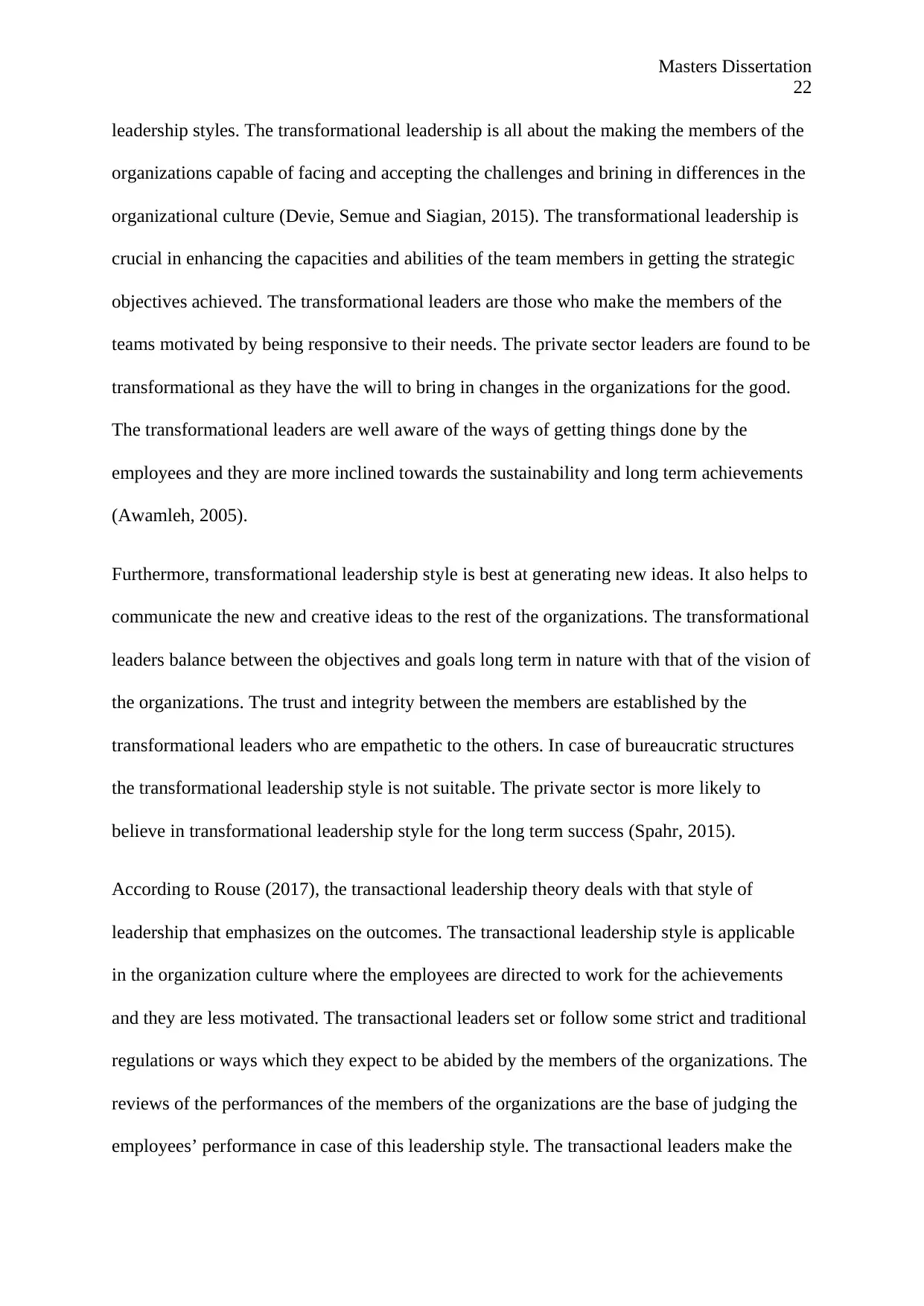
Masters Dissertation
22
leadership styles. The transformational leadership is all about the making the members of the
organizations capable of facing and accepting the challenges and brining in differences in the
organizational culture (Devie, Semue and Siagian, 2015). The transformational leadership is
crucial in enhancing the capacities and abilities of the team members in getting the strategic
objectives achieved. The transformational leaders are those who make the members of the
teams motivated by being responsive to their needs. The private sector leaders are found to be
transformational as they have the will to bring in changes in the organizations for the good.
The transformational leaders are well aware of the ways of getting things done by the
employees and they are more inclined towards the sustainability and long term achievements
(Awamleh, 2005).
Furthermore, transformational leadership style is best at generating new ideas. It also helps to
communicate the new and creative ideas to the rest of the organizations. The transformational
leaders balance between the objectives and goals long term in nature with that of the vision of
the organizations. The trust and integrity between the members are established by the
transformational leaders who are empathetic to the others. In case of bureaucratic structures
the transformational leadership style is not suitable. The private sector is more likely to
believe in transformational leadership style for the long term success (Spahr, 2015).
According to Rouse (2017), the transactional leadership theory deals with that style of
leadership that emphasizes on the outcomes. The transactional leadership style is applicable
in the organization culture where the employees are directed to work for the achievements
and they are less motivated. The transactional leaders set or follow some strict and traditional
regulations or ways which they expect to be abided by the members of the organizations. The
reviews of the performances of the members of the organizations are the base of judging the
employees’ performance in case of this leadership style. The transactional leaders make the
22
leadership styles. The transformational leadership is all about the making the members of the
organizations capable of facing and accepting the challenges and brining in differences in the
organizational culture (Devie, Semue and Siagian, 2015). The transformational leadership is
crucial in enhancing the capacities and abilities of the team members in getting the strategic
objectives achieved. The transformational leaders are those who make the members of the
teams motivated by being responsive to their needs. The private sector leaders are found to be
transformational as they have the will to bring in changes in the organizations for the good.
The transformational leaders are well aware of the ways of getting things done by the
employees and they are more inclined towards the sustainability and long term achievements
(Awamleh, 2005).
Furthermore, transformational leadership style is best at generating new ideas. It also helps to
communicate the new and creative ideas to the rest of the organizations. The transformational
leaders balance between the objectives and goals long term in nature with that of the vision of
the organizations. The trust and integrity between the members are established by the
transformational leaders who are empathetic to the others. In case of bureaucratic structures
the transformational leadership style is not suitable. The private sector is more likely to
believe in transformational leadership style for the long term success (Spahr, 2015).
According to Rouse (2017), the transactional leadership theory deals with that style of
leadership that emphasizes on the outcomes. The transactional leadership style is applicable
in the organization culture where the employees are directed to work for the achievements
and they are less motivated. The transactional leaders set or follow some strict and traditional
regulations or ways which they expect to be abided by the members of the organizations. The
reviews of the performances of the members of the organizations are the base of judging the
employees’ performance in case of this leadership style. The transactional leaders make the
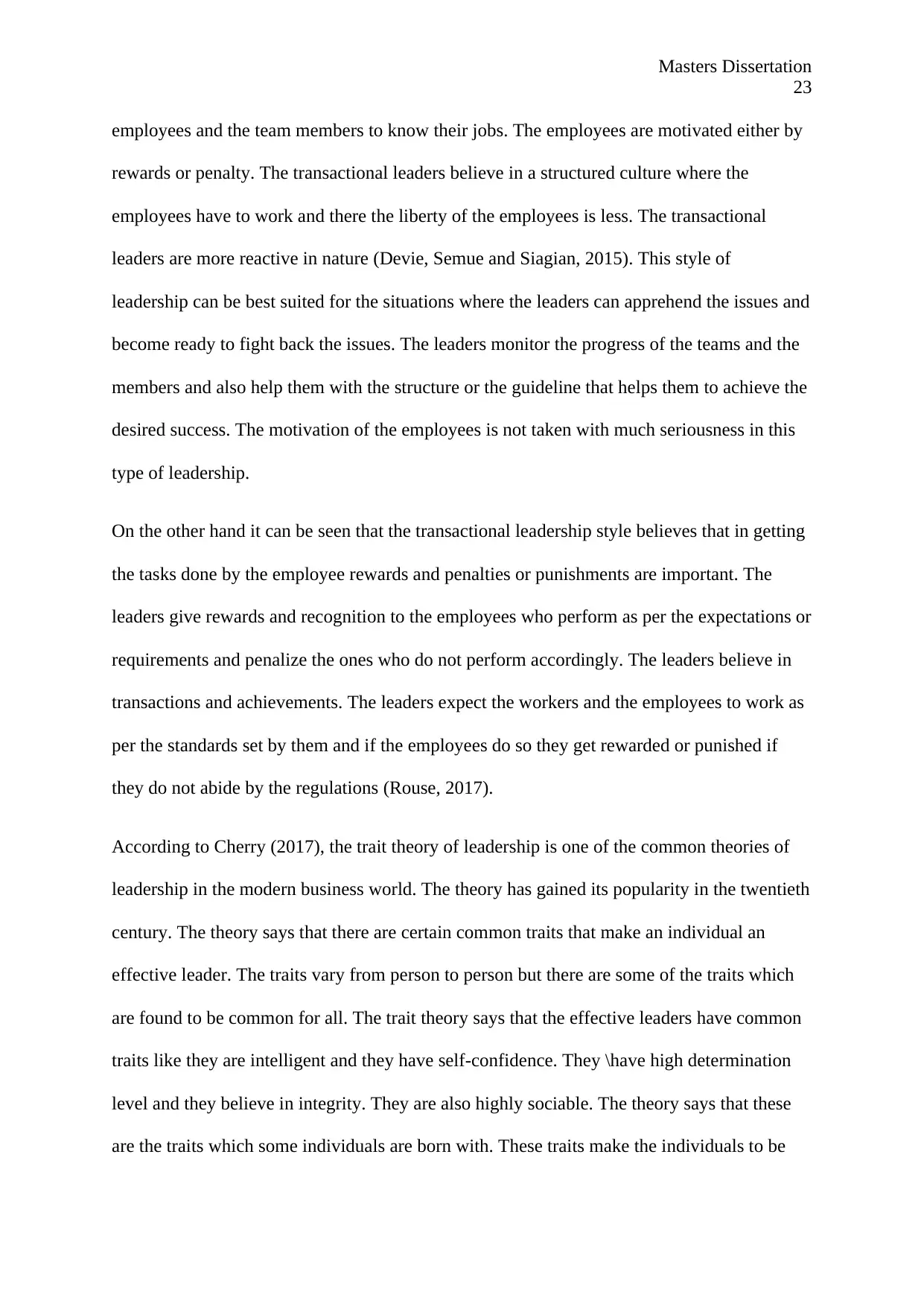
Masters Dissertation
23
employees and the team members to know their jobs. The employees are motivated either by
rewards or penalty. The transactional leaders believe in a structured culture where the
employees have to work and there the liberty of the employees is less. The transactional
leaders are more reactive in nature (Devie, Semue and Siagian, 2015). This style of
leadership can be best suited for the situations where the leaders can apprehend the issues and
become ready to fight back the issues. The leaders monitor the progress of the teams and the
members and also help them with the structure or the guideline that helps them to achieve the
desired success. The motivation of the employees is not taken with much seriousness in this
type of leadership.
On the other hand it can be seen that the transactional leadership style believes that in getting
the tasks done by the employee rewards and penalties or punishments are important. The
leaders give rewards and recognition to the employees who perform as per the expectations or
requirements and penalize the ones who do not perform accordingly. The leaders believe in
transactions and achievements. The leaders expect the workers and the employees to work as
per the standards set by them and if the employees do so they get rewarded or punished if
they do not abide by the regulations (Rouse, 2017).
According to Cherry (2017), the trait theory of leadership is one of the common theories of
leadership in the modern business world. The theory has gained its popularity in the twentieth
century. The theory says that there are certain common traits that make an individual an
effective leader. The traits vary from person to person but there are some of the traits which
are found to be common for all. The trait theory says that the effective leaders have common
traits like they are intelligent and they have self-confidence. They \have high determination
level and they believe in integrity. They are also highly sociable. The theory says that these
are the traits which some individuals are born with. These traits make the individuals to be
23
employees and the team members to know their jobs. The employees are motivated either by
rewards or penalty. The transactional leaders believe in a structured culture where the
employees have to work and there the liberty of the employees is less. The transactional
leaders are more reactive in nature (Devie, Semue and Siagian, 2015). This style of
leadership can be best suited for the situations where the leaders can apprehend the issues and
become ready to fight back the issues. The leaders monitor the progress of the teams and the
members and also help them with the structure or the guideline that helps them to achieve the
desired success. The motivation of the employees is not taken with much seriousness in this
type of leadership.
On the other hand it can be seen that the transactional leadership style believes that in getting
the tasks done by the employee rewards and penalties or punishments are important. The
leaders give rewards and recognition to the employees who perform as per the expectations or
requirements and penalize the ones who do not perform accordingly. The leaders believe in
transactions and achievements. The leaders expect the workers and the employees to work as
per the standards set by them and if the employees do so they get rewarded or punished if
they do not abide by the regulations (Rouse, 2017).
According to Cherry (2017), the trait theory of leadership is one of the common theories of
leadership in the modern business world. The theory has gained its popularity in the twentieth
century. The theory says that there are certain common traits that make an individual an
effective leader. The traits vary from person to person but there are some of the traits which
are found to be common for all. The trait theory says that the effective leaders have common
traits like they are intelligent and they have self-confidence. They \have high determination
level and they believe in integrity. They are also highly sociable. The theory says that these
are the traits which some individuals are born with. These traits make the individuals to be

Masters Dissertation
24
effective leaders. According to this theory there are certain traits which develop certain
particular types of behaviors in the leaders. The behaviors that are recognized by the trait
theory are found to be consistent in every situation. The individuals are born with these traits
and they become different from the others because of these traits. This theory is also based on
similar belief that the individuals are born with certain qualities which make them identifiable
as effective leaders. The trait theory of leadership is important in many cases where the
organizations have to decide which style of leadership has to follow (Cherry, 2017).
In the opinion of Kanodia and Sacher (2016), the trait theory identifies some of the common
characteristics of the individuals which provide the right answer behind the fact that some are
born leaders and they just need the right opportunity to prove them. It has been seen that not
all the individuals can become good leaders. Few individuals with some common traits and
characteristics can become effective leaders. It is true in every situation. The trait theory
highlights the common characteristics of the effective leaders that make them truly
successful. The initiative with which a leader gets the job done, the tenacity of the leaders and
the energy of the leader in every situation makes him or her differentiated and successful
being effective leaders is common. The effective leaders are found to be flexible and creative
in nature. They have the charisma to inspire and impact the others. The emotional intelligence
of the effective leaders is commendable. They know the ways of driving and motivating their
subordinates in getting something fruitful and achieving the desired success. They are full of
confidence and they make the others confident. They are honest and they believe in integrity.
These are common types of characteristics that make an individual successful leader. These
are the main aspects being highlighted by the trait theory of leadership (Kanodia and Sacher,
2016).
24
effective leaders. According to this theory there are certain traits which develop certain
particular types of behaviors in the leaders. The behaviors that are recognized by the trait
theory are found to be consistent in every situation. The individuals are born with these traits
and they become different from the others because of these traits. This theory is also based on
similar belief that the individuals are born with certain qualities which make them identifiable
as effective leaders. The trait theory of leadership is important in many cases where the
organizations have to decide which style of leadership has to follow (Cherry, 2017).
In the opinion of Kanodia and Sacher (2016), the trait theory identifies some of the common
characteristics of the individuals which provide the right answer behind the fact that some are
born leaders and they just need the right opportunity to prove them. It has been seen that not
all the individuals can become good leaders. Few individuals with some common traits and
characteristics can become effective leaders. It is true in every situation. The trait theory
highlights the common characteristics of the effective leaders that make them truly
successful. The initiative with which a leader gets the job done, the tenacity of the leaders and
the energy of the leader in every situation makes him or her differentiated and successful
being effective leaders is common. The effective leaders are found to be flexible and creative
in nature. They have the charisma to inspire and impact the others. The emotional intelligence
of the effective leaders is commendable. They know the ways of driving and motivating their
subordinates in getting something fruitful and achieving the desired success. They are full of
confidence and they make the others confident. They are honest and they believe in integrity.
These are common types of characteristics that make an individual successful leader. These
are the main aspects being highlighted by the trait theory of leadership (Kanodia and Sacher,
2016).
Secure Best Marks with AI Grader
Need help grading? Try our AI Grader for instant feedback on your assignments.
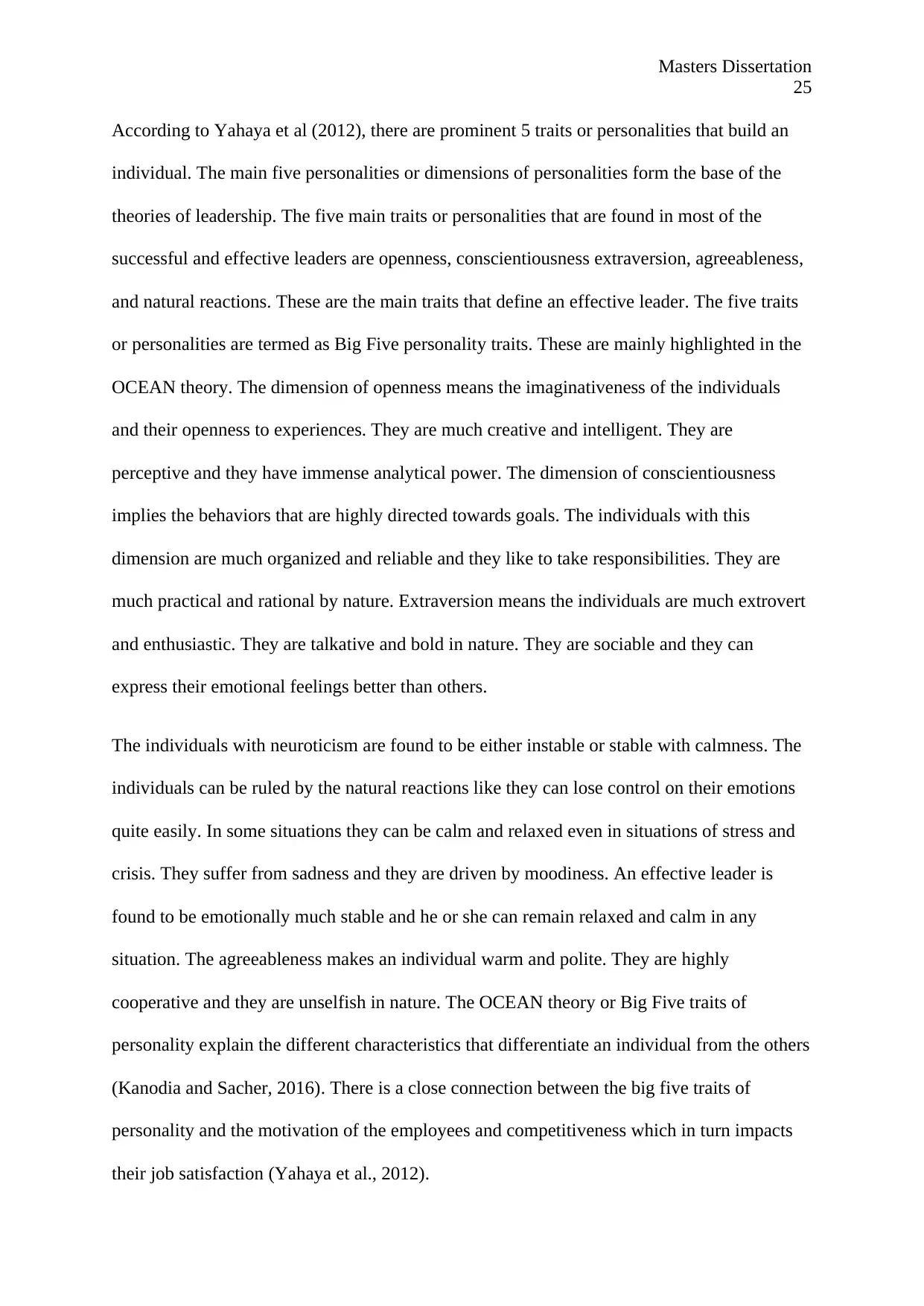
Masters Dissertation
25
According to Yahaya et al (2012), there are prominent 5 traits or personalities that build an
individual. The main five personalities or dimensions of personalities form the base of the
theories of leadership. The five main traits or personalities that are found in most of the
successful and effective leaders are openness, conscientiousness extraversion, agreeableness,
and natural reactions. These are the main traits that define an effective leader. The five traits
or personalities are termed as Big Five personality traits. These are mainly highlighted in the
OCEAN theory. The dimension of openness means the imaginativeness of the individuals
and their openness to experiences. They are much creative and intelligent. They are
perceptive and they have immense analytical power. The dimension of conscientiousness
implies the behaviors that are highly directed towards goals. The individuals with this
dimension are much organized and reliable and they like to take responsibilities. They are
much practical and rational by nature. Extraversion means the individuals are much extrovert
and enthusiastic. They are talkative and bold in nature. They are sociable and they can
express their emotional feelings better than others.
The individuals with neuroticism are found to be either instable or stable with calmness. The
individuals can be ruled by the natural reactions like they can lose control on their emotions
quite easily. In some situations they can be calm and relaxed even in situations of stress and
crisis. They suffer from sadness and they are driven by moodiness. An effective leader is
found to be emotionally much stable and he or she can remain relaxed and calm in any
situation. The agreeableness makes an individual warm and polite. They are highly
cooperative and they are unselfish in nature. The OCEAN theory or Big Five traits of
personality explain the different characteristics that differentiate an individual from the others
(Kanodia and Sacher, 2016). There is a close connection between the big five traits of
personality and the motivation of the employees and competitiveness which in turn impacts
their job satisfaction (Yahaya et al., 2012).
25
According to Yahaya et al (2012), there are prominent 5 traits or personalities that build an
individual. The main five personalities or dimensions of personalities form the base of the
theories of leadership. The five main traits or personalities that are found in most of the
successful and effective leaders are openness, conscientiousness extraversion, agreeableness,
and natural reactions. These are the main traits that define an effective leader. The five traits
or personalities are termed as Big Five personality traits. These are mainly highlighted in the
OCEAN theory. The dimension of openness means the imaginativeness of the individuals
and their openness to experiences. They are much creative and intelligent. They are
perceptive and they have immense analytical power. The dimension of conscientiousness
implies the behaviors that are highly directed towards goals. The individuals with this
dimension are much organized and reliable and they like to take responsibilities. They are
much practical and rational by nature. Extraversion means the individuals are much extrovert
and enthusiastic. They are talkative and bold in nature. They are sociable and they can
express their emotional feelings better than others.
The individuals with neuroticism are found to be either instable or stable with calmness. The
individuals can be ruled by the natural reactions like they can lose control on their emotions
quite easily. In some situations they can be calm and relaxed even in situations of stress and
crisis. They suffer from sadness and they are driven by moodiness. An effective leader is
found to be emotionally much stable and he or she can remain relaxed and calm in any
situation. The agreeableness makes an individual warm and polite. They are highly
cooperative and they are unselfish in nature. The OCEAN theory or Big Five traits of
personality explain the different characteristics that differentiate an individual from the others
(Kanodia and Sacher, 2016). There is a close connection between the big five traits of
personality and the motivation of the employees and competitiveness which in turn impacts
their job satisfaction (Yahaya et al., 2012).

Masters Dissertation
26
In the opinion of Derue et al (2011), the Behavioral Theory of leadership deals with the ways
in which the leaders behave and the functions of the leaders. The theory says that there are
certain styles of leadership which will work but there are certain others which will not work
properly. The main functions of the leaders include the determination of goals, motivating the
members of the organizations and getting the objectives and goals achieved, establishing
effective communication and building of teams. These are the fundamental behaviors of the
leaders who are successful and effective. The Behavioral Theory believes that leadership
qualities can be developed and taught it is not mandatory that leaders have to be born with the
traits and qualities for being successful.
Furthermore, the theory highlights that there are ways of developing the leadership qualities
and skills so that the business leaders and managers can respond to the specific situations.
The theory has studied the behaviors and attitudes of the leaders and it analyzes the doings of
the leaders. It does not believe that only the individuals who are born with the qualities can
become successful leaders rather it emphasizes that the individuals can also become
successful and effective leaders in course of their personal and professional life either by self-
development or by learning. It also analyzes the relationship and connection between the
behaviors of the leaders and the success that they achieve with these behaviors. It has been
observed that the behaviors of the leaders determine their success of failures. The effective
leaders choose the right style of behaviors for any particular situation to become successful
(DERUE et al., 2011).
As per the views of Gupta (2009), the contingency theory of leadership is another important
aspect that studies the leadership components. Fred Fiedler has come up with the theory of
contingency in the middle of 1960s. The theory says that there is no specific leadership style
that can be proclaimed to be the best. The effectiveness of a leader depends on the situations
26
In the opinion of Derue et al (2011), the Behavioral Theory of leadership deals with the ways
in which the leaders behave and the functions of the leaders. The theory says that there are
certain styles of leadership which will work but there are certain others which will not work
properly. The main functions of the leaders include the determination of goals, motivating the
members of the organizations and getting the objectives and goals achieved, establishing
effective communication and building of teams. These are the fundamental behaviors of the
leaders who are successful and effective. The Behavioral Theory believes that leadership
qualities can be developed and taught it is not mandatory that leaders have to be born with the
traits and qualities for being successful.
Furthermore, the theory highlights that there are ways of developing the leadership qualities
and skills so that the business leaders and managers can respond to the specific situations.
The theory has studied the behaviors and attitudes of the leaders and it analyzes the doings of
the leaders. It does not believe that only the individuals who are born with the qualities can
become successful leaders rather it emphasizes that the individuals can also become
successful and effective leaders in course of their personal and professional life either by self-
development or by learning. It also analyzes the relationship and connection between the
behaviors of the leaders and the success that they achieve with these behaviors. It has been
observed that the behaviors of the leaders determine their success of failures. The effective
leaders choose the right style of behaviors for any particular situation to become successful
(DERUE et al., 2011).
As per the views of Gupta (2009), the contingency theory of leadership is another important
aspect that studies the leadership components. Fred Fiedler has come up with the theory of
contingency in the middle of 1960s. The theory says that there is no specific leadership style
that can be proclaimed to be the best. The effectiveness of a leader depends on the situations
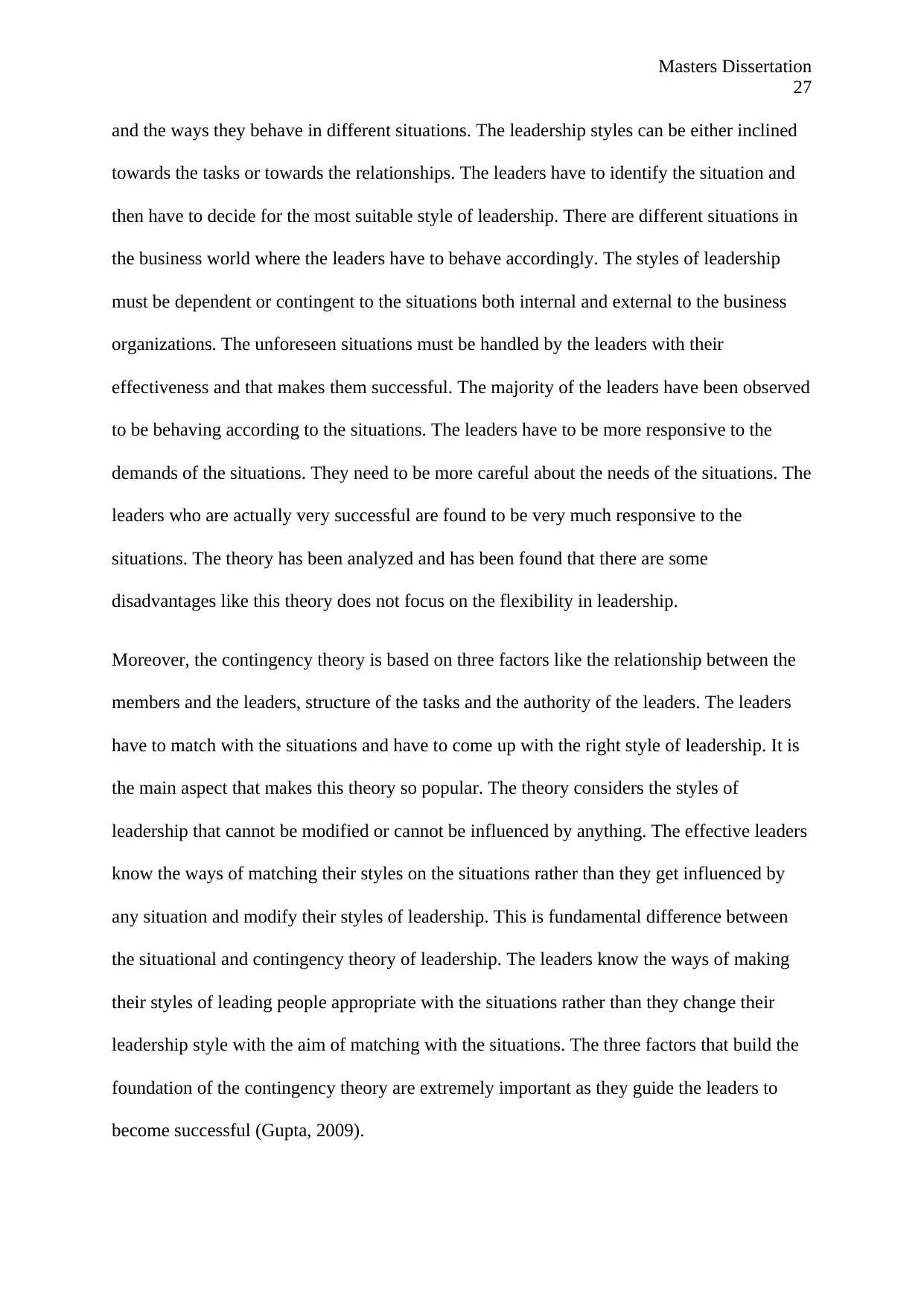
Masters Dissertation
27
and the ways they behave in different situations. The leadership styles can be either inclined
towards the tasks or towards the relationships. The leaders have to identify the situation and
then have to decide for the most suitable style of leadership. There are different situations in
the business world where the leaders have to behave accordingly. The styles of leadership
must be dependent or contingent to the situations both internal and external to the business
organizations. The unforeseen situations must be handled by the leaders with their
effectiveness and that makes them successful. The majority of the leaders have been observed
to be behaving according to the situations. The leaders have to be more responsive to the
demands of the situations. They need to be more careful about the needs of the situations. The
leaders who are actually very successful are found to be very much responsive to the
situations. The theory has been analyzed and has been found that there are some
disadvantages like this theory does not focus on the flexibility in leadership.
Moreover, the contingency theory is based on three factors like the relationship between the
members and the leaders, structure of the tasks and the authority of the leaders. The leaders
have to match with the situations and have to come up with the right style of leadership. It is
the main aspect that makes this theory so popular. The theory considers the styles of
leadership that cannot be modified or cannot be influenced by anything. The effective leaders
know the ways of matching their styles on the situations rather than they get influenced by
any situation and modify their styles of leadership. This is fundamental difference between
the situational and contingency theory of leadership. The leaders know the ways of making
their styles of leading people appropriate with the situations rather than they change their
leadership style with the aim of matching with the situations. The three factors that build the
foundation of the contingency theory are extremely important as they guide the leaders to
become successful (Gupta, 2009).
27
and the ways they behave in different situations. The leadership styles can be either inclined
towards the tasks or towards the relationships. The leaders have to identify the situation and
then have to decide for the most suitable style of leadership. There are different situations in
the business world where the leaders have to behave accordingly. The styles of leadership
must be dependent or contingent to the situations both internal and external to the business
organizations. The unforeseen situations must be handled by the leaders with their
effectiveness and that makes them successful. The majority of the leaders have been observed
to be behaving according to the situations. The leaders have to be more responsive to the
demands of the situations. They need to be more careful about the needs of the situations. The
leaders who are actually very successful are found to be very much responsive to the
situations. The theory has been analyzed and has been found that there are some
disadvantages like this theory does not focus on the flexibility in leadership.
Moreover, the contingency theory is based on three factors like the relationship between the
members and the leaders, structure of the tasks and the authority of the leaders. The leaders
have to match with the situations and have to come up with the right style of leadership. It is
the main aspect that makes this theory so popular. The theory considers the styles of
leadership that cannot be modified or cannot be influenced by anything. The effective leaders
know the ways of matching their styles on the situations rather than they get influenced by
any situation and modify their styles of leadership. This is fundamental difference between
the situational and contingency theory of leadership. The leaders know the ways of making
their styles of leading people appropriate with the situations rather than they change their
leadership style with the aim of matching with the situations. The three factors that build the
foundation of the contingency theory are extremely important as they guide the leaders to
become successful (Gupta, 2009).
Paraphrase This Document
Need a fresh take? Get an instant paraphrase of this document with our AI Paraphraser
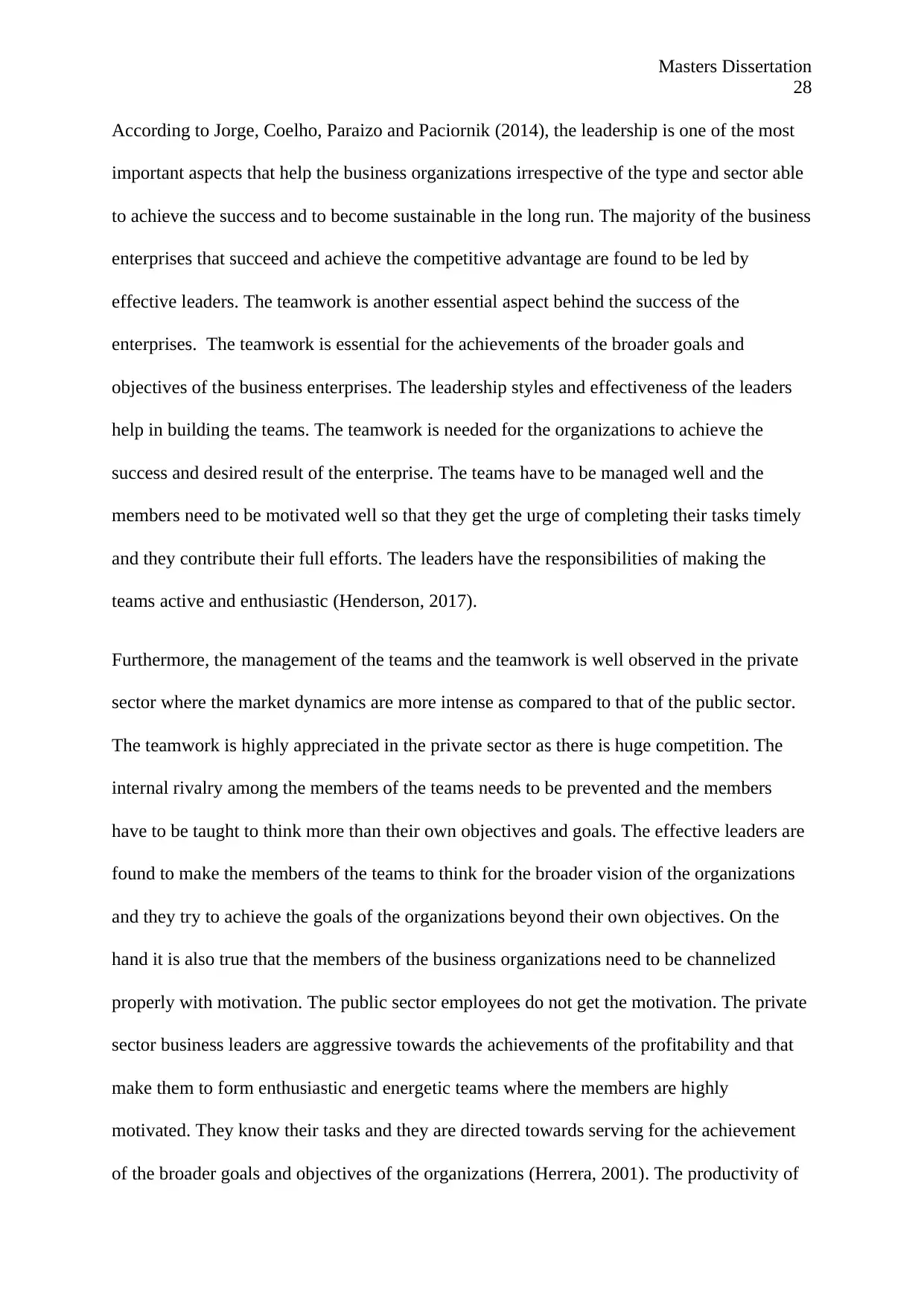
Masters Dissertation
28
According to Jorge, Coelho, Paraizo and Paciornik (2014), the leadership is one of the most
important aspects that help the business organizations irrespective of the type and sector able
to achieve the success and to become sustainable in the long run. The majority of the business
enterprises that succeed and achieve the competitive advantage are found to be led by
effective leaders. The teamwork is another essential aspect behind the success of the
enterprises. The teamwork is essential for the achievements of the broader goals and
objectives of the business enterprises. The leadership styles and effectiveness of the leaders
help in building the teams. The teamwork is needed for the organizations to achieve the
success and desired result of the enterprise. The teams have to be managed well and the
members need to be motivated well so that they get the urge of completing their tasks timely
and they contribute their full efforts. The leaders have the responsibilities of making the
teams active and enthusiastic (Henderson, 2017).
Furthermore, the management of the teams and the teamwork is well observed in the private
sector where the market dynamics are more intense as compared to that of the public sector.
The teamwork is highly appreciated in the private sector as there is huge competition. The
internal rivalry among the members of the teams needs to be prevented and the members
have to be taught to think more than their own objectives and goals. The effective leaders are
found to make the members of the teams to think for the broader vision of the organizations
and they try to achieve the goals of the organizations beyond their own objectives. On the
hand it is also true that the members of the business organizations need to be channelized
properly with motivation. The public sector employees do not get the motivation. The private
sector business leaders are aggressive towards the achievements of the profitability and that
make them to form enthusiastic and energetic teams where the members are highly
motivated. They know their tasks and they are directed towards serving for the achievement
of the broader goals and objectives of the organizations (Herrera, 2001). The productivity of
28
According to Jorge, Coelho, Paraizo and Paciornik (2014), the leadership is one of the most
important aspects that help the business organizations irrespective of the type and sector able
to achieve the success and to become sustainable in the long run. The majority of the business
enterprises that succeed and achieve the competitive advantage are found to be led by
effective leaders. The teamwork is another essential aspect behind the success of the
enterprises. The teamwork is essential for the achievements of the broader goals and
objectives of the business enterprises. The leadership styles and effectiveness of the leaders
help in building the teams. The teamwork is needed for the organizations to achieve the
success and desired result of the enterprise. The teams have to be managed well and the
members need to be motivated well so that they get the urge of completing their tasks timely
and they contribute their full efforts. The leaders have the responsibilities of making the
teams active and enthusiastic (Henderson, 2017).
Furthermore, the management of the teams and the teamwork is well observed in the private
sector where the market dynamics are more intense as compared to that of the public sector.
The teamwork is highly appreciated in the private sector as there is huge competition. The
internal rivalry among the members of the teams needs to be prevented and the members
have to be taught to think more than their own objectives and goals. The effective leaders are
found to make the members of the teams to think for the broader vision of the organizations
and they try to achieve the goals of the organizations beyond their own objectives. On the
hand it is also true that the members of the business organizations need to be channelized
properly with motivation. The public sector employees do not get the motivation. The private
sector business leaders are aggressive towards the achievements of the profitability and that
make them to form enthusiastic and energetic teams where the members are highly
motivated. They know their tasks and they are directed towards serving for the achievement
of the broader goals and objectives of the organizations (Herrera, 2001). The productivity of

Masters Dissertation
29
the members of the teams of the private sector is higher as compared to that of the members
of the teams of public sector. The members of the teams pursue self-investments when they
are motivated and this depends on the effectiveness and efforts of the leaders (Jorge et al.,
2014).
There are certain traits that are found in case of both public and private sector leadership.
Public and private sector leaders promote communication to be clear and open, support the
individuals, allocate resources, remove obstacles and promote innovation. The researchers
have tried to identify the areas of differences in the private and public leadership styles and it
has been observed that there is no remarkable difference between these two if the above
mentioned five traits are considered. The leaders of both the sectors are inclined towards the
creation of the effective business organizations where the respective objectives and goals are
achieved. The leadership is the quality whether inherent in the leaders or being developed but
crucial for any sector.
29
the members of the teams of the private sector is higher as compared to that of the members
of the teams of public sector. The members of the teams pursue self-investments when they
are motivated and this depends on the effectiveness and efforts of the leaders (Jorge et al.,
2014).
There are certain traits that are found in case of both public and private sector leadership.
Public and private sector leaders promote communication to be clear and open, support the
individuals, allocate resources, remove obstacles and promote innovation. The researchers
have tried to identify the areas of differences in the private and public leadership styles and it
has been observed that there is no remarkable difference between these two if the above
mentioned five traits are considered. The leaders of both the sectors are inclined towards the
creation of the effective business organizations where the respective objectives and goals are
achieved. The leadership is the quality whether inherent in the leaders or being developed but
crucial for any sector.
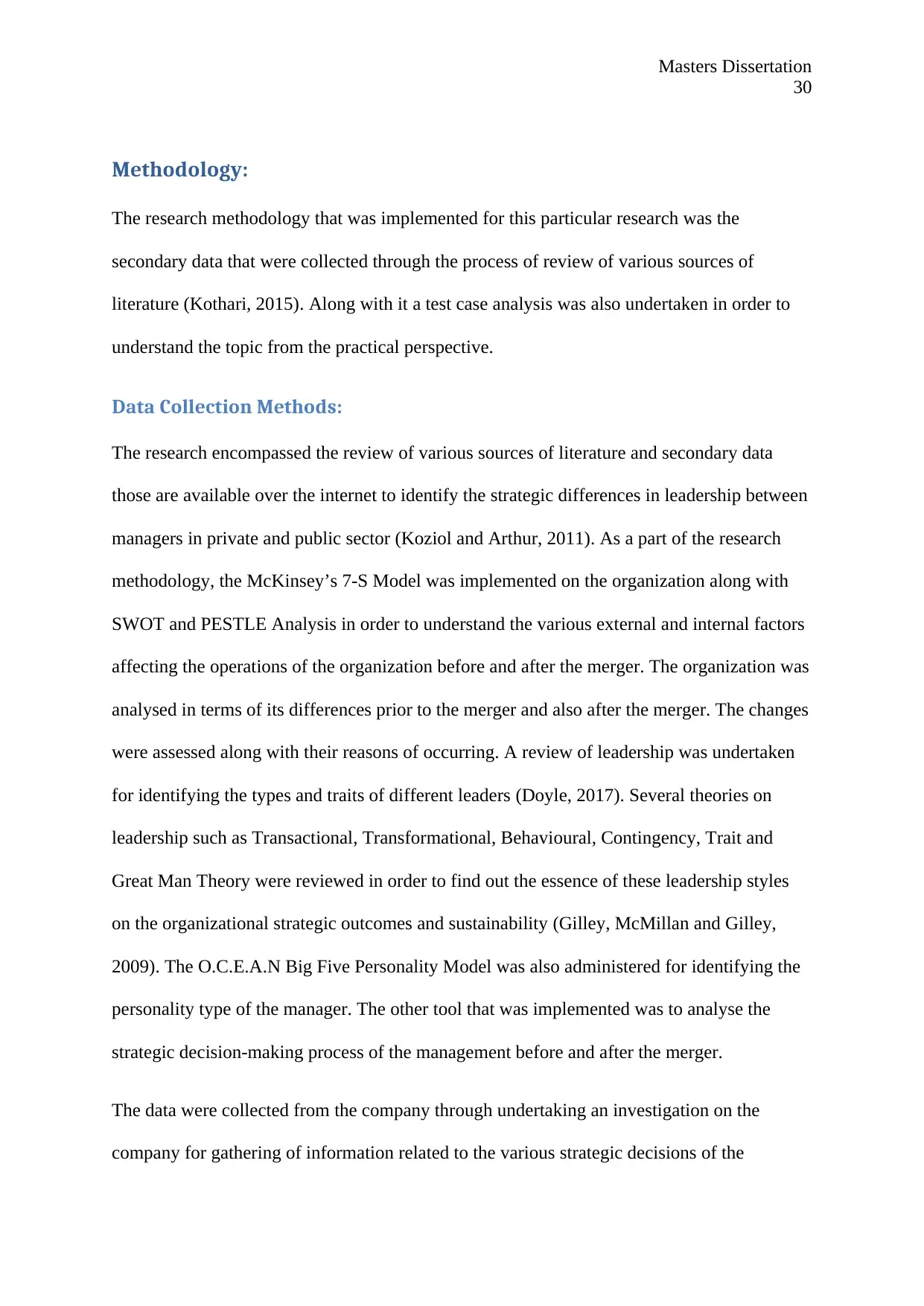
Masters Dissertation
30
Methodology:
The research methodology that was implemented for this particular research was the
secondary data that were collected through the process of review of various sources of
literature (Kothari, 2015). Along with it a test case analysis was also undertaken in order to
understand the topic from the practical perspective.
Data Collection Methods:
The research encompassed the review of various sources of literature and secondary data
those are available over the internet to identify the strategic differences in leadership between
managers in private and public sector (Koziol and Arthur, 2011). As a part of the research
methodology, the McKinsey’s 7-S Model was implemented on the organization along with
SWOT and PESTLE Analysis in order to understand the various external and internal factors
affecting the operations of the organization before and after the merger. The organization was
analysed in terms of its differences prior to the merger and also after the merger. The changes
were assessed along with their reasons of occurring. A review of leadership was undertaken
for identifying the types and traits of different leaders (Doyle, 2017). Several theories on
leadership such as Transactional, Transformational, Behavioural, Contingency, Trait and
Great Man Theory were reviewed in order to find out the essence of these leadership styles
on the organizational strategic outcomes and sustainability (Gilley, McMillan and Gilley,
2009). The O.C.E.A.N Big Five Personality Model was also administered for identifying the
personality type of the manager. The other tool that was implemented was to analyse the
strategic decision-making process of the management before and after the merger.
The data were collected from the company through undertaking an investigation on the
company for gathering of information related to the various strategic decisions of the
30
Methodology:
The research methodology that was implemented for this particular research was the
secondary data that were collected through the process of review of various sources of
literature (Kothari, 2015). Along with it a test case analysis was also undertaken in order to
understand the topic from the practical perspective.
Data Collection Methods:
The research encompassed the review of various sources of literature and secondary data
those are available over the internet to identify the strategic differences in leadership between
managers in private and public sector (Koziol and Arthur, 2011). As a part of the research
methodology, the McKinsey’s 7-S Model was implemented on the organization along with
SWOT and PESTLE Analysis in order to understand the various external and internal factors
affecting the operations of the organization before and after the merger. The organization was
analysed in terms of its differences prior to the merger and also after the merger. The changes
were assessed along with their reasons of occurring. A review of leadership was undertaken
for identifying the types and traits of different leaders (Doyle, 2017). Several theories on
leadership such as Transactional, Transformational, Behavioural, Contingency, Trait and
Great Man Theory were reviewed in order to find out the essence of these leadership styles
on the organizational strategic outcomes and sustainability (Gilley, McMillan and Gilley,
2009). The O.C.E.A.N Big Five Personality Model was also administered for identifying the
personality type of the manager. The other tool that was implemented was to analyse the
strategic decision-making process of the management before and after the merger.
The data were collected from the company through undertaking an investigation on the
company for gathering of information related to the various strategic decisions of the
Secure Best Marks with AI Grader
Need help grading? Try our AI Grader for instant feedback on your assignments.
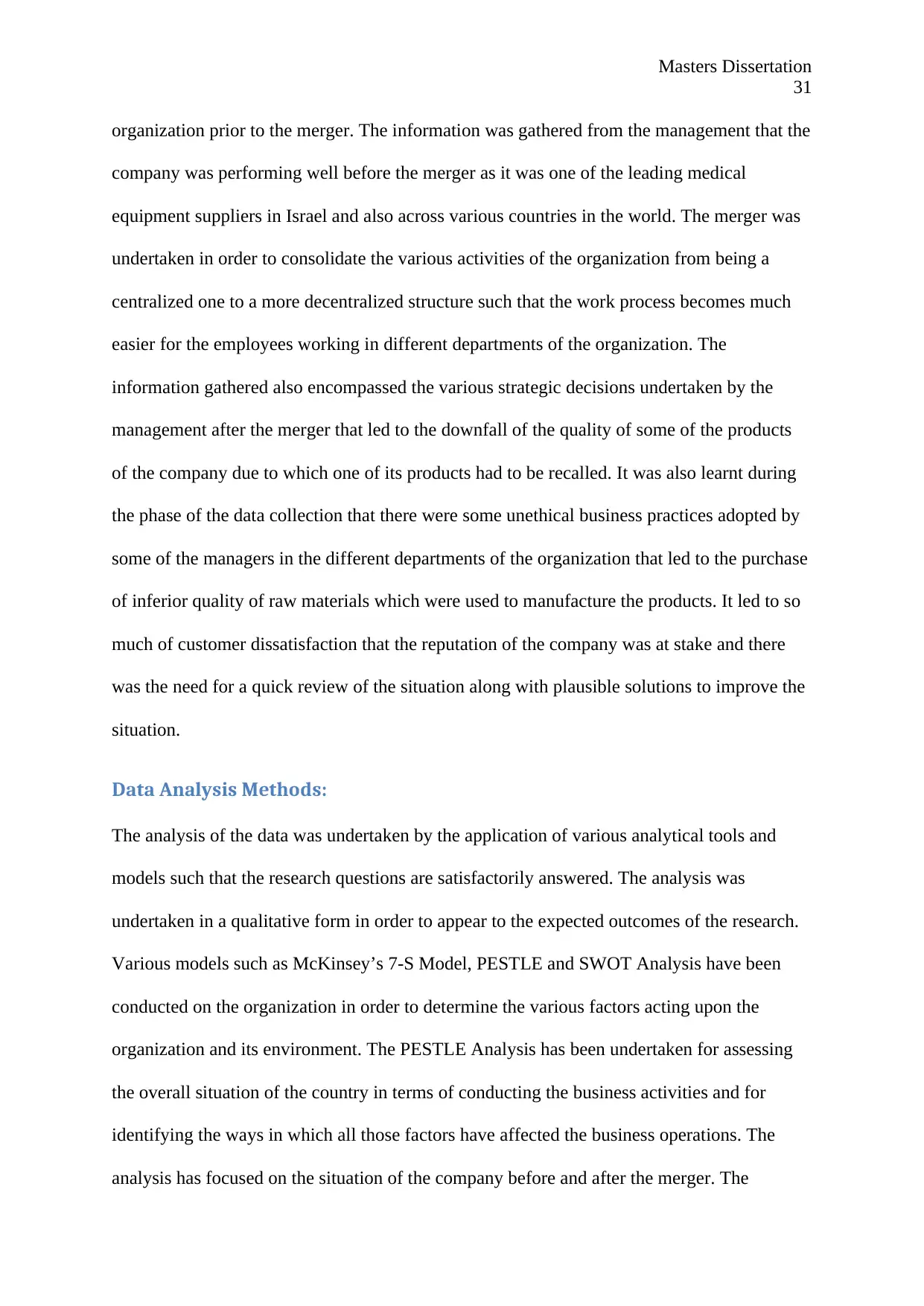
Masters Dissertation
31
organization prior to the merger. The information was gathered from the management that the
company was performing well before the merger as it was one of the leading medical
equipment suppliers in Israel and also across various countries in the world. The merger was
undertaken in order to consolidate the various activities of the organization from being a
centralized one to a more decentralized structure such that the work process becomes much
easier for the employees working in different departments of the organization. The
information gathered also encompassed the various strategic decisions undertaken by the
management after the merger that led to the downfall of the quality of some of the products
of the company due to which one of its products had to be recalled. It was also learnt during
the phase of the data collection that there were some unethical business practices adopted by
some of the managers in the different departments of the organization that led to the purchase
of inferior quality of raw materials which were used to manufacture the products. It led to so
much of customer dissatisfaction that the reputation of the company was at stake and there
was the need for a quick review of the situation along with plausible solutions to improve the
situation.
Data Analysis Methods:
The analysis of the data was undertaken by the application of various analytical tools and
models such that the research questions are satisfactorily answered. The analysis was
undertaken in a qualitative form in order to appear to the expected outcomes of the research.
Various models such as McKinsey’s 7-S Model, PESTLE and SWOT Analysis have been
conducted on the organization in order to determine the various factors acting upon the
organization and its environment. The PESTLE Analysis has been undertaken for assessing
the overall situation of the country in terms of conducting the business activities and for
identifying the ways in which all those factors have affected the business operations. The
analysis has focused on the situation of the company before and after the merger. The
31
organization prior to the merger. The information was gathered from the management that the
company was performing well before the merger as it was one of the leading medical
equipment suppliers in Israel and also across various countries in the world. The merger was
undertaken in order to consolidate the various activities of the organization from being a
centralized one to a more decentralized structure such that the work process becomes much
easier for the employees working in different departments of the organization. The
information gathered also encompassed the various strategic decisions undertaken by the
management after the merger that led to the downfall of the quality of some of the products
of the company due to which one of its products had to be recalled. It was also learnt during
the phase of the data collection that there were some unethical business practices adopted by
some of the managers in the different departments of the organization that led to the purchase
of inferior quality of raw materials which were used to manufacture the products. It led to so
much of customer dissatisfaction that the reputation of the company was at stake and there
was the need for a quick review of the situation along with plausible solutions to improve the
situation.
Data Analysis Methods:
The analysis of the data was undertaken by the application of various analytical tools and
models such that the research questions are satisfactorily answered. The analysis was
undertaken in a qualitative form in order to appear to the expected outcomes of the research.
Various models such as McKinsey’s 7-S Model, PESTLE and SWOT Analysis have been
conducted on the organization in order to determine the various factors acting upon the
organization and its environment. The PESTLE Analysis has been undertaken for assessing
the overall situation of the country in terms of conducting the business activities and for
identifying the ways in which all those factors have affected the business operations. The
analysis has focused on the situation of the company before and after the merger. The
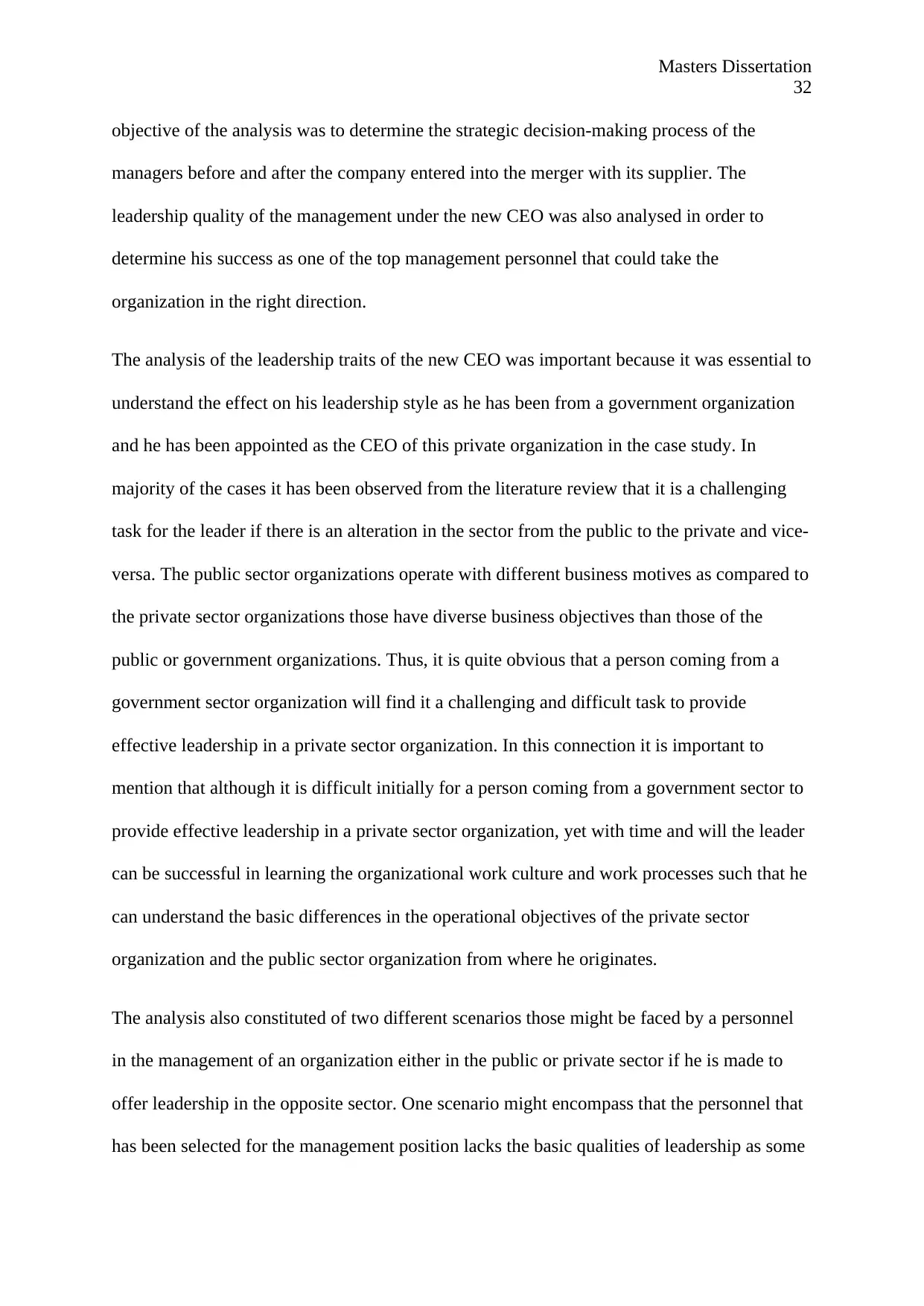
Masters Dissertation
32
objective of the analysis was to determine the strategic decision-making process of the
managers before and after the company entered into the merger with its supplier. The
leadership quality of the management under the new CEO was also analysed in order to
determine his success as one of the top management personnel that could take the
organization in the right direction.
The analysis of the leadership traits of the new CEO was important because it was essential to
understand the effect on his leadership style as he has been from a government organization
and he has been appointed as the CEO of this private organization in the case study. In
majority of the cases it has been observed from the literature review that it is a challenging
task for the leader if there is an alteration in the sector from the public to the private and vice-
versa. The public sector organizations operate with different business motives as compared to
the private sector organizations those have diverse business objectives than those of the
public or government organizations. Thus, it is quite obvious that a person coming from a
government sector organization will find it a challenging and difficult task to provide
effective leadership in a private sector organization. In this connection it is important to
mention that although it is difficult initially for a person coming from a government sector to
provide effective leadership in a private sector organization, yet with time and will the leader
can be successful in learning the organizational work culture and work processes such that he
can understand the basic differences in the operational objectives of the private sector
organization and the public sector organization from where he originates.
The analysis also constituted of two different scenarios those might be faced by a personnel
in the management of an organization either in the public or private sector if he is made to
offer leadership in the opposite sector. One scenario might encompass that the personnel that
has been selected for the management position lacks the basic qualities of leadership as some
32
objective of the analysis was to determine the strategic decision-making process of the
managers before and after the company entered into the merger with its supplier. The
leadership quality of the management under the new CEO was also analysed in order to
determine his success as one of the top management personnel that could take the
organization in the right direction.
The analysis of the leadership traits of the new CEO was important because it was essential to
understand the effect on his leadership style as he has been from a government organization
and he has been appointed as the CEO of this private organization in the case study. In
majority of the cases it has been observed from the literature review that it is a challenging
task for the leader if there is an alteration in the sector from the public to the private and vice-
versa. The public sector organizations operate with different business motives as compared to
the private sector organizations those have diverse business objectives than those of the
public or government organizations. Thus, it is quite obvious that a person coming from a
government sector organization will find it a challenging and difficult task to provide
effective leadership in a private sector organization. In this connection it is important to
mention that although it is difficult initially for a person coming from a government sector to
provide effective leadership in a private sector organization, yet with time and will the leader
can be successful in learning the organizational work culture and work processes such that he
can understand the basic differences in the operational objectives of the private sector
organization and the public sector organization from where he originates.
The analysis also constituted of two different scenarios those might be faced by a personnel
in the management of an organization either in the public or private sector if he is made to
offer leadership in the opposite sector. One scenario might encompass that the personnel that
has been selected for the management position lacks the basic qualities of leadership as some
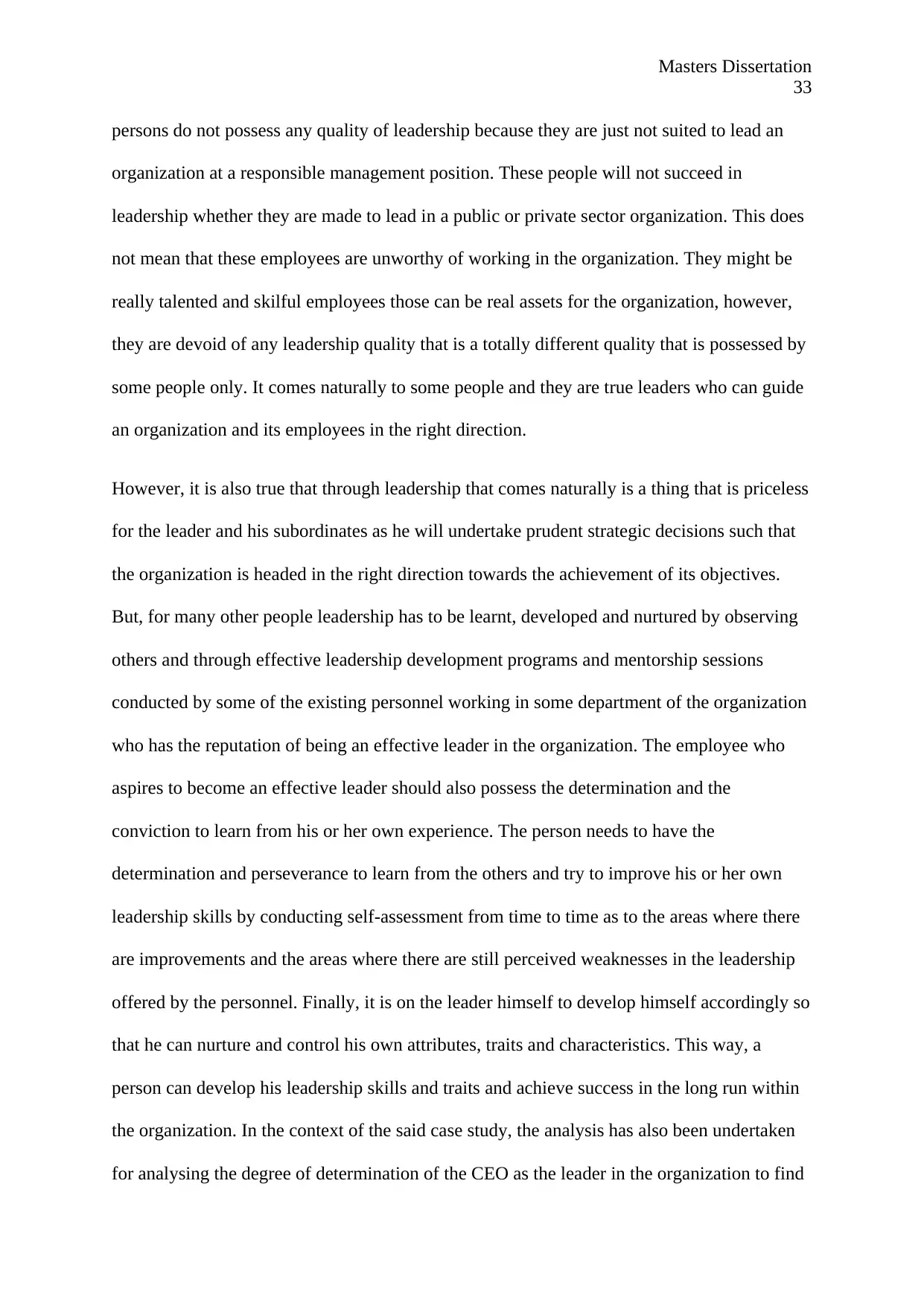
Masters Dissertation
33
persons do not possess any quality of leadership because they are just not suited to lead an
organization at a responsible management position. These people will not succeed in
leadership whether they are made to lead in a public or private sector organization. This does
not mean that these employees are unworthy of working in the organization. They might be
really talented and skilful employees those can be real assets for the organization, however,
they are devoid of any leadership quality that is a totally different quality that is possessed by
some people only. It comes naturally to some people and they are true leaders who can guide
an organization and its employees in the right direction.
However, it is also true that through leadership that comes naturally is a thing that is priceless
for the leader and his subordinates as he will undertake prudent strategic decisions such that
the organization is headed in the right direction towards the achievement of its objectives.
But, for many other people leadership has to be learnt, developed and nurtured by observing
others and through effective leadership development programs and mentorship sessions
conducted by some of the existing personnel working in some department of the organization
who has the reputation of being an effective leader in the organization. The employee who
aspires to become an effective leader should also possess the determination and the
conviction to learn from his or her own experience. The person needs to have the
determination and perseverance to learn from the others and try to improve his or her own
leadership skills by conducting self-assessment from time to time as to the areas where there
are improvements and the areas where there are still perceived weaknesses in the leadership
offered by the personnel. Finally, it is on the leader himself to develop himself accordingly so
that he can nurture and control his own attributes, traits and characteristics. This way, a
person can develop his leadership skills and traits and achieve success in the long run within
the organization. In the context of the said case study, the analysis has also been undertaken
for analysing the degree of determination of the CEO as the leader in the organization to find
33
persons do not possess any quality of leadership because they are just not suited to lead an
organization at a responsible management position. These people will not succeed in
leadership whether they are made to lead in a public or private sector organization. This does
not mean that these employees are unworthy of working in the organization. They might be
really talented and skilful employees those can be real assets for the organization, however,
they are devoid of any leadership quality that is a totally different quality that is possessed by
some people only. It comes naturally to some people and they are true leaders who can guide
an organization and its employees in the right direction.
However, it is also true that through leadership that comes naturally is a thing that is priceless
for the leader and his subordinates as he will undertake prudent strategic decisions such that
the organization is headed in the right direction towards the achievement of its objectives.
But, for many other people leadership has to be learnt, developed and nurtured by observing
others and through effective leadership development programs and mentorship sessions
conducted by some of the existing personnel working in some department of the organization
who has the reputation of being an effective leader in the organization. The employee who
aspires to become an effective leader should also possess the determination and the
conviction to learn from his or her own experience. The person needs to have the
determination and perseverance to learn from the others and try to improve his or her own
leadership skills by conducting self-assessment from time to time as to the areas where there
are improvements and the areas where there are still perceived weaknesses in the leadership
offered by the personnel. Finally, it is on the leader himself to develop himself accordingly so
that he can nurture and control his own attributes, traits and characteristics. This way, a
person can develop his leadership skills and traits and achieve success in the long run within
the organization. In the context of the said case study, the analysis has also been undertaken
for analysing the degree of determination of the CEO as the leader in the organization to find
Paraphrase This Document
Need a fresh take? Get an instant paraphrase of this document with our AI Paraphraser

Masters Dissertation
34
out if he possessed the desire and zeal to succeed as a leader in the long run, even though
initially he has met up with some strategic failures.
34
out if he possessed the desire and zeal to succeed as a leader in the long run, even though
initially he has met up with some strategic failures.
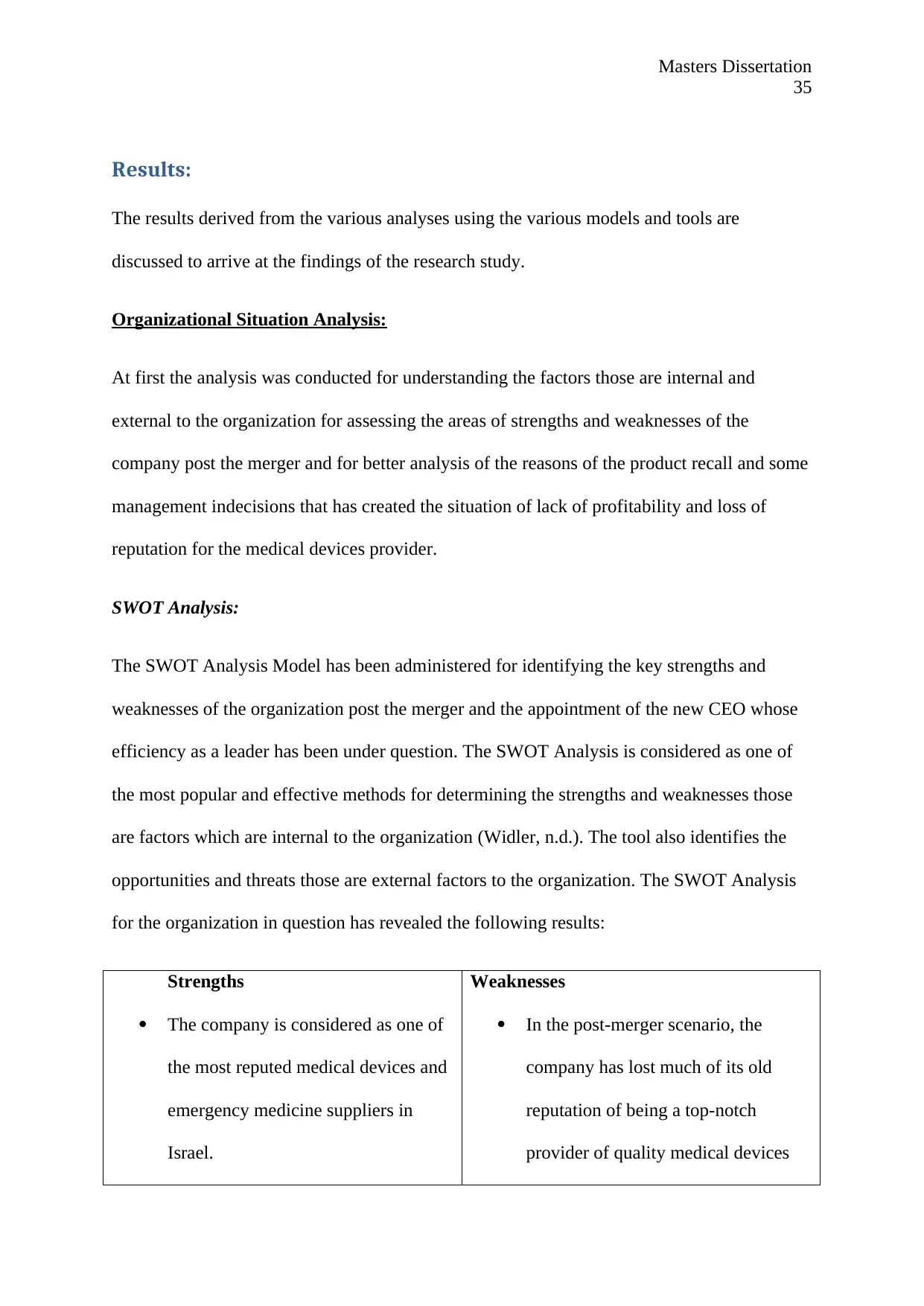
Masters Dissertation
35
Results:
The results derived from the various analyses using the various models and tools are
discussed to arrive at the findings of the research study.
Organizational Situation Analysis:
At first the analysis was conducted for understanding the factors those are internal and
external to the organization for assessing the areas of strengths and weaknesses of the
company post the merger and for better analysis of the reasons of the product recall and some
management indecisions that has created the situation of lack of profitability and loss of
reputation for the medical devices provider.
SWOT Analysis:
The SWOT Analysis Model has been administered for identifying the key strengths and
weaknesses of the organization post the merger and the appointment of the new CEO whose
efficiency as a leader has been under question. The SWOT Analysis is considered as one of
the most popular and effective methods for determining the strengths and weaknesses those
are factors which are internal to the organization (Widler, n.d.). The tool also identifies the
opportunities and threats those are external factors to the organization. The SWOT Analysis
for the organization in question has revealed the following results:
Strengths
The company is considered as one of
the most reputed medical devices and
emergency medicine suppliers in
Israel.
Weaknesses
In the post-merger scenario, the
company has lost much of its old
reputation of being a top-notch
provider of quality medical devices
35
Results:
The results derived from the various analyses using the various models and tools are
discussed to arrive at the findings of the research study.
Organizational Situation Analysis:
At first the analysis was conducted for understanding the factors those are internal and
external to the organization for assessing the areas of strengths and weaknesses of the
company post the merger and for better analysis of the reasons of the product recall and some
management indecisions that has created the situation of lack of profitability and loss of
reputation for the medical devices provider.
SWOT Analysis:
The SWOT Analysis Model has been administered for identifying the key strengths and
weaknesses of the organization post the merger and the appointment of the new CEO whose
efficiency as a leader has been under question. The SWOT Analysis is considered as one of
the most popular and effective methods for determining the strengths and weaknesses those
are factors which are internal to the organization (Widler, n.d.). The tool also identifies the
opportunities and threats those are external factors to the organization. The SWOT Analysis
for the organization in question has revealed the following results:
Strengths
The company is considered as one of
the most reputed medical devices and
emergency medicine suppliers in
Israel.
Weaknesses
In the post-merger scenario, the
company has lost much of its old
reputation of being a top-notch
provider of quality medical devices

Masters Dissertation
36
The organization is also extremely
well-known round the world in
countries such as the US and in the
Indo-Chinese regions.
The company has built on its good
reputation and before the merger with
the supplier in 2014, the management
was known to be quite efficient and
effective from the perspectives of
leadership and strategic decision-
making due to which the enterprise
not only expanded in the domestic
market but was also successful in
selling its products in foreign
markets.
The brand has achieved a unique
position in the market owing to its
years of successful products and
services those were considered to be
of the highest possible qualities and
the after sales services were also
impeccable.
and emergency medicines owing to
some organizational changes and
management alterations.
Under the newly appointed CEO, the
company has been operating for two
and a half years after the merger has
taken place but in August 2016, the
company had to recall one of its core
and most reputed products as a result
of malfunctioning of the device as
complained by several customers.
On an in-depth analysis of the root
cause it was identified that the prime
reason for such malfunctioning was
the inferior quality of raw material
purchased that was used in the
production.
Opportunities
There is sufficient scope for
improvement in the domain of
Threats
The major threat that has concerned
the management of late has been the
36
The organization is also extremely
well-known round the world in
countries such as the US and in the
Indo-Chinese regions.
The company has built on its good
reputation and before the merger with
the supplier in 2014, the management
was known to be quite efficient and
effective from the perspectives of
leadership and strategic decision-
making due to which the enterprise
not only expanded in the domestic
market but was also successful in
selling its products in foreign
markets.
The brand has achieved a unique
position in the market owing to its
years of successful products and
services those were considered to be
of the highest possible qualities and
the after sales services were also
impeccable.
and emergency medicines owing to
some organizational changes and
management alterations.
Under the newly appointed CEO, the
company has been operating for two
and a half years after the merger has
taken place but in August 2016, the
company had to recall one of its core
and most reputed products as a result
of malfunctioning of the device as
complained by several customers.
On an in-depth analysis of the root
cause it was identified that the prime
reason for such malfunctioning was
the inferior quality of raw material
purchased that was used in the
production.
Opportunities
There is sufficient scope for
improvement in the domain of
Threats
The major threat that has concerned
the management of late has been the
Secure Best Marks with AI Grader
Need help grading? Try our AI Grader for instant feedback on your assignments.
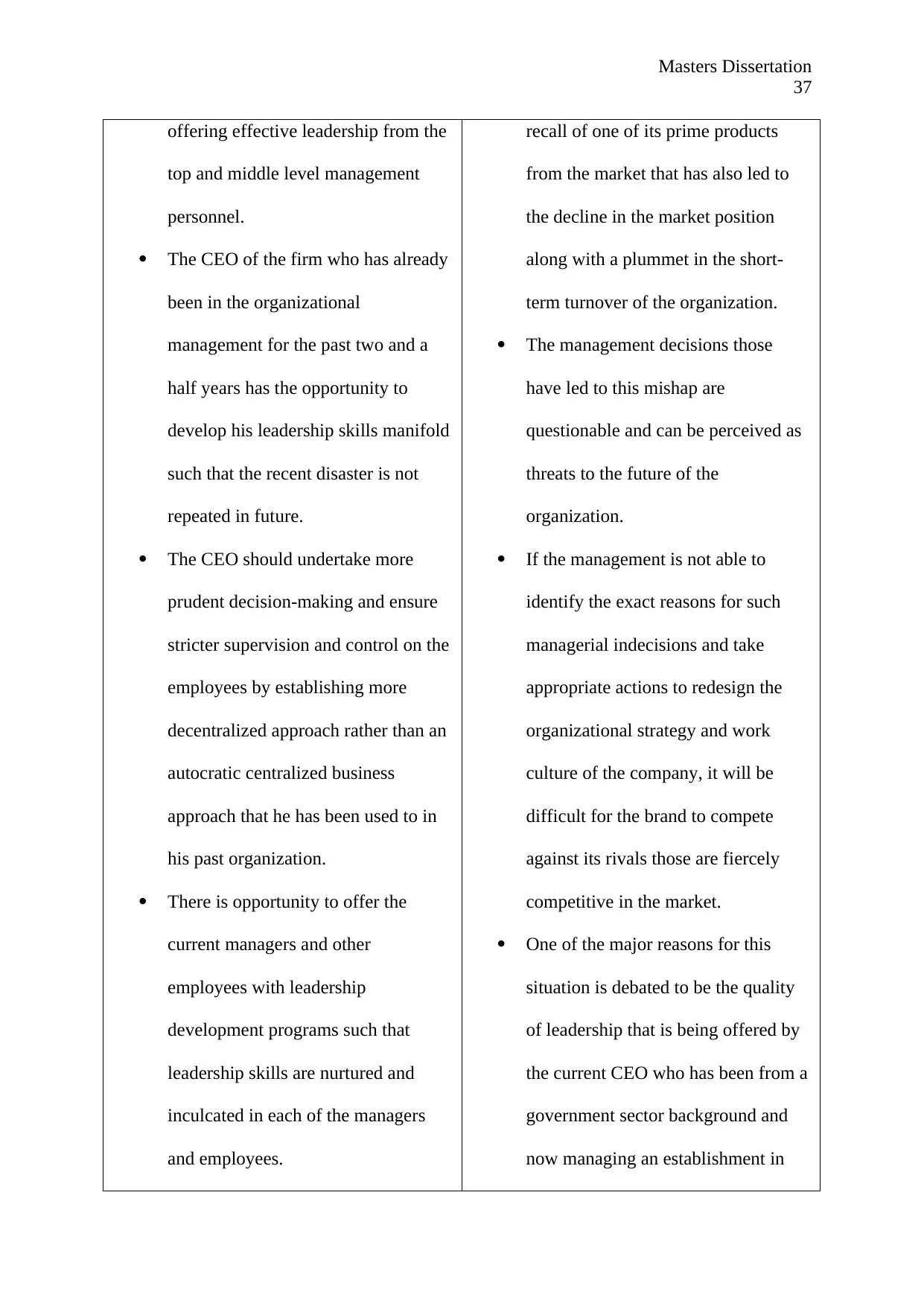
Masters Dissertation
37
offering effective leadership from the
top and middle level management
personnel.
The CEO of the firm who has already
been in the organizational
management for the past two and a
half years has the opportunity to
develop his leadership skills manifold
such that the recent disaster is not
repeated in future.
The CEO should undertake more
prudent decision-making and ensure
stricter supervision and control on the
employees by establishing more
decentralized approach rather than an
autocratic centralized business
approach that he has been used to in
his past organization.
There is opportunity to offer the
current managers and other
employees with leadership
development programs such that
leadership skills are nurtured and
inculcated in each of the managers
and employees.
recall of one of its prime products
from the market that has also led to
the decline in the market position
along with a plummet in the short-
term turnover of the organization.
The management decisions those
have led to this mishap are
questionable and can be perceived as
threats to the future of the
organization.
If the management is not able to
identify the exact reasons for such
managerial indecisions and take
appropriate actions to redesign the
organizational strategy and work
culture of the company, it will be
difficult for the brand to compete
against its rivals those are fiercely
competitive in the market.
One of the major reasons for this
situation is debated to be the quality
of leadership that is being offered by
the current CEO who has been from a
government sector background and
now managing an establishment in
37
offering effective leadership from the
top and middle level management
personnel.
The CEO of the firm who has already
been in the organizational
management for the past two and a
half years has the opportunity to
develop his leadership skills manifold
such that the recent disaster is not
repeated in future.
The CEO should undertake more
prudent decision-making and ensure
stricter supervision and control on the
employees by establishing more
decentralized approach rather than an
autocratic centralized business
approach that he has been used to in
his past organization.
There is opportunity to offer the
current managers and other
employees with leadership
development programs such that
leadership skills are nurtured and
inculcated in each of the managers
and employees.
recall of one of its prime products
from the market that has also led to
the decline in the market position
along with a plummet in the short-
term turnover of the organization.
The management decisions those
have led to this mishap are
questionable and can be perceived as
threats to the future of the
organization.
If the management is not able to
identify the exact reasons for such
managerial indecisions and take
appropriate actions to redesign the
organizational strategy and work
culture of the company, it will be
difficult for the brand to compete
against its rivals those are fiercely
competitive in the market.
One of the major reasons for this
situation is debated to be the quality
of leadership that is being offered by
the current CEO who has been from a
government sector background and
now managing an establishment in
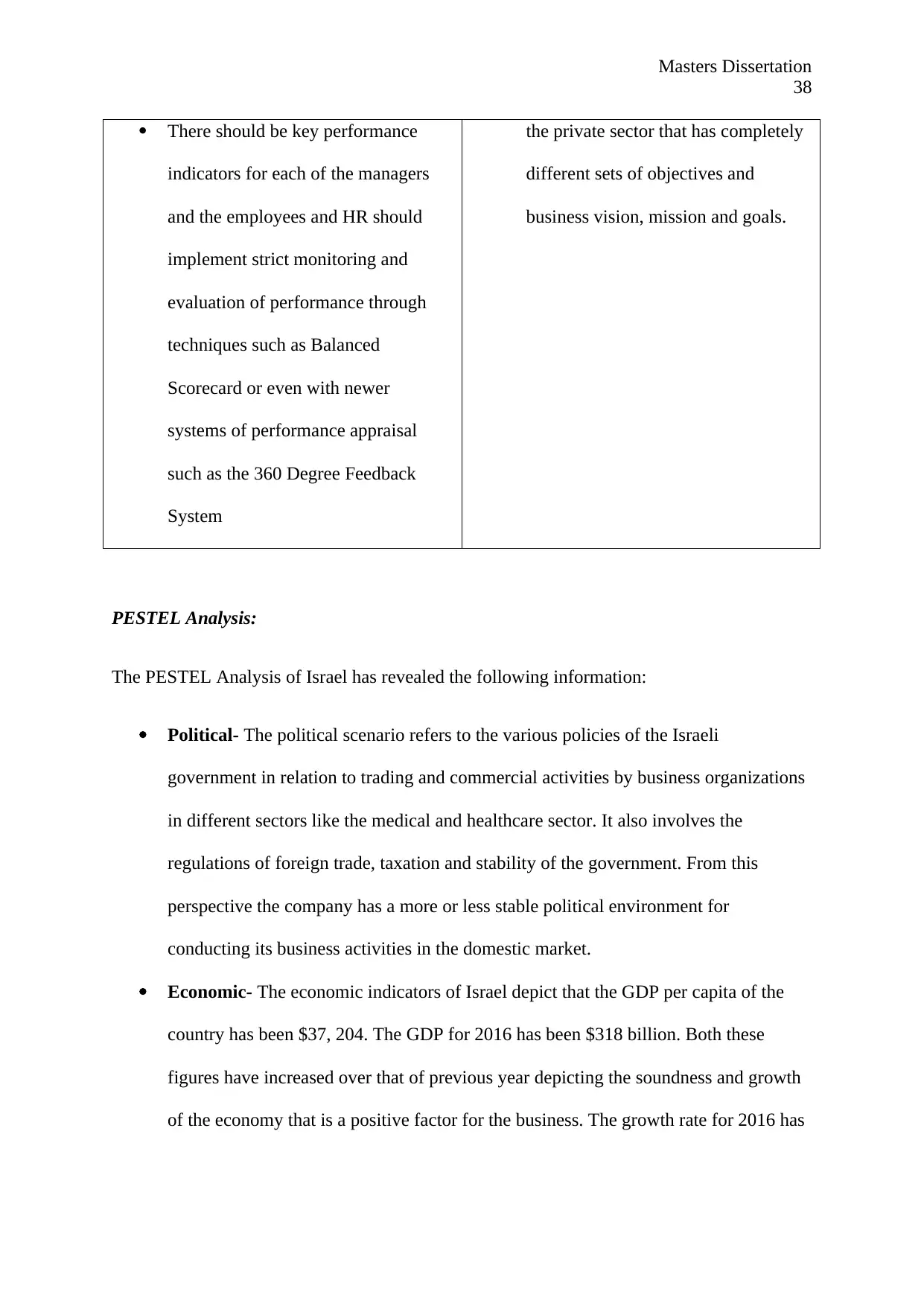
Masters Dissertation
38
There should be key performance
indicators for each of the managers
and the employees and HR should
implement strict monitoring and
evaluation of performance through
techniques such as Balanced
Scorecard or even with newer
systems of performance appraisal
such as the 360 Degree Feedback
System
the private sector that has completely
different sets of objectives and
business vision, mission and goals.
PESTEL Analysis:
The PESTEL Analysis of Israel has revealed the following information:
Political- The political scenario refers to the various policies of the Israeli
government in relation to trading and commercial activities by business organizations
in different sectors like the medical and healthcare sector. It also involves the
regulations of foreign trade, taxation and stability of the government. From this
perspective the company has a more or less stable political environment for
conducting its business activities in the domestic market.
Economic- The economic indicators of Israel depict that the GDP per capita of the
country has been $37, 204. The GDP for 2016 has been $318 billion. Both these
figures have increased over that of previous year depicting the soundness and growth
of the economy that is a positive factor for the business. The growth rate for 2016 has
38
There should be key performance
indicators for each of the managers
and the employees and HR should
implement strict monitoring and
evaluation of performance through
techniques such as Balanced
Scorecard or even with newer
systems of performance appraisal
such as the 360 Degree Feedback
System
the private sector that has completely
different sets of objectives and
business vision, mission and goals.
PESTEL Analysis:
The PESTEL Analysis of Israel has revealed the following information:
Political- The political scenario refers to the various policies of the Israeli
government in relation to trading and commercial activities by business organizations
in different sectors like the medical and healthcare sector. It also involves the
regulations of foreign trade, taxation and stability of the government. From this
perspective the company has a more or less stable political environment for
conducting its business activities in the domestic market.
Economic- The economic indicators of Israel depict that the GDP per capita of the
country has been $37, 204. The GDP for 2016 has been $318 billion. Both these
figures have increased over that of previous year depicting the soundness and growth
of the economy that is a positive factor for the business. The growth rate for 2016 has

Masters Dissertation
39
been 4% in place of 2.6% in 2015. Hence, the economic growth and progress of the
country is quite evident (Focus Economics, 2017).
Socio-cultural- The socio-cultural scenario of Israel consist of issues such as lack of
adequate skilled labour supply. There is lack of overall educational progress as should
have been in a developing country. The country has a young population with stable
social structures in general. There is observance of cultural diversity in the country
and most importantly a growing and developing nation with a progressive cultural
outlook. These are positive scenarios for the business to operate.
Technological- The country has progressed over the years from the technological
perspective. The government is supportive of new and state-of-the-art technology.
There has been increasing instances of automation in majority of the organizations.
Environmental- The organization has to abide by the environmental regulations and
aim to achieve sustainability in the long run. For this purpose it needs to function as
per the infrastructure that is made available by the government for the particular
industry. There needs to be proper recycling of the materials those are used in the
production of the medical devices.
Legal- The legal requirements need to be observed by the organization operating in
the country such as complete and authentic registration of the company with the
Registrar of Companies. The Memorandum and Articles of Association should be
then provided along with a list of company’s directors and all the other required
documents. The company has to follow the tax rates levied by the government on
various trading activities (Phan, 2015).
Leadership Traits Analysis:
39
been 4% in place of 2.6% in 2015. Hence, the economic growth and progress of the
country is quite evident (Focus Economics, 2017).
Socio-cultural- The socio-cultural scenario of Israel consist of issues such as lack of
adequate skilled labour supply. There is lack of overall educational progress as should
have been in a developing country. The country has a young population with stable
social structures in general. There is observance of cultural diversity in the country
and most importantly a growing and developing nation with a progressive cultural
outlook. These are positive scenarios for the business to operate.
Technological- The country has progressed over the years from the technological
perspective. The government is supportive of new and state-of-the-art technology.
There has been increasing instances of automation in majority of the organizations.
Environmental- The organization has to abide by the environmental regulations and
aim to achieve sustainability in the long run. For this purpose it needs to function as
per the infrastructure that is made available by the government for the particular
industry. There needs to be proper recycling of the materials those are used in the
production of the medical devices.
Legal- The legal requirements need to be observed by the organization operating in
the country such as complete and authentic registration of the company with the
Registrar of Companies. The Memorandum and Articles of Association should be
then provided along with a list of company’s directors and all the other required
documents. The company has to follow the tax rates levied by the government on
various trading activities (Phan, 2015).
Leadership Traits Analysis:
Paraphrase This Document
Need a fresh take? Get an instant paraphrase of this document with our AI Paraphraser
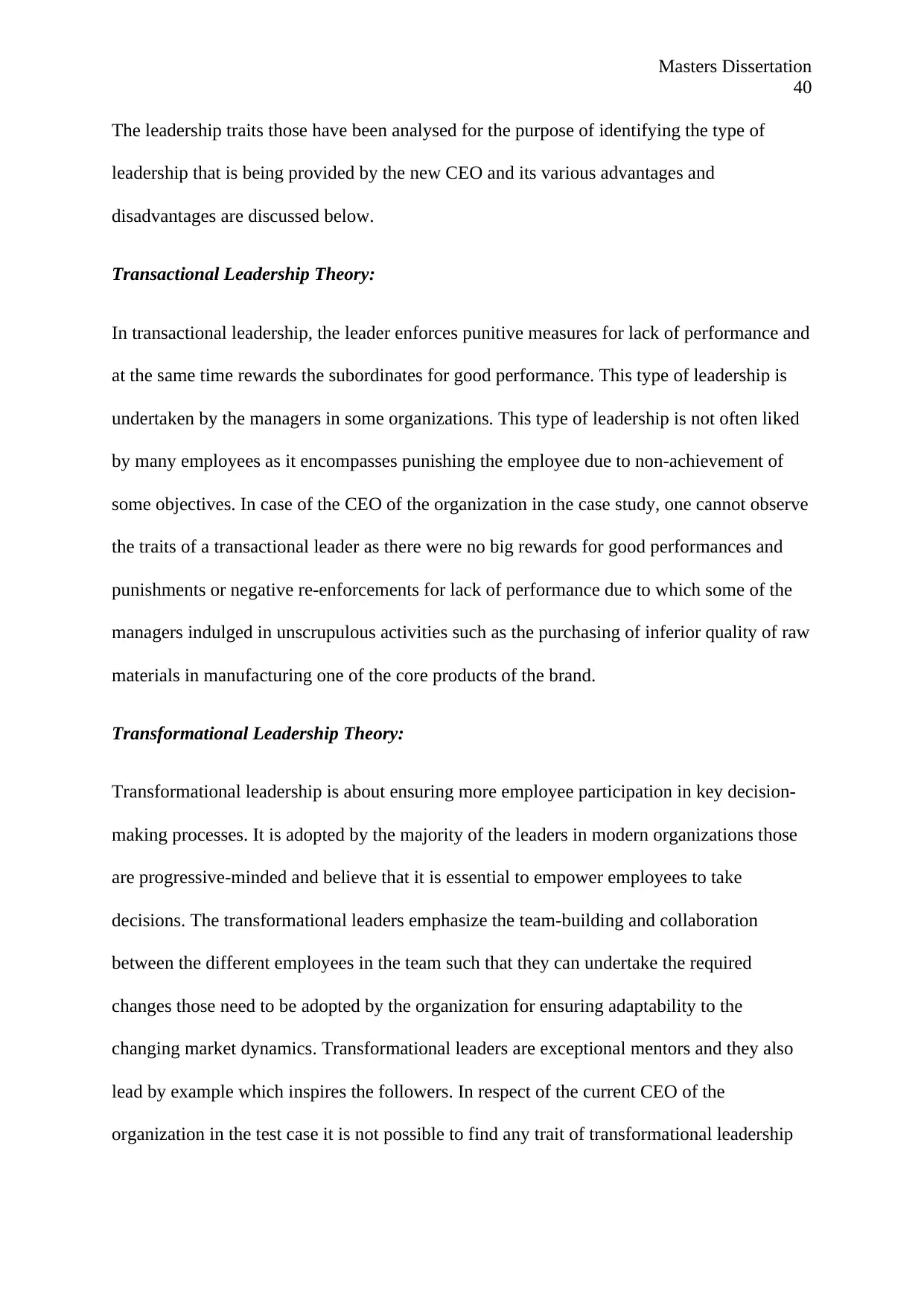
Masters Dissertation
40
The leadership traits those have been analysed for the purpose of identifying the type of
leadership that is being provided by the new CEO and its various advantages and
disadvantages are discussed below.
Transactional Leadership Theory:
In transactional leadership, the leader enforces punitive measures for lack of performance and
at the same time rewards the subordinates for good performance. This type of leadership is
undertaken by the managers in some organizations. This type of leadership is not often liked
by many employees as it encompasses punishing the employee due to non-achievement of
some objectives. In case of the CEO of the organization in the case study, one cannot observe
the traits of a transactional leader as there were no big rewards for good performances and
punishments or negative re-enforcements for lack of performance due to which some of the
managers indulged in unscrupulous activities such as the purchasing of inferior quality of raw
materials in manufacturing one of the core products of the brand.
Transformational Leadership Theory:
Transformational leadership is about ensuring more employee participation in key decision-
making processes. It is adopted by the majority of the leaders in modern organizations those
are progressive-minded and believe that it is essential to empower employees to take
decisions. The transformational leaders emphasize the team-building and collaboration
between the different employees in the team such that they can undertake the required
changes those need to be adopted by the organization for ensuring adaptability to the
changing market dynamics. Transformational leaders are exceptional mentors and they also
lead by example which inspires the followers. In respect of the current CEO of the
organization in the test case it is not possible to find any trait of transformational leadership
40
The leadership traits those have been analysed for the purpose of identifying the type of
leadership that is being provided by the new CEO and its various advantages and
disadvantages are discussed below.
Transactional Leadership Theory:
In transactional leadership, the leader enforces punitive measures for lack of performance and
at the same time rewards the subordinates for good performance. This type of leadership is
undertaken by the managers in some organizations. This type of leadership is not often liked
by many employees as it encompasses punishing the employee due to non-achievement of
some objectives. In case of the CEO of the organization in the case study, one cannot observe
the traits of a transactional leader as there were no big rewards for good performances and
punishments or negative re-enforcements for lack of performance due to which some of the
managers indulged in unscrupulous activities such as the purchasing of inferior quality of raw
materials in manufacturing one of the core products of the brand.
Transformational Leadership Theory:
Transformational leadership is about ensuring more employee participation in key decision-
making processes. It is adopted by the majority of the leaders in modern organizations those
are progressive-minded and believe that it is essential to empower employees to take
decisions. The transformational leaders emphasize the team-building and collaboration
between the different employees in the team such that they can undertake the required
changes those need to be adopted by the organization for ensuring adaptability to the
changing market dynamics. Transformational leaders are exceptional mentors and they also
lead by example which inspires the followers. In respect of the current CEO of the
organization in the test case it is not possible to find any trait of transformational leadership
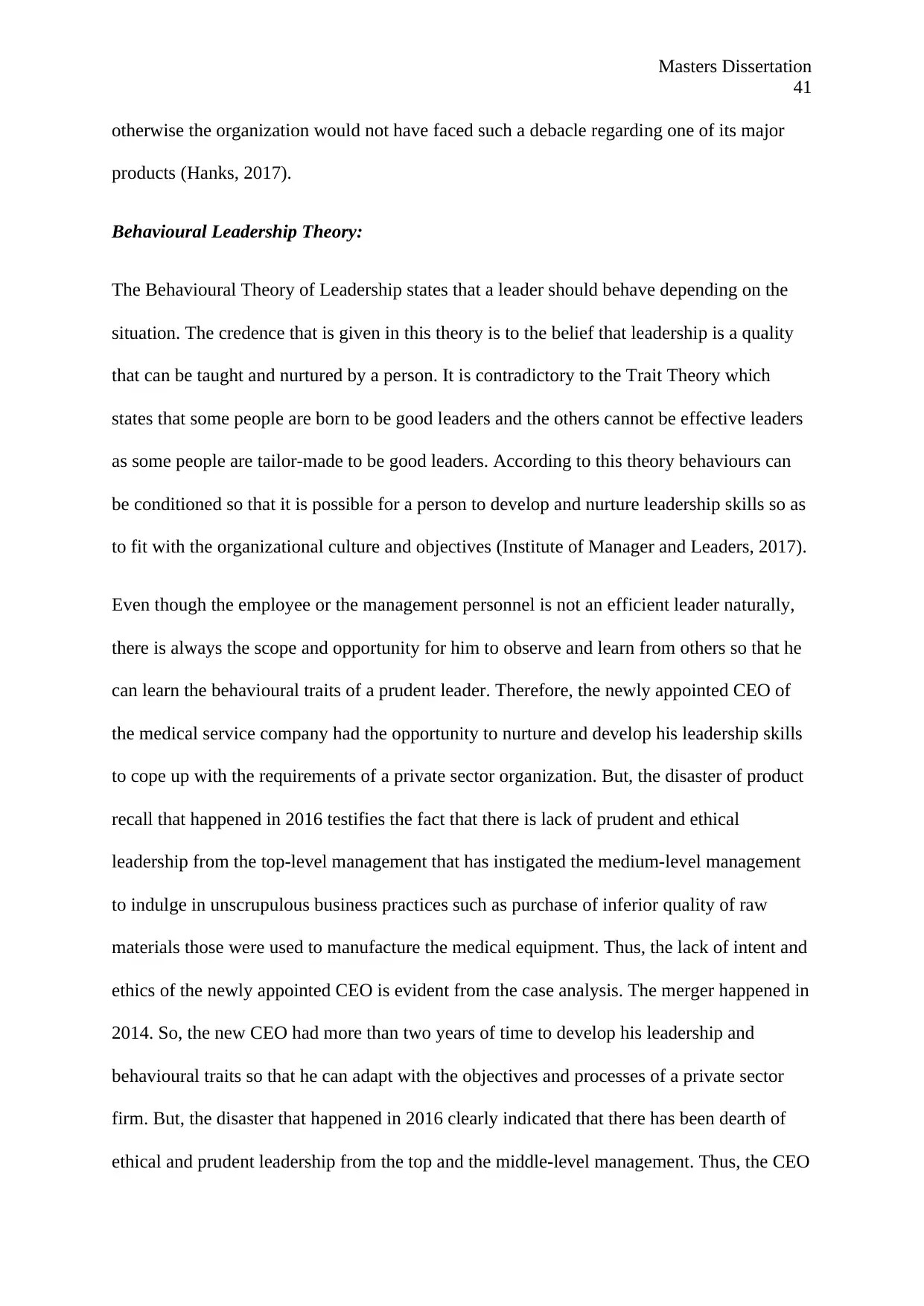
Masters Dissertation
41
otherwise the organization would not have faced such a debacle regarding one of its major
products (Hanks, 2017).
Behavioural Leadership Theory:
The Behavioural Theory of Leadership states that a leader should behave depending on the
situation. The credence that is given in this theory is to the belief that leadership is a quality
that can be taught and nurtured by a person. It is contradictory to the Trait Theory which
states that some people are born to be good leaders and the others cannot be effective leaders
as some people are tailor-made to be good leaders. According to this theory behaviours can
be conditioned so that it is possible for a person to develop and nurture leadership skills so as
to fit with the organizational culture and objectives (Institute of Manager and Leaders, 2017).
Even though the employee or the management personnel is not an efficient leader naturally,
there is always the scope and opportunity for him to observe and learn from others so that he
can learn the behavioural traits of a prudent leader. Therefore, the newly appointed CEO of
the medical service company had the opportunity to nurture and develop his leadership skills
to cope up with the requirements of a private sector organization. But, the disaster of product
recall that happened in 2016 testifies the fact that there is lack of prudent and ethical
leadership from the top-level management that has instigated the medium-level management
to indulge in unscrupulous business practices such as purchase of inferior quality of raw
materials those were used to manufacture the medical equipment. Thus, the lack of intent and
ethics of the newly appointed CEO is evident from the case analysis. The merger happened in
2014. So, the new CEO had more than two years of time to develop his leadership and
behavioural traits so that he can adapt with the objectives and processes of a private sector
firm. But, the disaster that happened in 2016 clearly indicated that there has been dearth of
ethical and prudent leadership from the top and the middle-level management. Thus, the CEO
41
otherwise the organization would not have faced such a debacle regarding one of its major
products (Hanks, 2017).
Behavioural Leadership Theory:
The Behavioural Theory of Leadership states that a leader should behave depending on the
situation. The credence that is given in this theory is to the belief that leadership is a quality
that can be taught and nurtured by a person. It is contradictory to the Trait Theory which
states that some people are born to be good leaders and the others cannot be effective leaders
as some people are tailor-made to be good leaders. According to this theory behaviours can
be conditioned so that it is possible for a person to develop and nurture leadership skills so as
to fit with the organizational culture and objectives (Institute of Manager and Leaders, 2017).
Even though the employee or the management personnel is not an efficient leader naturally,
there is always the scope and opportunity for him to observe and learn from others so that he
can learn the behavioural traits of a prudent leader. Therefore, the newly appointed CEO of
the medical service company had the opportunity to nurture and develop his leadership skills
to cope up with the requirements of a private sector organization. But, the disaster of product
recall that happened in 2016 testifies the fact that there is lack of prudent and ethical
leadership from the top-level management that has instigated the medium-level management
to indulge in unscrupulous business practices such as purchase of inferior quality of raw
materials those were used to manufacture the medical equipment. Thus, the lack of intent and
ethics of the newly appointed CEO is evident from the case analysis. The merger happened in
2014. So, the new CEO had more than two years of time to develop his leadership and
behavioural traits so that he can adapt with the objectives and processes of a private sector
firm. But, the disaster that happened in 2016 clearly indicated that there has been dearth of
ethical and prudent leadership from the top and the middle-level management. Thus, the CEO
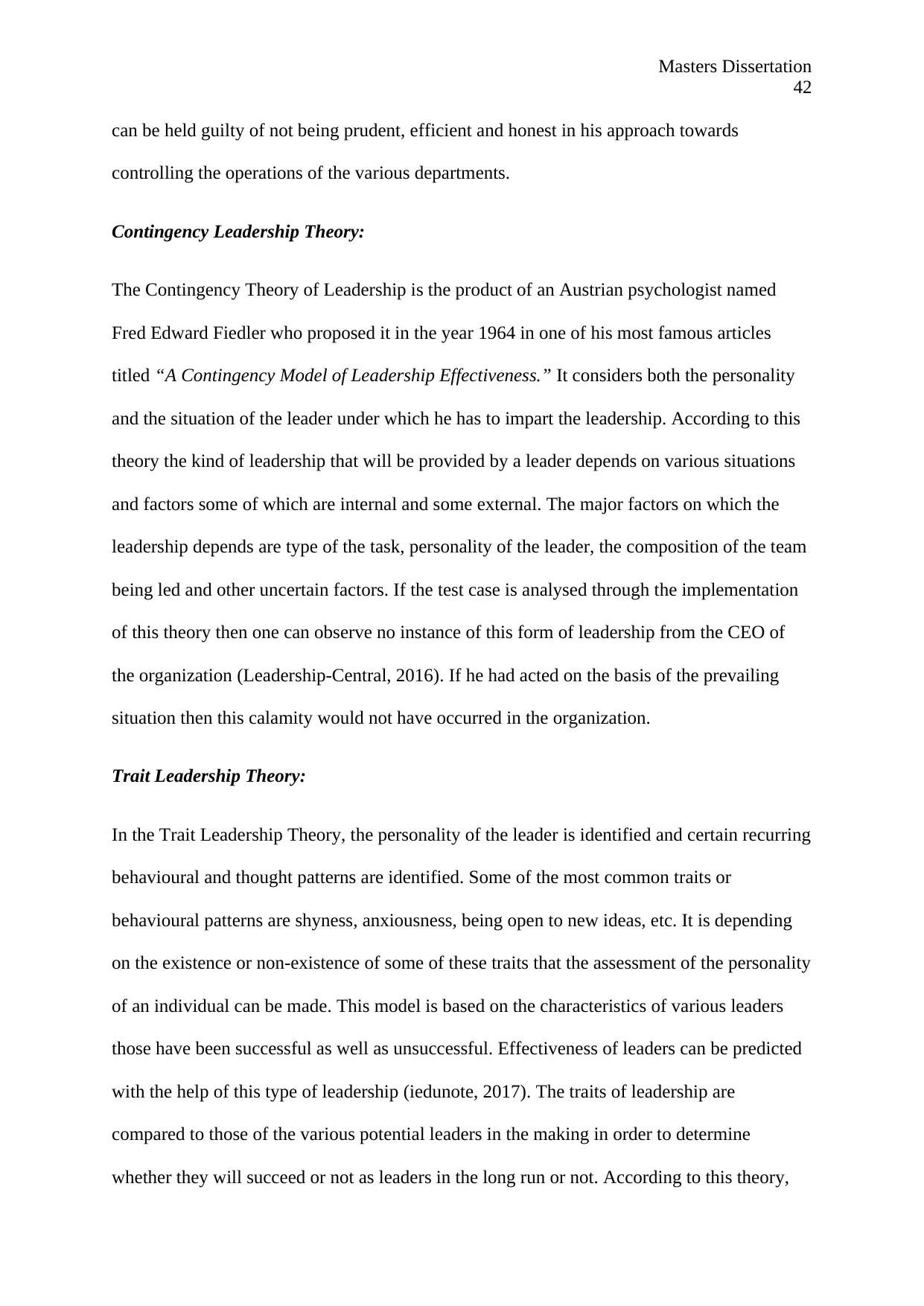
Masters Dissertation
42
can be held guilty of not being prudent, efficient and honest in his approach towards
controlling the operations of the various departments.
Contingency Leadership Theory:
The Contingency Theory of Leadership is the product of an Austrian psychologist named
Fred Edward Fiedler who proposed it in the year 1964 in one of his most famous articles
titled “A Contingency Model of Leadership Effectiveness.” It considers both the personality
and the situation of the leader under which he has to impart the leadership. According to this
theory the kind of leadership that will be provided by a leader depends on various situations
and factors some of which are internal and some external. The major factors on which the
leadership depends are type of the task, personality of the leader, the composition of the team
being led and other uncertain factors. If the test case is analysed through the implementation
of this theory then one can observe no instance of this form of leadership from the CEO of
the organization (Leadership-Central, 2016). If he had acted on the basis of the prevailing
situation then this calamity would not have occurred in the organization.
Trait Leadership Theory:
In the Trait Leadership Theory, the personality of the leader is identified and certain recurring
behavioural and thought patterns are identified. Some of the most common traits or
behavioural patterns are shyness, anxiousness, being open to new ideas, etc. It is depending
on the existence or non-existence of some of these traits that the assessment of the personality
of an individual can be made. This model is based on the characteristics of various leaders
those have been successful as well as unsuccessful. Effectiveness of leaders can be predicted
with the help of this type of leadership (iedunote, 2017). The traits of leadership are
compared to those of the various potential leaders in the making in order to determine
whether they will succeed or not as leaders in the long run or not. According to this theory,
42
can be held guilty of not being prudent, efficient and honest in his approach towards
controlling the operations of the various departments.
Contingency Leadership Theory:
The Contingency Theory of Leadership is the product of an Austrian psychologist named
Fred Edward Fiedler who proposed it in the year 1964 in one of his most famous articles
titled “A Contingency Model of Leadership Effectiveness.” It considers both the personality
and the situation of the leader under which he has to impart the leadership. According to this
theory the kind of leadership that will be provided by a leader depends on various situations
and factors some of which are internal and some external. The major factors on which the
leadership depends are type of the task, personality of the leader, the composition of the team
being led and other uncertain factors. If the test case is analysed through the implementation
of this theory then one can observe no instance of this form of leadership from the CEO of
the organization (Leadership-Central, 2016). If he had acted on the basis of the prevailing
situation then this calamity would not have occurred in the organization.
Trait Leadership Theory:
In the Trait Leadership Theory, the personality of the leader is identified and certain recurring
behavioural and thought patterns are identified. Some of the most common traits or
behavioural patterns are shyness, anxiousness, being open to new ideas, etc. It is depending
on the existence or non-existence of some of these traits that the assessment of the personality
of an individual can be made. This model is based on the characteristics of various leaders
those have been successful as well as unsuccessful. Effectiveness of leaders can be predicted
with the help of this type of leadership (iedunote, 2017). The traits of leadership are
compared to those of the various potential leaders in the making in order to determine
whether they will succeed or not as leaders in the long run or not. According to this theory,
Secure Best Marks with AI Grader
Need help grading? Try our AI Grader for instant feedback on your assignments.

Masters Dissertation
43
there are some major traits those separate a leader from a non-leader. There are six major
traits such as drive, desire for leading, self-confidence, integrity and honesty, knowledge and
skills relevant to the job and intelligence. Now, coming back to the analysis of the leadership
of the newly appointed CEO, it can be said that there is evidence of lack of effective
leadership traits that could make him an effective leader. This could be either because of the
difference in background in terms of coming from government sector and leading in a private
sector organization or because of the lack of innate leadership ability or both.
Great Man Leadership Theory:
This theory of leadership originated in the 19th century when it was propounded by Thomas
Carlyle in 1840. According to this theory history can be defined by the acts of great men such
who have proved to be heroes. The theory establishes that our history has been shaped by the
heroic deeds of great leaders such as Napoleon, Alexander, Churchill, Roosevelt, Hitler,
Mussolini, Stalin and a host of others. These leaders have used their wisdom, intelligence,
charisma and Machiavellianism used the power and authority to make impacts in the world
history (Faversham Stoa, 2017). This theory also puts forward that it is the personal attribute
and a divine inspiration that makes a person a great leader that has contributed significantly
towards the benefit or development of the society or community. So, leadership in this
context is observed as an aggregate of some of the unique unparalleled skills, traits and
qualities those tend to distinguish a leader from a non-leader. If the analysis is based on this
type of leadership, then looking back onto the case of the organization and its CEO depicts no
such instances of leadership that is developed on the premises of the great man theory. The
CEO has failed in making the desired impact on the organization and its future business
strategies. This can be due to a host of factors such as personal lacking of leadership skills or
43
there are some major traits those separate a leader from a non-leader. There are six major
traits such as drive, desire for leading, self-confidence, integrity and honesty, knowledge and
skills relevant to the job and intelligence. Now, coming back to the analysis of the leadership
of the newly appointed CEO, it can be said that there is evidence of lack of effective
leadership traits that could make him an effective leader. This could be either because of the
difference in background in terms of coming from government sector and leading in a private
sector organization or because of the lack of innate leadership ability or both.
Great Man Leadership Theory:
This theory of leadership originated in the 19th century when it was propounded by Thomas
Carlyle in 1840. According to this theory history can be defined by the acts of great men such
who have proved to be heroes. The theory establishes that our history has been shaped by the
heroic deeds of great leaders such as Napoleon, Alexander, Churchill, Roosevelt, Hitler,
Mussolini, Stalin and a host of others. These leaders have used their wisdom, intelligence,
charisma and Machiavellianism used the power and authority to make impacts in the world
history (Faversham Stoa, 2017). This theory also puts forward that it is the personal attribute
and a divine inspiration that makes a person a great leader that has contributed significantly
towards the benefit or development of the society or community. So, leadership in this
context is observed as an aggregate of some of the unique unparalleled skills, traits and
qualities those tend to distinguish a leader from a non-leader. If the analysis is based on this
type of leadership, then looking back onto the case of the organization and its CEO depicts no
such instances of leadership that is developed on the premises of the great man theory. The
CEO has failed in making the desired impact on the organization and its future business
strategies. This can be due to a host of factors such as personal lacking of leadership skills or
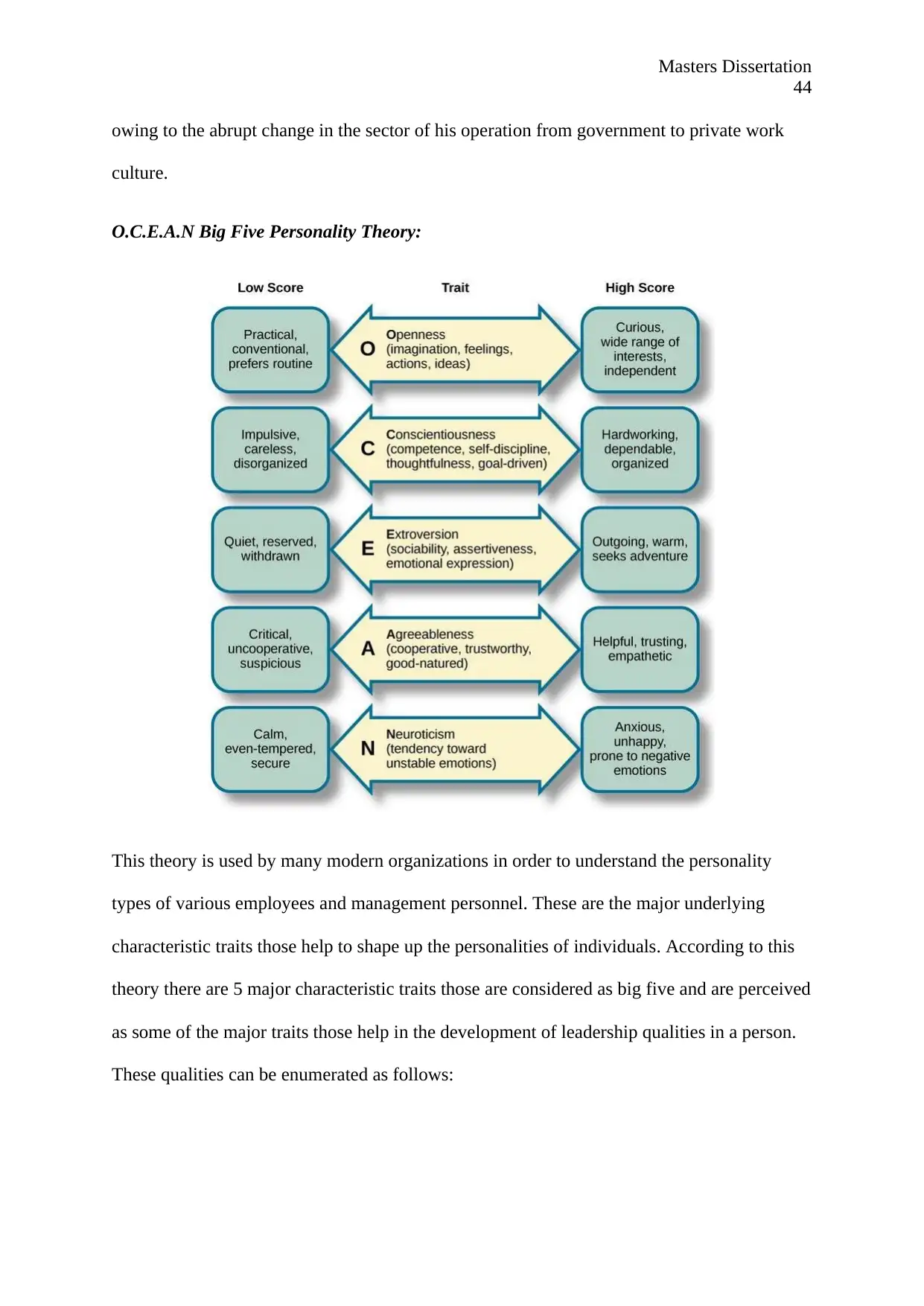
Masters Dissertation
44
owing to the abrupt change in the sector of his operation from government to private work
culture.
O.C.E.A.N Big Five Personality Theory:
This theory is used by many modern organizations in order to understand the personality
types of various employees and management personnel. These are the major underlying
characteristic traits those help to shape up the personalities of individuals. According to this
theory there are 5 major characteristic traits those are considered as big five and are perceived
as some of the major traits those help in the development of leadership qualities in a person.
These qualities can be enumerated as follows:
44
owing to the abrupt change in the sector of his operation from government to private work
culture.
O.C.E.A.N Big Five Personality Theory:
This theory is used by many modern organizations in order to understand the personality
types of various employees and management personnel. These are the major underlying
characteristic traits those help to shape up the personalities of individuals. According to this
theory there are 5 major characteristic traits those are considered as big five and are perceived
as some of the major traits those help in the development of leadership qualities in a person.
These qualities can be enumerated as follows:
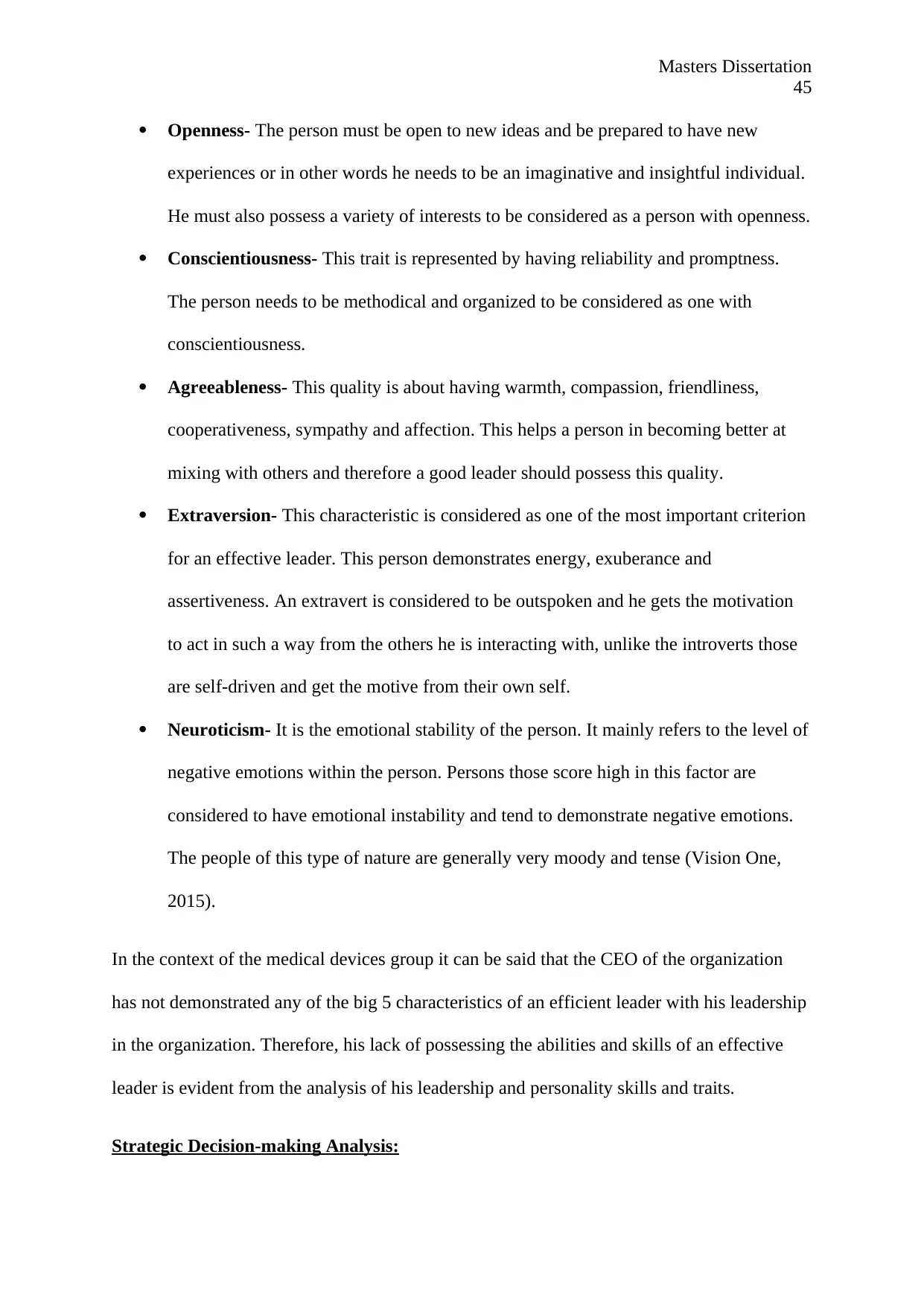
Masters Dissertation
45
Openness- The person must be open to new ideas and be prepared to have new
experiences or in other words he needs to be an imaginative and insightful individual.
He must also possess a variety of interests to be considered as a person with openness.
Conscientiousness- This trait is represented by having reliability and promptness.
The person needs to be methodical and organized to be considered as one with
conscientiousness.
Agreeableness- This quality is about having warmth, compassion, friendliness,
cooperativeness, sympathy and affection. This helps a person in becoming better at
mixing with others and therefore a good leader should possess this quality.
Extraversion- This characteristic is considered as one of the most important criterion
for an effective leader. This person demonstrates energy, exuberance and
assertiveness. An extravert is considered to be outspoken and he gets the motivation
to act in such a way from the others he is interacting with, unlike the introverts those
are self-driven and get the motive from their own self.
Neuroticism- It is the emotional stability of the person. It mainly refers to the level of
negative emotions within the person. Persons those score high in this factor are
considered to have emotional instability and tend to demonstrate negative emotions.
The people of this type of nature are generally very moody and tense (Vision One,
2015).
In the context of the medical devices group it can be said that the CEO of the organization
has not demonstrated any of the big 5 characteristics of an efficient leader with his leadership
in the organization. Therefore, his lack of possessing the abilities and skills of an effective
leader is evident from the analysis of his leadership and personality skills and traits.
Strategic Decision-making Analysis:
45
Openness- The person must be open to new ideas and be prepared to have new
experiences or in other words he needs to be an imaginative and insightful individual.
He must also possess a variety of interests to be considered as a person with openness.
Conscientiousness- This trait is represented by having reliability and promptness.
The person needs to be methodical and organized to be considered as one with
conscientiousness.
Agreeableness- This quality is about having warmth, compassion, friendliness,
cooperativeness, sympathy and affection. This helps a person in becoming better at
mixing with others and therefore a good leader should possess this quality.
Extraversion- This characteristic is considered as one of the most important criterion
for an effective leader. This person demonstrates energy, exuberance and
assertiveness. An extravert is considered to be outspoken and he gets the motivation
to act in such a way from the others he is interacting with, unlike the introverts those
are self-driven and get the motive from their own self.
Neuroticism- It is the emotional stability of the person. It mainly refers to the level of
negative emotions within the person. Persons those score high in this factor are
considered to have emotional instability and tend to demonstrate negative emotions.
The people of this type of nature are generally very moody and tense (Vision One,
2015).
In the context of the medical devices group it can be said that the CEO of the organization
has not demonstrated any of the big 5 characteristics of an efficient leader with his leadership
in the organization. Therefore, his lack of possessing the abilities and skills of an effective
leader is evident from the analysis of his leadership and personality skills and traits.
Strategic Decision-making Analysis:
Paraphrase This Document
Need a fresh take? Get an instant paraphrase of this document with our AI Paraphraser
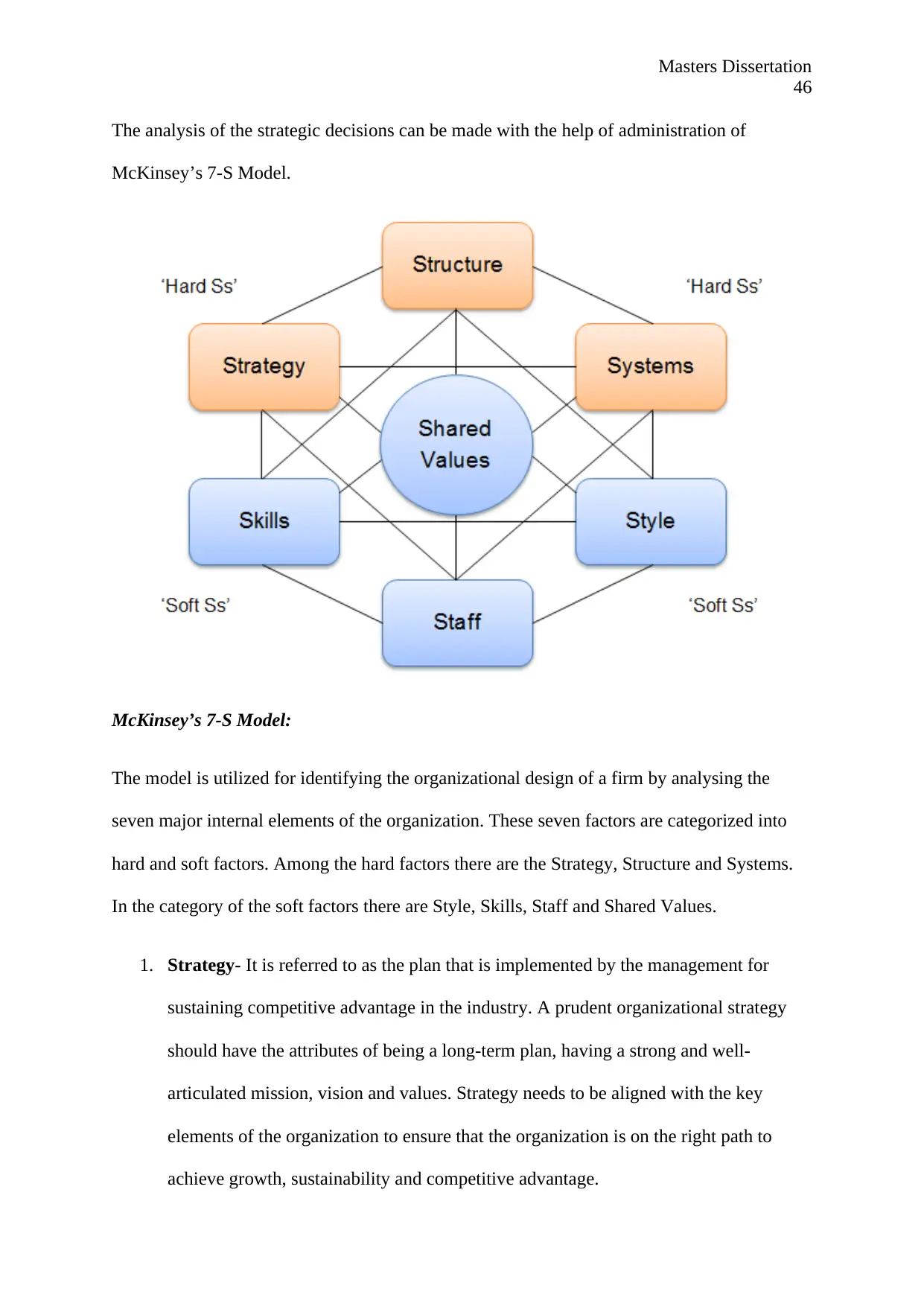
Masters Dissertation
46
The analysis of the strategic decisions can be made with the help of administration of
McKinsey’s 7-S Model.
McKinsey’s 7-S Model:
The model is utilized for identifying the organizational design of a firm by analysing the
seven major internal elements of the organization. These seven factors are categorized into
hard and soft factors. Among the hard factors there are the Strategy, Structure and Systems.
In the category of the soft factors there are Style, Skills, Staff and Shared Values.
1. Strategy- It is referred to as the plan that is implemented by the management for
sustaining competitive advantage in the industry. A prudent organizational strategy
should have the attributes of being a long-term plan, having a strong and well-
articulated mission, vision and values. Strategy needs to be aligned with the key
elements of the organization to ensure that the organization is on the right path to
achieve growth, sustainability and competitive advantage.
46
The analysis of the strategic decisions can be made with the help of administration of
McKinsey’s 7-S Model.
McKinsey’s 7-S Model:
The model is utilized for identifying the organizational design of a firm by analysing the
seven major internal elements of the organization. These seven factors are categorized into
hard and soft factors. Among the hard factors there are the Strategy, Structure and Systems.
In the category of the soft factors there are Style, Skills, Staff and Shared Values.
1. Strategy- It is referred to as the plan that is implemented by the management for
sustaining competitive advantage in the industry. A prudent organizational strategy
should have the attributes of being a long-term plan, having a strong and well-
articulated mission, vision and values. Strategy needs to be aligned with the key
elements of the organization to ensure that the organization is on the right path to
achieve growth, sustainability and competitive advantage.
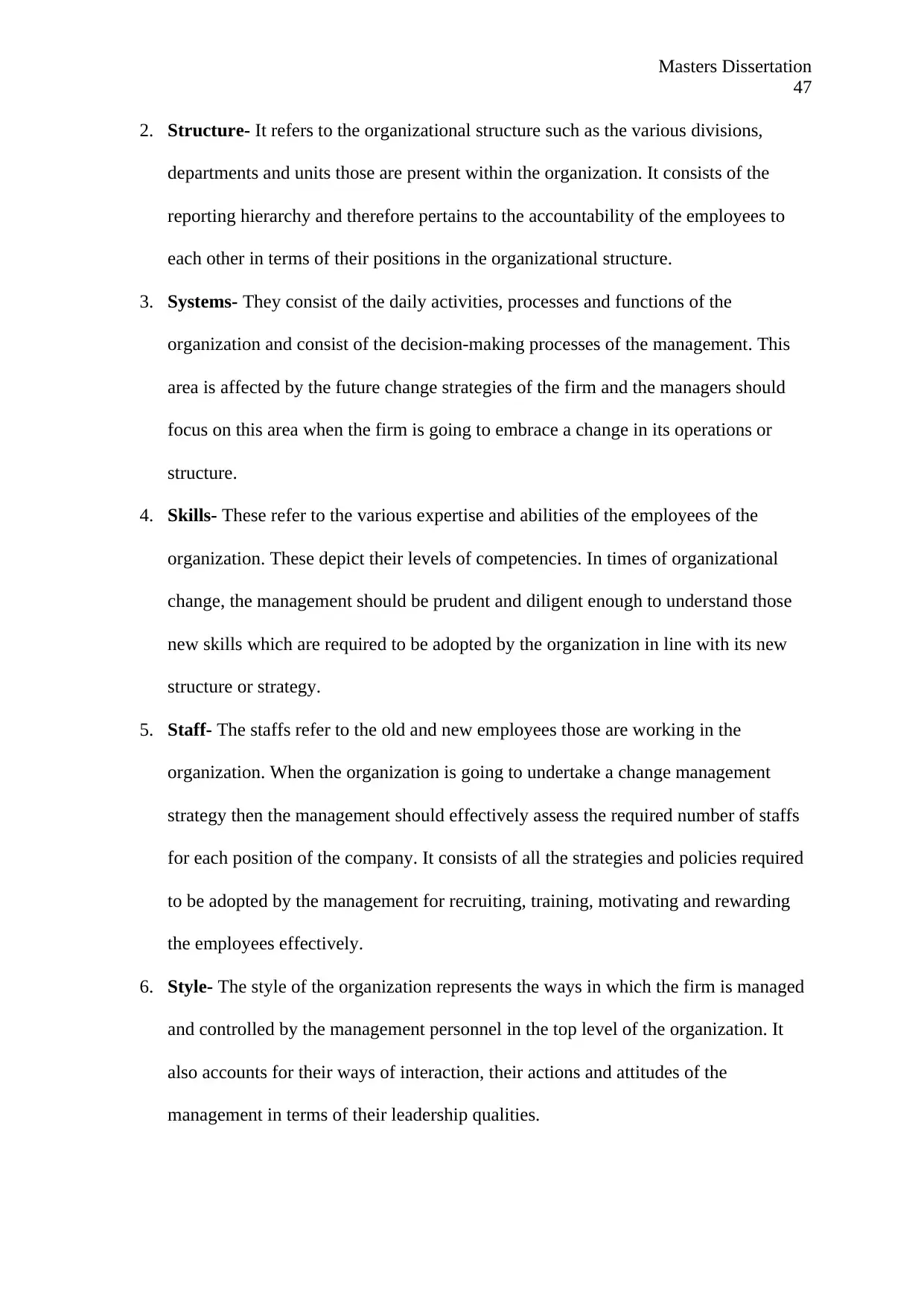
Masters Dissertation
47
2. Structure- It refers to the organizational structure such as the various divisions,
departments and units those are present within the organization. It consists of the
reporting hierarchy and therefore pertains to the accountability of the employees to
each other in terms of their positions in the organizational structure.
3. Systems- They consist of the daily activities, processes and functions of the
organization and consist of the decision-making processes of the management. This
area is affected by the future change strategies of the firm and the managers should
focus on this area when the firm is going to embrace a change in its operations or
structure.
4. Skills- These refer to the various expertise and abilities of the employees of the
organization. These depict their levels of competencies. In times of organizational
change, the management should be prudent and diligent enough to understand those
new skills which are required to be adopted by the organization in line with its new
structure or strategy.
5. Staff- The staffs refer to the old and new employees those are working in the
organization. When the organization is going to undertake a change management
strategy then the management should effectively assess the required number of staffs
for each position of the company. It consists of all the strategies and policies required
to be adopted by the management for recruiting, training, motivating and rewarding
the employees effectively.
6. Style- The style of the organization represents the ways in which the firm is managed
and controlled by the management personnel in the top level of the organization. It
also accounts for their ways of interaction, their actions and attitudes of the
management in terms of their leadership qualities.
47
2. Structure- It refers to the organizational structure such as the various divisions,
departments and units those are present within the organization. It consists of the
reporting hierarchy and therefore pertains to the accountability of the employees to
each other in terms of their positions in the organizational structure.
3. Systems- They consist of the daily activities, processes and functions of the
organization and consist of the decision-making processes of the management. This
area is affected by the future change strategies of the firm and the managers should
focus on this area when the firm is going to embrace a change in its operations or
structure.
4. Skills- These refer to the various expertise and abilities of the employees of the
organization. These depict their levels of competencies. In times of organizational
change, the management should be prudent and diligent enough to understand those
new skills which are required to be adopted by the organization in line with its new
structure or strategy.
5. Staff- The staffs refer to the old and new employees those are working in the
organization. When the organization is going to undertake a change management
strategy then the management should effectively assess the required number of staffs
for each position of the company. It consists of all the strategies and policies required
to be adopted by the management for recruiting, training, motivating and rewarding
the employees effectively.
6. Style- The style of the organization represents the ways in which the firm is managed
and controlled by the management personnel in the top level of the organization. It
also accounts for their ways of interaction, their actions and attitudes of the
management in terms of their leadership qualities.

Masters Dissertation
48
7. Shared Values- The shared values form the integral part of McKinsey’s 7-S Model.
These are the basic rules, regulations, principles and standards those are the one and
the same for each of the employees of the organization. These form the basic
foundation of every organization. The management should be able to ensure effective
control and management systems so that all the employees abide by the organizational
norms and policies. The shared values should be adhered to at every stage of the
organizational functioning (Jurevicius, 2013).
In analysing the test case of the medical devices group where the management decisions were
questionable, especially the leadership and management of the newly appointed CEO, it can
be established that as per the application of McKinsey’s 7-S Model, that there were issues
related to the strategy, structure, style, system, skills, staff and shared values those
contributed together in the lack of proper decision-making and demonstration of poor
leadership, management and control. Regarding the strategy, it can be said that there was lack
of effective decision-making and clearly articulated rules and regulations for the departmental
managers and other employees to follow that made it possible for unscrupulous intentions to
creep in. In respect of the organizational structure, it can be said that being from a
government sector, the CEO emphasized on an authoritative and centralized organizational
structure but it proved to be ineffective in the private sector organization.
Regarding the style of management and leadership provided by the CEO of the organization
it can be said that there was clearly lack of proper foresight, expertise and skills to lead in a
competitive private sector environment. This continued lack of focus and leadership made it
possible for the incident of purchasing inferior quality of raw materials to happen as many of
the managers in different departments were getting indulgence in unfair and unethical
practices. The results were calamitous for the firm as it had to recall one of its core products
48
7. Shared Values- The shared values form the integral part of McKinsey’s 7-S Model.
These are the basic rules, regulations, principles and standards those are the one and
the same for each of the employees of the organization. These form the basic
foundation of every organization. The management should be able to ensure effective
control and management systems so that all the employees abide by the organizational
norms and policies. The shared values should be adhered to at every stage of the
organizational functioning (Jurevicius, 2013).
In analysing the test case of the medical devices group where the management decisions were
questionable, especially the leadership and management of the newly appointed CEO, it can
be established that as per the application of McKinsey’s 7-S Model, that there were issues
related to the strategy, structure, style, system, skills, staff and shared values those
contributed together in the lack of proper decision-making and demonstration of poor
leadership, management and control. Regarding the strategy, it can be said that there was lack
of effective decision-making and clearly articulated rules and regulations for the departmental
managers and other employees to follow that made it possible for unscrupulous intentions to
creep in. In respect of the organizational structure, it can be said that being from a
government sector, the CEO emphasized on an authoritative and centralized organizational
structure but it proved to be ineffective in the private sector organization.
Regarding the style of management and leadership provided by the CEO of the organization
it can be said that there was clearly lack of proper foresight, expertise and skills to lead in a
competitive private sector environment. This continued lack of focus and leadership made it
possible for the incident of purchasing inferior quality of raw materials to happen as many of
the managers in different departments were getting indulgence in unfair and unethical
practices. The results were calamitous for the firm as it had to recall one of its core products
Secure Best Marks with AI Grader
Need help grading? Try our AI Grader for instant feedback on your assignments.
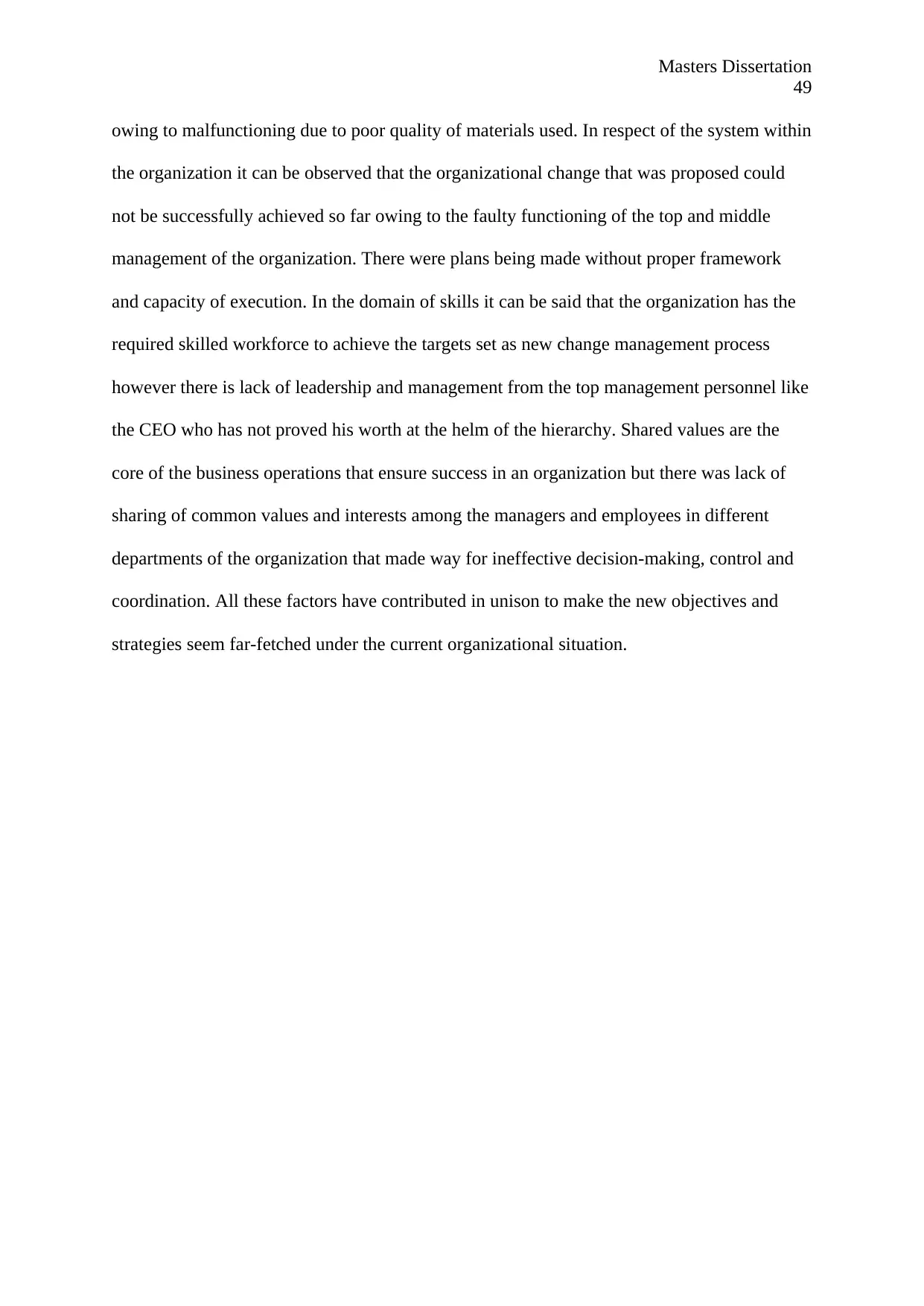
Masters Dissertation
49
owing to malfunctioning due to poor quality of materials used. In respect of the system within
the organization it can be observed that the organizational change that was proposed could
not be successfully achieved so far owing to the faulty functioning of the top and middle
management of the organization. There were plans being made without proper framework
and capacity of execution. In the domain of skills it can be said that the organization has the
required skilled workforce to achieve the targets set as new change management process
however there is lack of leadership and management from the top management personnel like
the CEO who has not proved his worth at the helm of the hierarchy. Shared values are the
core of the business operations that ensure success in an organization but there was lack of
sharing of common values and interests among the managers and employees in different
departments of the organization that made way for ineffective decision-making, control and
coordination. All these factors have contributed in unison to make the new objectives and
strategies seem far-fetched under the current organizational situation.
49
owing to malfunctioning due to poor quality of materials used. In respect of the system within
the organization it can be observed that the organizational change that was proposed could
not be successfully achieved so far owing to the faulty functioning of the top and middle
management of the organization. There were plans being made without proper framework
and capacity of execution. In the domain of skills it can be said that the organization has the
required skilled workforce to achieve the targets set as new change management process
however there is lack of leadership and management from the top management personnel like
the CEO who has not proved his worth at the helm of the hierarchy. Shared values are the
core of the business operations that ensure success in an organization but there was lack of
sharing of common values and interests among the managers and employees in different
departments of the organization that made way for ineffective decision-making, control and
coordination. All these factors have contributed in unison to make the new objectives and
strategies seem far-fetched under the current organizational situation.
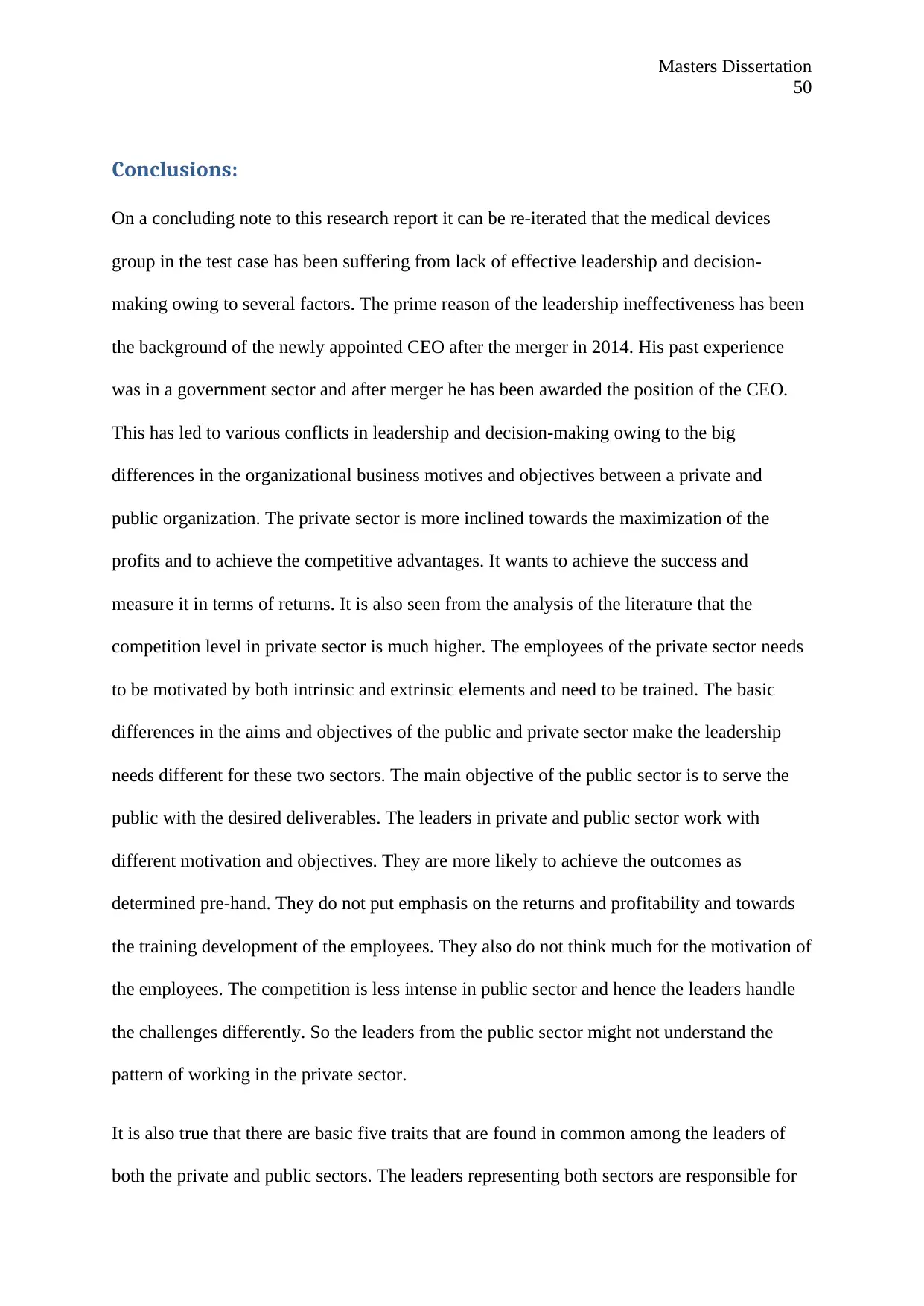
Masters Dissertation
50
Conclusions:
On a concluding note to this research report it can be re-iterated that the medical devices
group in the test case has been suffering from lack of effective leadership and decision-
making owing to several factors. The prime reason of the leadership ineffectiveness has been
the background of the newly appointed CEO after the merger in 2014. His past experience
was in a government sector and after merger he has been awarded the position of the CEO.
This has led to various conflicts in leadership and decision-making owing to the big
differences in the organizational business motives and objectives between a private and
public organization. The private sector is more inclined towards the maximization of the
profits and to achieve the competitive advantages. It wants to achieve the success and
measure it in terms of returns. It is also seen from the analysis of the literature that the
competition level in private sector is much higher. The employees of the private sector needs
to be motivated by both intrinsic and extrinsic elements and need to be trained. The basic
differences in the aims and objectives of the public and private sector make the leadership
needs different for these two sectors. The main objective of the public sector is to serve the
public with the desired deliverables. The leaders in private and public sector work with
different motivation and objectives. They are more likely to achieve the outcomes as
determined pre-hand. They do not put emphasis on the returns and profitability and towards
the training development of the employees. They also do not think much for the motivation of
the employees. The competition is less intense in public sector and hence the leaders handle
the challenges differently. So the leaders from the public sector might not understand the
pattern of working in the private sector.
It is also true that there are basic five traits that are found in common among the leaders of
both the private and public sectors. The leaders representing both sectors are responsible for
50
Conclusions:
On a concluding note to this research report it can be re-iterated that the medical devices
group in the test case has been suffering from lack of effective leadership and decision-
making owing to several factors. The prime reason of the leadership ineffectiveness has been
the background of the newly appointed CEO after the merger in 2014. His past experience
was in a government sector and after merger he has been awarded the position of the CEO.
This has led to various conflicts in leadership and decision-making owing to the big
differences in the organizational business motives and objectives between a private and
public organization. The private sector is more inclined towards the maximization of the
profits and to achieve the competitive advantages. It wants to achieve the success and
measure it in terms of returns. It is also seen from the analysis of the literature that the
competition level in private sector is much higher. The employees of the private sector needs
to be motivated by both intrinsic and extrinsic elements and need to be trained. The basic
differences in the aims and objectives of the public and private sector make the leadership
needs different for these two sectors. The main objective of the public sector is to serve the
public with the desired deliverables. The leaders in private and public sector work with
different motivation and objectives. They are more likely to achieve the outcomes as
determined pre-hand. They do not put emphasis on the returns and profitability and towards
the training development of the employees. They also do not think much for the motivation of
the employees. The competition is less intense in public sector and hence the leaders handle
the challenges differently. So the leaders from the public sector might not understand the
pattern of working in the private sector.
It is also true that there are basic five traits that are found in common among the leaders of
both the private and public sectors. The leaders representing both sectors are responsible for
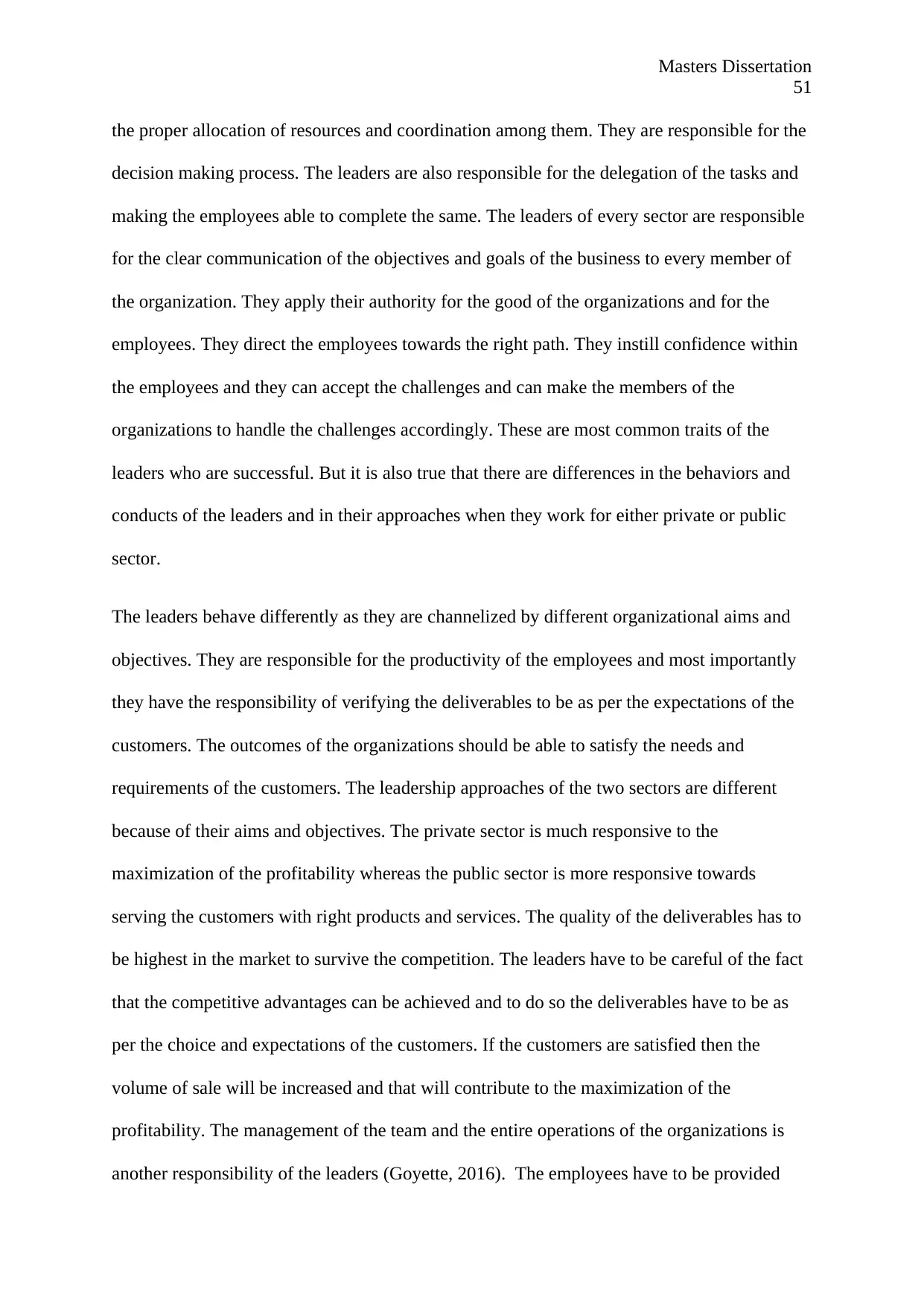
Masters Dissertation
51
the proper allocation of resources and coordination among them. They are responsible for the
decision making process. The leaders are also responsible for the delegation of the tasks and
making the employees able to complete the same. The leaders of every sector are responsible
for the clear communication of the objectives and goals of the business to every member of
the organization. They apply their authority for the good of the organizations and for the
employees. They direct the employees towards the right path. They instill confidence within
the employees and they can accept the challenges and can make the members of the
organizations to handle the challenges accordingly. These are most common traits of the
leaders who are successful. But it is also true that there are differences in the behaviors and
conducts of the leaders and in their approaches when they work for either private or public
sector.
The leaders behave differently as they are channelized by different organizational aims and
objectives. They are responsible for the productivity of the employees and most importantly
they have the responsibility of verifying the deliverables to be as per the expectations of the
customers. The outcomes of the organizations should be able to satisfy the needs and
requirements of the customers. The leadership approaches of the two sectors are different
because of their aims and objectives. The private sector is much responsive to the
maximization of the profitability whereas the public sector is more responsive towards
serving the customers with right products and services. The quality of the deliverables has to
be highest in the market to survive the competition. The leaders have to be careful of the fact
that the competitive advantages can be achieved and to do so the deliverables have to be as
per the choice and expectations of the customers. If the customers are satisfied then the
volume of sale will be increased and that will contribute to the maximization of the
profitability. The management of the team and the entire operations of the organizations is
another responsibility of the leaders (Goyette, 2016). The employees have to be provided
51
the proper allocation of resources and coordination among them. They are responsible for the
decision making process. The leaders are also responsible for the delegation of the tasks and
making the employees able to complete the same. The leaders of every sector are responsible
for the clear communication of the objectives and goals of the business to every member of
the organization. They apply their authority for the good of the organizations and for the
employees. They direct the employees towards the right path. They instill confidence within
the employees and they can accept the challenges and can make the members of the
organizations to handle the challenges accordingly. These are most common traits of the
leaders who are successful. But it is also true that there are differences in the behaviors and
conducts of the leaders and in their approaches when they work for either private or public
sector.
The leaders behave differently as they are channelized by different organizational aims and
objectives. They are responsible for the productivity of the employees and most importantly
they have the responsibility of verifying the deliverables to be as per the expectations of the
customers. The outcomes of the organizations should be able to satisfy the needs and
requirements of the customers. The leadership approaches of the two sectors are different
because of their aims and objectives. The private sector is much responsive to the
maximization of the profitability whereas the public sector is more responsive towards
serving the customers with right products and services. The quality of the deliverables has to
be highest in the market to survive the competition. The leaders have to be careful of the fact
that the competitive advantages can be achieved and to do so the deliverables have to be as
per the choice and expectations of the customers. If the customers are satisfied then the
volume of sale will be increased and that will contribute to the maximization of the
profitability. The management of the team and the entire operations of the organizations is
another responsibility of the leaders (Goyette, 2016). The employees have to be provided
Paraphrase This Document
Need a fresh take? Get an instant paraphrase of this document with our AI Paraphraser
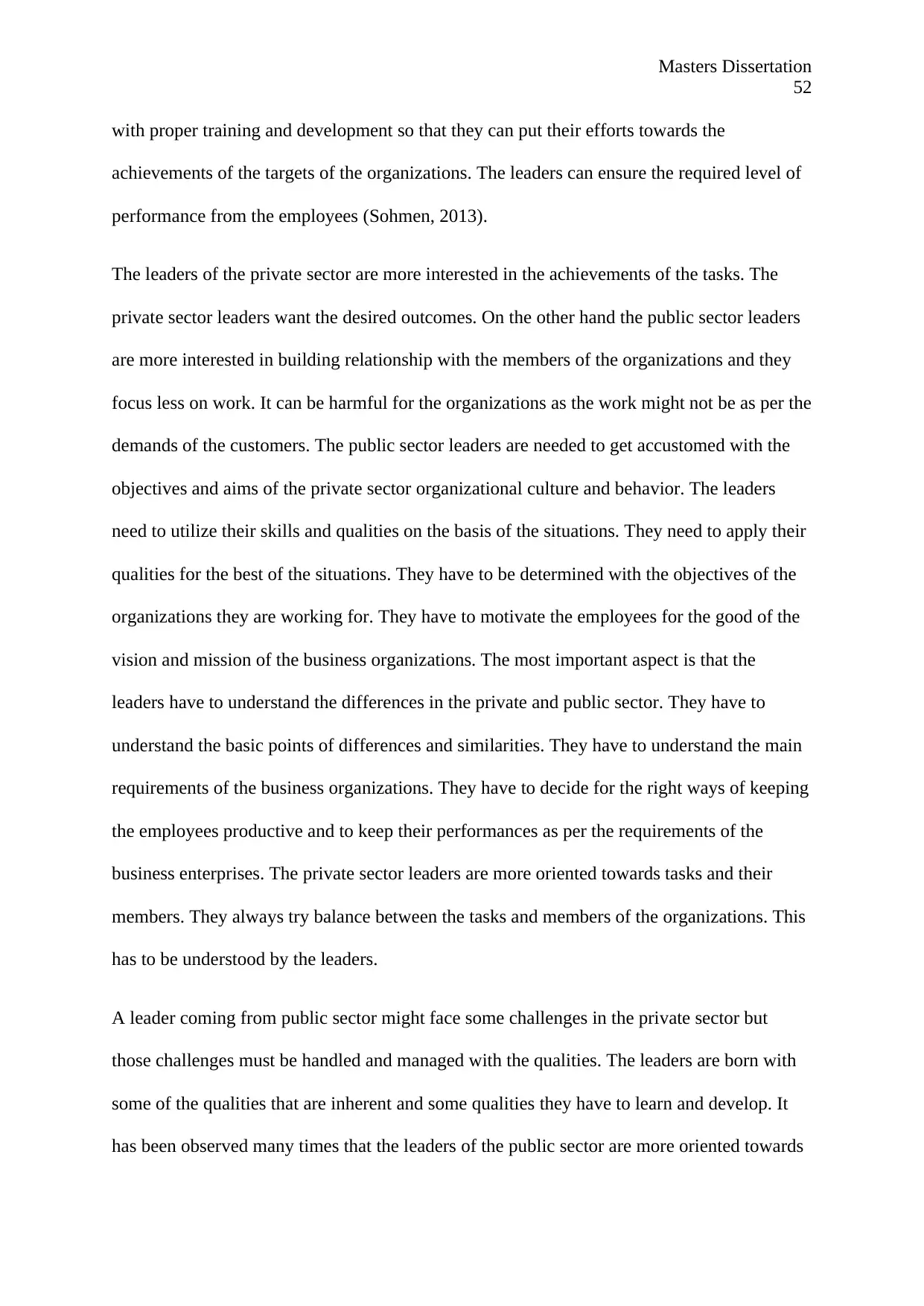
Masters Dissertation
52
with proper training and development so that they can put their efforts towards the
achievements of the targets of the organizations. The leaders can ensure the required level of
performance from the employees (Sohmen, 2013).
The leaders of the private sector are more interested in the achievements of the tasks. The
private sector leaders want the desired outcomes. On the other hand the public sector leaders
are more interested in building relationship with the members of the organizations and they
focus less on work. It can be harmful for the organizations as the work might not be as per the
demands of the customers. The public sector leaders are needed to get accustomed with the
objectives and aims of the private sector organizational culture and behavior. The leaders
need to utilize their skills and qualities on the basis of the situations. They need to apply their
qualities for the best of the situations. They have to be determined with the objectives of the
organizations they are working for. They have to motivate the employees for the good of the
vision and mission of the business organizations. The most important aspect is that the
leaders have to understand the differences in the private and public sector. They have to
understand the basic points of differences and similarities. They have to understand the main
requirements of the business organizations. They have to decide for the right ways of keeping
the employees productive and to keep their performances as per the requirements of the
business enterprises. The private sector leaders are more oriented towards tasks and their
members. They always try balance between the tasks and members of the organizations. This
has to be understood by the leaders.
A leader coming from public sector might face some challenges in the private sector but
those challenges must be handled and managed with the qualities. The leaders are born with
some of the qualities that are inherent and some qualities they have to learn and develop. It
has been observed many times that the leaders of the public sector are more oriented towards
52
with proper training and development so that they can put their efforts towards the
achievements of the targets of the organizations. The leaders can ensure the required level of
performance from the employees (Sohmen, 2013).
The leaders of the private sector are more interested in the achievements of the tasks. The
private sector leaders want the desired outcomes. On the other hand the public sector leaders
are more interested in building relationship with the members of the organizations and they
focus less on work. It can be harmful for the organizations as the work might not be as per the
demands of the customers. The public sector leaders are needed to get accustomed with the
objectives and aims of the private sector organizational culture and behavior. The leaders
need to utilize their skills and qualities on the basis of the situations. They need to apply their
qualities for the best of the situations. They have to be determined with the objectives of the
organizations they are working for. They have to motivate the employees for the good of the
vision and mission of the business organizations. The most important aspect is that the
leaders have to understand the differences in the private and public sector. They have to
understand the basic points of differences and similarities. They have to understand the main
requirements of the business organizations. They have to decide for the right ways of keeping
the employees productive and to keep their performances as per the requirements of the
business enterprises. The private sector leaders are more oriented towards tasks and their
members. They always try balance between the tasks and members of the organizations. This
has to be understood by the leaders.
A leader coming from public sector might face some challenges in the private sector but
those challenges must be handled and managed with the qualities. The leaders are born with
some of the qualities that are inherent and some qualities they have to learn and develop. It
has been observed many times that the leaders of the public sector are more oriented towards

Masters Dissertation
53
their own tasks than that of the other members of the organizations and they are much higher
on establishing relation with the people. It is important for a leader to balance between the
achievements and tasks and the achievements. They must think about the achievements of the
business organizations more than their own achievements. This can make them successful in
true terms. The analytical quality of the leaders is an important aspect to become successful
and to help the organizations successful.
Looking at the prevailing situation in the organization and after a study of the several sources
of literature on various aspects of leadership and decision-making the following
recommendations could be offered to improve the current situation of the organization:
In order to achieve the desired growth in revenue and market share, the CEO needs to
develop his foresight and other leadership skills. He needs to have the desire to learn
and change his thinking process and style of strategy formulation. He should take the
help of other management personnel and take suggestions and advices from them in
order to cope up with the changed demands of the private sector.
For achieving overall cost reduction and increasing profitability, the CEO should first
of all take care of the unscrupulous activities and implement strong supervision and
control so that no unnecessary expenditures are incurred or there is no fraudulent
misappropriation of funds by any employee. The organization needs to be
decentralized with each department having its own power and authority like the
marketing and sales department. This will enable more employee empowerment and
new innovative strategies could be formulated for achieving success in dynamic
business environment.
Decrease in the cost of production will help to enhance the profitability and the
opening up of the new production facility should be postponed as of now as it will
53
their own tasks than that of the other members of the organizations and they are much higher
on establishing relation with the people. It is important for a leader to balance between the
achievements and tasks and the achievements. They must think about the achievements of the
business organizations more than their own achievements. This can make them successful in
true terms. The analytical quality of the leaders is an important aspect to become successful
and to help the organizations successful.
Looking at the prevailing situation in the organization and after a study of the several sources
of literature on various aspects of leadership and decision-making the following
recommendations could be offered to improve the current situation of the organization:
In order to achieve the desired growth in revenue and market share, the CEO needs to
develop his foresight and other leadership skills. He needs to have the desire to learn
and change his thinking process and style of strategy formulation. He should take the
help of other management personnel and take suggestions and advices from them in
order to cope up with the changed demands of the private sector.
For achieving overall cost reduction and increasing profitability, the CEO should first
of all take care of the unscrupulous activities and implement strong supervision and
control so that no unnecessary expenditures are incurred or there is no fraudulent
misappropriation of funds by any employee. The organization needs to be
decentralized with each department having its own power and authority like the
marketing and sales department. This will enable more employee empowerment and
new innovative strategies could be formulated for achieving success in dynamic
business environment.
Decrease in the cost of production will help to enhance the profitability and the
opening up of the new production facility should be postponed as of now as it will

Masters Dissertation
54
contribute to a large sum of investment that in the current organizational context will
further add to the misfortune. First of all, the incident of the product recall should be
dealt with by investing more behind research and development such that the best
quality of materials are procured ethically and used in manufacturing of the products
of the business group. Likewise, the planning of opening up new sales branches in
Indo-China markets should be deferred unless the company is able to recuperate from
the disaster of product recall and its profitability reaches a satisfactory level along
with prior reputation.
54
contribute to a large sum of investment that in the current organizational context will
further add to the misfortune. First of all, the incident of the product recall should be
dealt with by investing more behind research and development such that the best
quality of materials are procured ethically and used in manufacturing of the products
of the business group. Likewise, the planning of opening up new sales branches in
Indo-China markets should be deferred unless the company is able to recuperate from
the disaster of product recall and its profitability reaches a satisfactory level along
with prior reputation.
Secure Best Marks with AI Grader
Need help grading? Try our AI Grader for instant feedback on your assignments.
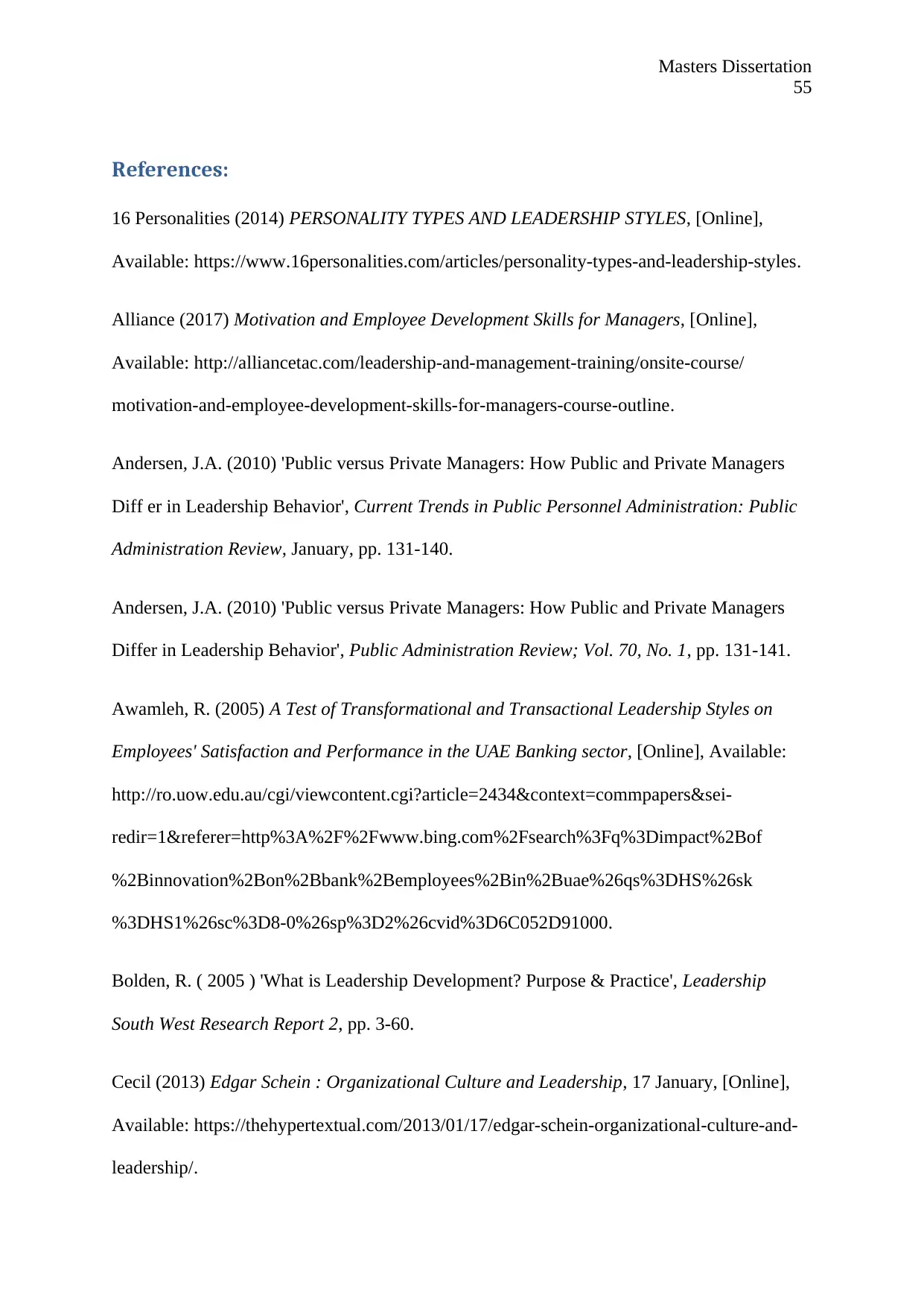
Masters Dissertation
55
References:
16 Personalities (2014) PERSONALITY TYPES AND LEADERSHIP STYLES, [Online],
Available: https://www.16personalities.com/articles/personality-types-and-leadership-styles.
Alliance (2017) Motivation and Employee Development Skills for Managers, [Online],
Available: http://alliancetac.com/leadership-and-management-training/onsite-course/
motivation-and-employee-development-skills-for-managers-course-outline.
Andersen, J.A. (2010) 'Public versus Private Managers: How Public and Private Managers
Diff er in Leadership Behavior', Current Trends in Public Personnel Administration: Public
Administration Review, January, pp. 131-140.
Andersen, J.A. (2010) 'Public versus Private Managers: How Public and Private Managers
Differ in Leadership Behavior', Public Administration Review; Vol. 70, No. 1, pp. 131-141.
Awamleh, R. (2005) A Test of Transformational and Transactional Leadership Styles on
Employees' Satisfaction and Performance in the UAE Banking sector, [Online], Available:
http://ro.uow.edu.au/cgi/viewcontent.cgi?article=2434&context=commpapers&sei-
redir=1&referer=http%3A%2F%2Fwww.bing.com%2Fsearch%3Fq%3Dimpact%2Bof
%2Binnovation%2Bon%2Bbank%2Bemployees%2Bin%2Buae%26qs%3DHS%26sk
%3DHS1%26sc%3D8-0%26sp%3D2%26cvid%3D6C052D91000.
Bolden, R. ( 2005 ) 'What is Leadership Development? Purpose & Practice', Leadership
South West Research Report 2, pp. 3-60.
Cecil (2013) Edgar Schein : Organizational Culture and Leadership, 17 January, [Online],
Available: https://thehypertextual.com/2013/01/17/edgar-schein-organizational-culture-and-
leadership/.
55
References:
16 Personalities (2014) PERSONALITY TYPES AND LEADERSHIP STYLES, [Online],
Available: https://www.16personalities.com/articles/personality-types-and-leadership-styles.
Alliance (2017) Motivation and Employee Development Skills for Managers, [Online],
Available: http://alliancetac.com/leadership-and-management-training/onsite-course/
motivation-and-employee-development-skills-for-managers-course-outline.
Andersen, J.A. (2010) 'Public versus Private Managers: How Public and Private Managers
Diff er in Leadership Behavior', Current Trends in Public Personnel Administration: Public
Administration Review, January, pp. 131-140.
Andersen, J.A. (2010) 'Public versus Private Managers: How Public and Private Managers
Differ in Leadership Behavior', Public Administration Review; Vol. 70, No. 1, pp. 131-141.
Awamleh, R. (2005) A Test of Transformational and Transactional Leadership Styles on
Employees' Satisfaction and Performance in the UAE Banking sector, [Online], Available:
http://ro.uow.edu.au/cgi/viewcontent.cgi?article=2434&context=commpapers&sei-
redir=1&referer=http%3A%2F%2Fwww.bing.com%2Fsearch%3Fq%3Dimpact%2Bof
%2Binnovation%2Bon%2Bbank%2Bemployees%2Bin%2Buae%26qs%3DHS%26sk
%3DHS1%26sc%3D8-0%26sp%3D2%26cvid%3D6C052D91000.
Bolden, R. ( 2005 ) 'What is Leadership Development? Purpose & Practice', Leadership
South West Research Report 2, pp. 3-60.
Cecil (2013) Edgar Schein : Organizational Culture and Leadership, 17 January, [Online],
Available: https://thehypertextual.com/2013/01/17/edgar-schein-organizational-culture-and-
leadership/.
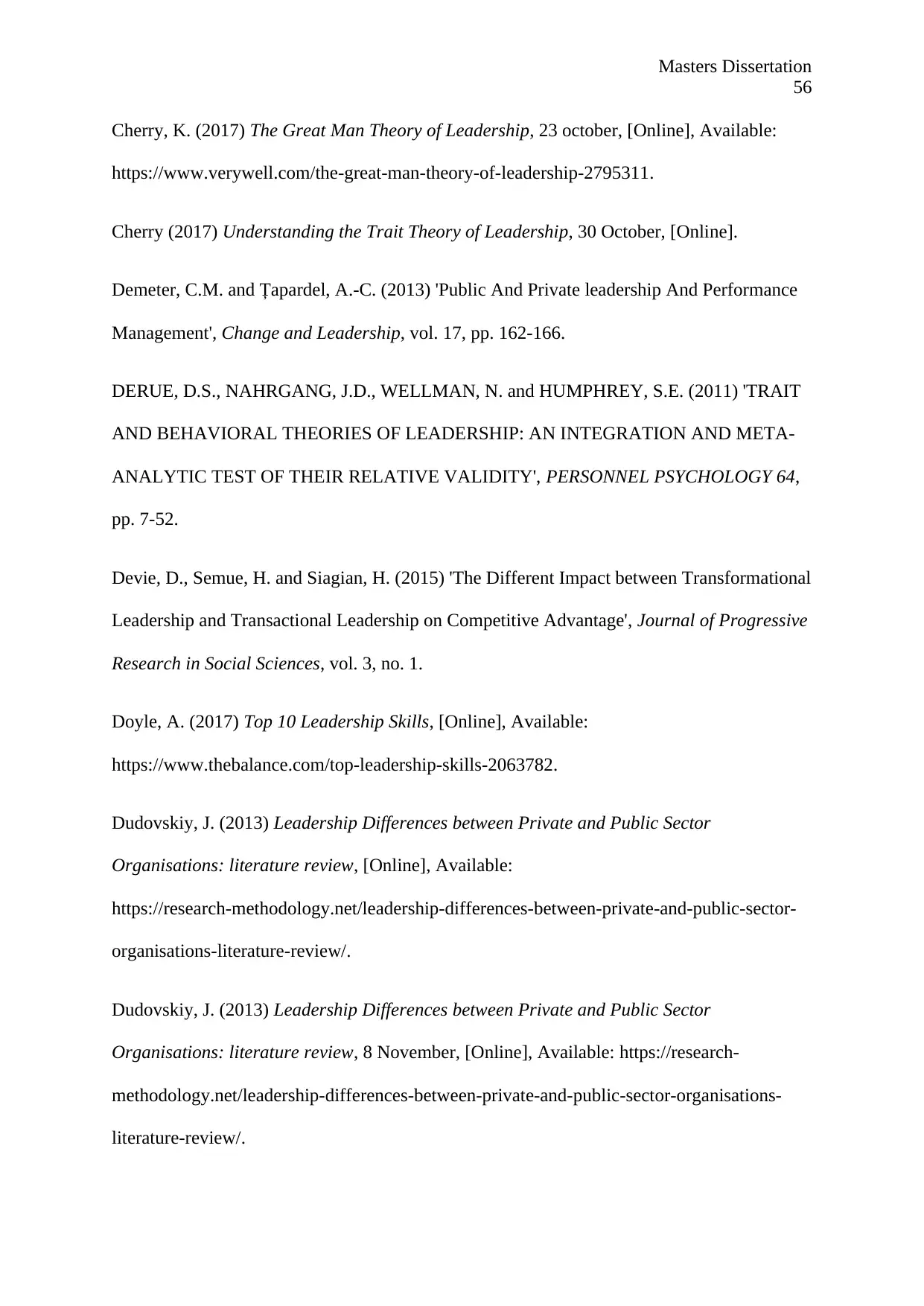
Masters Dissertation
56
Cherry, K. (2017) The Great Man Theory of Leadership, 23 october, [Online], Available:
https://www.verywell.com/the-great-man-theory-of-leadership-2795311.
Cherry (2017) Understanding the Trait Theory of Leadership, 30 October, [Online].
Demeter, C.M. and Țapardel, A.-C. (2013) 'Public And Private leadership And Performance
Management', Change and Leadership, vol. 17, pp. 162-166.
DERUE, D.S., NAHRGANG, J.D., WELLMAN, N. and HUMPHREY, S.E. (2011) 'TRAIT
AND BEHAVIORAL THEORIES OF LEADERSHIP: AN INTEGRATION AND META-
ANALYTIC TEST OF THEIR RELATIVE VALIDITY', PERSONNEL PSYCHOLOGY 64,
pp. 7-52.
Devie, D., Semue, H. and Siagian, H. (2015) 'The Different Impact between Transformational
Leadership and Transactional Leadership on Competitive Advantage', Journal of Progressive
Research in Social Sciences, vol. 3, no. 1.
Doyle, A. (2017) Top 10 Leadership Skills, [Online], Available:
https://www.thebalance.com/top-leadership-skills-2063782.
Dudovskiy, J. (2013) Leadership Differences between Private and Public Sector
Organisations: literature review, [Online], Available:
https://research-methodology.net/leadership-differences-between-private-and-public-sector-
organisations-literature-review/.
Dudovskiy, J. (2013) Leadership Differences between Private and Public Sector
Organisations: literature review, 8 November, [Online], Available: https://research-
methodology.net/leadership-differences-between-private-and-public-sector-organisations-
literature-review/.
56
Cherry, K. (2017) The Great Man Theory of Leadership, 23 october, [Online], Available:
https://www.verywell.com/the-great-man-theory-of-leadership-2795311.
Cherry (2017) Understanding the Trait Theory of Leadership, 30 October, [Online].
Demeter, C.M. and Țapardel, A.-C. (2013) 'Public And Private leadership And Performance
Management', Change and Leadership, vol. 17, pp. 162-166.
DERUE, D.S., NAHRGANG, J.D., WELLMAN, N. and HUMPHREY, S.E. (2011) 'TRAIT
AND BEHAVIORAL THEORIES OF LEADERSHIP: AN INTEGRATION AND META-
ANALYTIC TEST OF THEIR RELATIVE VALIDITY', PERSONNEL PSYCHOLOGY 64,
pp. 7-52.
Devie, D., Semue, H. and Siagian, H. (2015) 'The Different Impact between Transformational
Leadership and Transactional Leadership on Competitive Advantage', Journal of Progressive
Research in Social Sciences, vol. 3, no. 1.
Doyle, A. (2017) Top 10 Leadership Skills, [Online], Available:
https://www.thebalance.com/top-leadership-skills-2063782.
Dudovskiy, J. (2013) Leadership Differences between Private and Public Sector
Organisations: literature review, [Online], Available:
https://research-methodology.net/leadership-differences-between-private-and-public-sector-
organisations-literature-review/.
Dudovskiy, J. (2013) Leadership Differences between Private and Public Sector
Organisations: literature review, 8 November, [Online], Available: https://research-
methodology.net/leadership-differences-between-private-and-public-sector-organisations-
literature-review/.
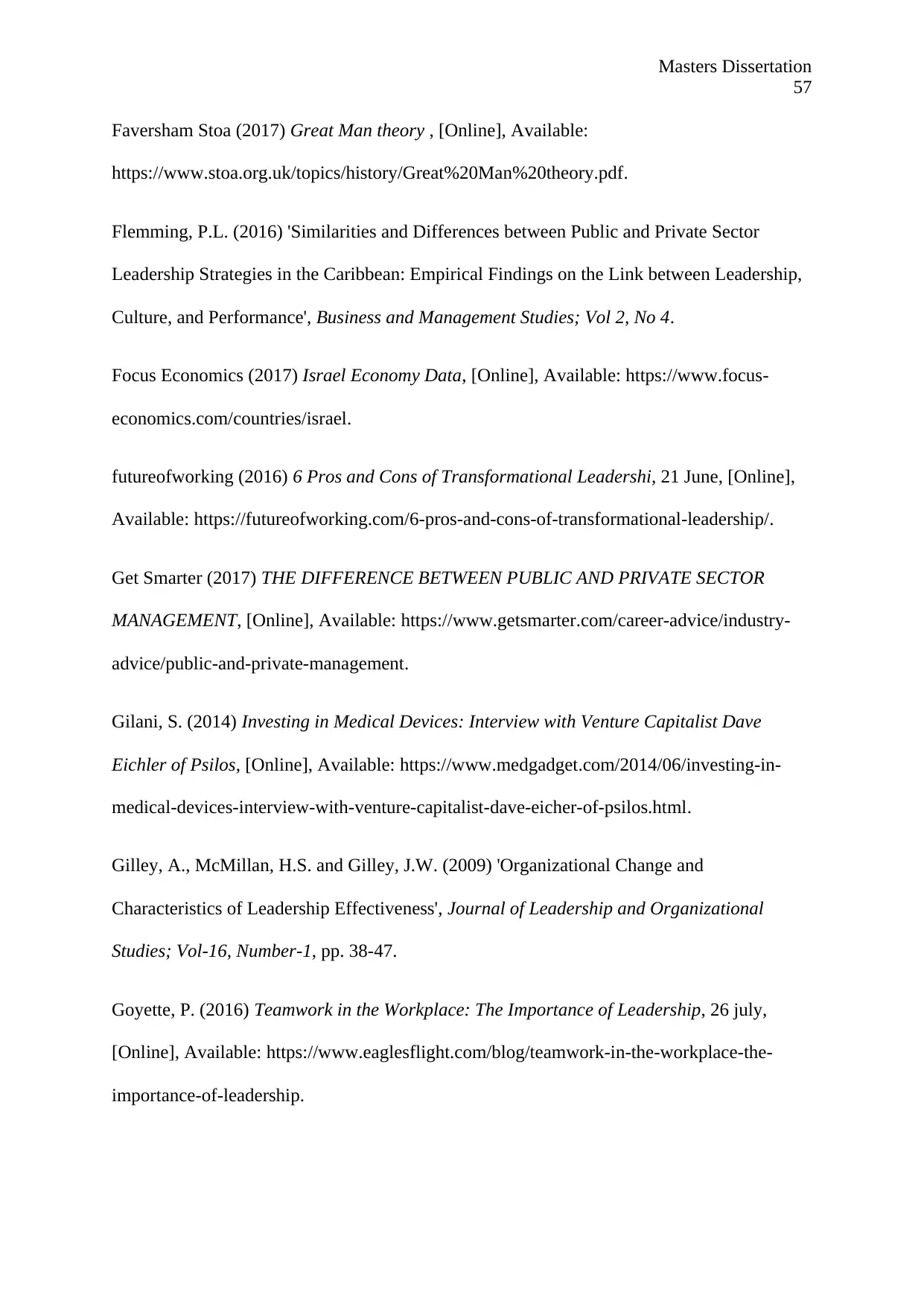
Masters Dissertation
57
Faversham Stoa (2017) Great Man theory , [Online], Available:
https://www.stoa.org.uk/topics/history/Great%20Man%20theory.pdf.
Flemming, P.L. (2016) 'Similarities and Differences between Public and Private Sector
Leadership Strategies in the Caribbean: Empirical Findings on the Link between Leadership,
Culture, and Performance', Business and Management Studies; Vol 2, No 4.
Focus Economics (2017) Israel Economy Data, [Online], Available: https://www.focus-
economics.com/countries/israel.
futureofworking (2016) 6 Pros and Cons of Transformational Leadershi, 21 June, [Online],
Available: https://futureofworking.com/6-pros-and-cons-of-transformational-leadership/.
Get Smarter (2017) THE DIFFERENCE BETWEEN PUBLIC AND PRIVATE SECTOR
MANAGEMENT, [Online], Available: https://www.getsmarter.com/career-advice/industry-
advice/public-and-private-management.
Gilani, S. (2014) Investing in Medical Devices: Interview with Venture Capitalist Dave
Eichler of Psilos, [Online], Available: https://www.medgadget.com/2014/06/investing-in-
medical-devices-interview-with-venture-capitalist-dave-eicher-of-psilos.html.
Gilley, A., McMillan, H.S. and Gilley, J.W. (2009) 'Organizational Change and
Characteristics of Leadership Effectiveness', Journal of Leadership and Organizational
Studies; Vol-16, Number-1, pp. 38-47.
Goyette, P. (2016) Teamwork in the Workplace: The Importance of Leadership, 26 july,
[Online], Available: https://www.eaglesflight.com/blog/teamwork-in-the-workplace-the-
importance-of-leadership.
57
Faversham Stoa (2017) Great Man theory , [Online], Available:
https://www.stoa.org.uk/topics/history/Great%20Man%20theory.pdf.
Flemming, P.L. (2016) 'Similarities and Differences between Public and Private Sector
Leadership Strategies in the Caribbean: Empirical Findings on the Link between Leadership,
Culture, and Performance', Business and Management Studies; Vol 2, No 4.
Focus Economics (2017) Israel Economy Data, [Online], Available: https://www.focus-
economics.com/countries/israel.
futureofworking (2016) 6 Pros and Cons of Transformational Leadershi, 21 June, [Online],
Available: https://futureofworking.com/6-pros-and-cons-of-transformational-leadership/.
Get Smarter (2017) THE DIFFERENCE BETWEEN PUBLIC AND PRIVATE SECTOR
MANAGEMENT, [Online], Available: https://www.getsmarter.com/career-advice/industry-
advice/public-and-private-management.
Gilani, S. (2014) Investing in Medical Devices: Interview with Venture Capitalist Dave
Eichler of Psilos, [Online], Available: https://www.medgadget.com/2014/06/investing-in-
medical-devices-interview-with-venture-capitalist-dave-eicher-of-psilos.html.
Gilley, A., McMillan, H.S. and Gilley, J.W. (2009) 'Organizational Change and
Characteristics of Leadership Effectiveness', Journal of Leadership and Organizational
Studies; Vol-16, Number-1, pp. 38-47.
Goyette, P. (2016) Teamwork in the Workplace: The Importance of Leadership, 26 july,
[Online], Available: https://www.eaglesflight.com/blog/teamwork-in-the-workplace-the-
importance-of-leadership.
Paraphrase This Document
Need a fresh take? Get an instant paraphrase of this document with our AI Paraphraser
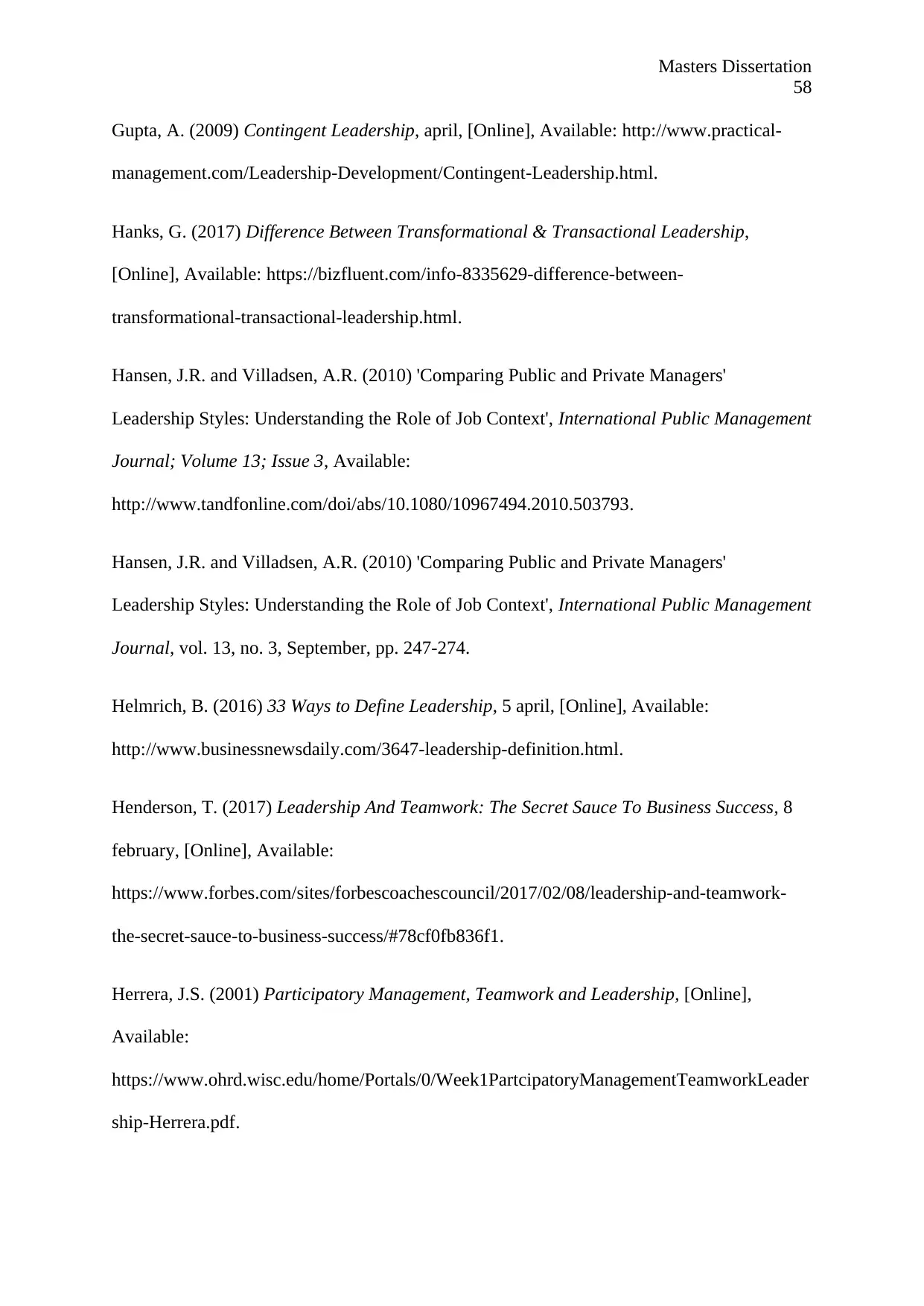
Masters Dissertation
58
Gupta, A. (2009) Contingent Leadership, april, [Online], Available: http://www.practical-
management.com/Leadership-Development/Contingent-Leadership.html.
Hanks, G. (2017) Difference Between Transformational & Transactional Leadership,
[Online], Available: https://bizfluent.com/info-8335629-difference-between-
transformational-transactional-leadership.html.
Hansen, J.R. and Villadsen, A.R. (2010) 'Comparing Public and Private Managers'
Leadership Styles: Understanding the Role of Job Context', International Public Management
Journal; Volume 13; Issue 3, Available:
http://www.tandfonline.com/doi/abs/10.1080/10967494.2010.503793.
Hansen, J.R. and Villadsen, A.R. (2010) 'Comparing Public and Private Managers'
Leadership Styles: Understanding the Role of Job Context', International Public Management
Journal, vol. 13, no. 3, September, pp. 247-274.
Helmrich, B. (2016) 33 Ways to Define Leadership, 5 april, [Online], Available:
http://www.businessnewsdaily.com/3647-leadership-definition.html.
Henderson, T. (2017) Leadership And Teamwork: The Secret Sauce To Business Success, 8
february, [Online], Available:
https://www.forbes.com/sites/forbescoachescouncil/2017/02/08/leadership-and-teamwork-
the-secret-sauce-to-business-success/#78cf0fb836f1.
Herrera, J.S. (2001) Participatory Management, Teamwork and Leadership, [Online],
Available:
https://www.ohrd.wisc.edu/home/Portals/0/Week1PartcipatoryManagementTeamworkLeader
ship-Herrera.pdf.
58
Gupta, A. (2009) Contingent Leadership, april, [Online], Available: http://www.practical-
management.com/Leadership-Development/Contingent-Leadership.html.
Hanks, G. (2017) Difference Between Transformational & Transactional Leadership,
[Online], Available: https://bizfluent.com/info-8335629-difference-between-
transformational-transactional-leadership.html.
Hansen, J.R. and Villadsen, A.R. (2010) 'Comparing Public and Private Managers'
Leadership Styles: Understanding the Role of Job Context', International Public Management
Journal; Volume 13; Issue 3, Available:
http://www.tandfonline.com/doi/abs/10.1080/10967494.2010.503793.
Hansen, J.R. and Villadsen, A.R. (2010) 'Comparing Public and Private Managers'
Leadership Styles: Understanding the Role of Job Context', International Public Management
Journal, vol. 13, no. 3, September, pp. 247-274.
Helmrich, B. (2016) 33 Ways to Define Leadership, 5 april, [Online], Available:
http://www.businessnewsdaily.com/3647-leadership-definition.html.
Henderson, T. (2017) Leadership And Teamwork: The Secret Sauce To Business Success, 8
february, [Online], Available:
https://www.forbes.com/sites/forbescoachescouncil/2017/02/08/leadership-and-teamwork-
the-secret-sauce-to-business-success/#78cf0fb836f1.
Herrera, J.S. (2001) Participatory Management, Teamwork and Leadership, [Online],
Available:
https://www.ohrd.wisc.edu/home/Portals/0/Week1PartcipatoryManagementTeamworkLeader
ship-Herrera.pdf.
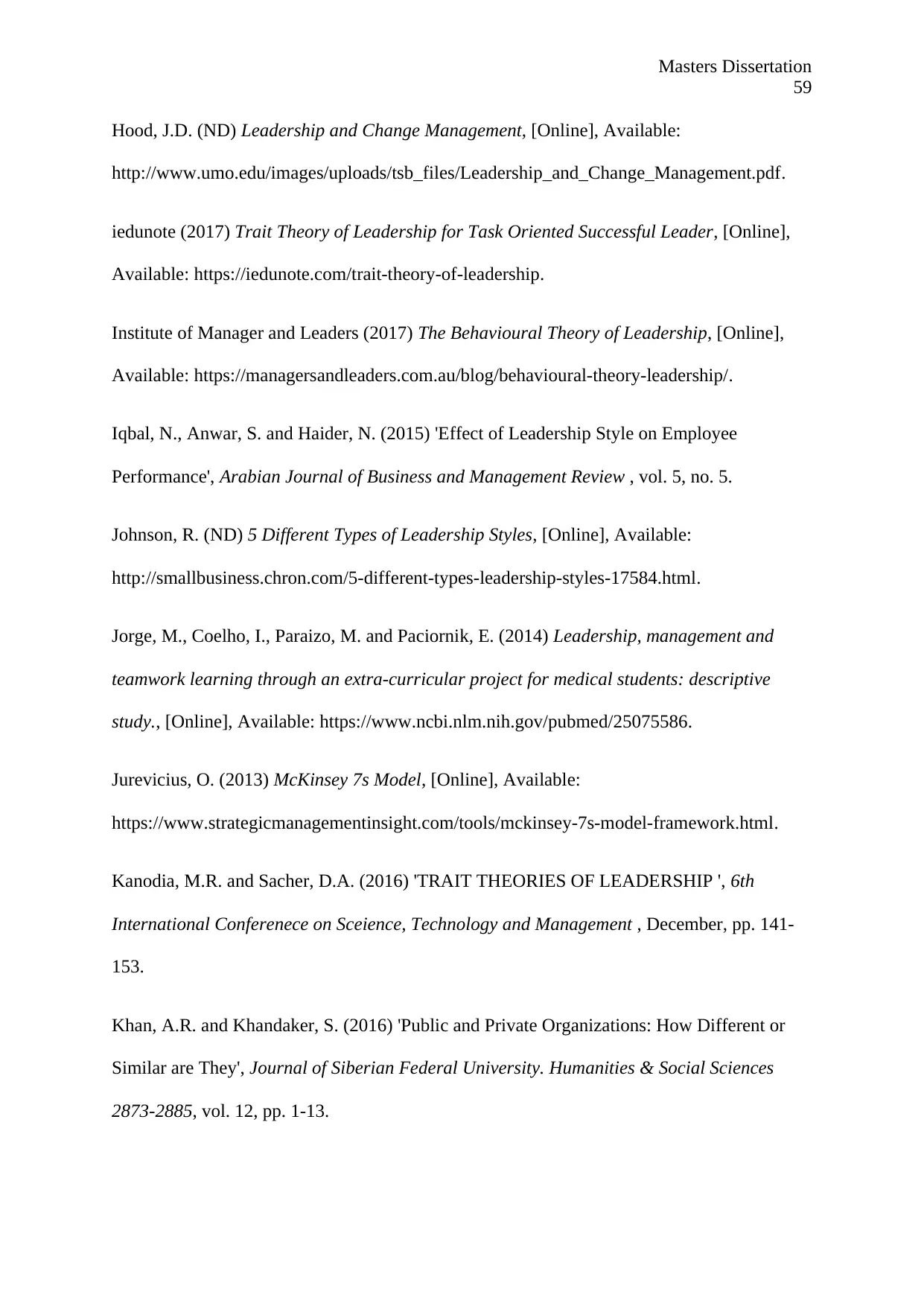
Masters Dissertation
59
Hood, J.D. (ND) Leadership and Change Management, [Online], Available:
http://www.umo.edu/images/uploads/tsb_files/Leadership_and_Change_Management.pdf.
iedunote (2017) Trait Theory of Leadership for Task Oriented Successful Leader, [Online],
Available: https://iedunote.com/trait-theory-of-leadership.
Institute of Manager and Leaders (2017) The Behavioural Theory of Leadership, [Online],
Available: https://managersandleaders.com.au/blog/behavioural-theory-leadership/.
Iqbal, N., Anwar, S. and Haider, N. (2015) 'Effect of Leadership Style on Employee
Performance', Arabian Journal of Business and Management Review , vol. 5, no. 5.
Johnson, R. (ND) 5 Different Types of Leadership Styles, [Online], Available:
http://smallbusiness.chron.com/5-different-types-leadership-styles-17584.html.
Jorge, M., Coelho, I., Paraizo, M. and Paciornik, E. (2014) Leadership, management and
teamwork learning through an extra-curricular project for medical students: descriptive
study., [Online], Available: https://www.ncbi.nlm.nih.gov/pubmed/25075586.
Jurevicius, O. (2013) McKinsey 7s Model, [Online], Available:
https://www.strategicmanagementinsight.com/tools/mckinsey-7s-model-framework.html.
Kanodia, M.R. and Sacher, D.A. (2016) 'TRAIT THEORIES OF LEADERSHIP ', 6th
International Conferenece on Sceience, Technology and Management , December, pp. 141-
153.
Khan, A.R. and Khandaker, S. (2016) 'Public and Private Organizations: How Different or
Similar are They', Journal of Siberian Federal University. Humanities & Social Sciences
2873-2885, vol. 12, pp. 1-13.
59
Hood, J.D. (ND) Leadership and Change Management, [Online], Available:
http://www.umo.edu/images/uploads/tsb_files/Leadership_and_Change_Management.pdf.
iedunote (2017) Trait Theory of Leadership for Task Oriented Successful Leader, [Online],
Available: https://iedunote.com/trait-theory-of-leadership.
Institute of Manager and Leaders (2017) The Behavioural Theory of Leadership, [Online],
Available: https://managersandleaders.com.au/blog/behavioural-theory-leadership/.
Iqbal, N., Anwar, S. and Haider, N. (2015) 'Effect of Leadership Style on Employee
Performance', Arabian Journal of Business and Management Review , vol. 5, no. 5.
Johnson, R. (ND) 5 Different Types of Leadership Styles, [Online], Available:
http://smallbusiness.chron.com/5-different-types-leadership-styles-17584.html.
Jorge, M., Coelho, I., Paraizo, M. and Paciornik, E. (2014) Leadership, management and
teamwork learning through an extra-curricular project for medical students: descriptive
study., [Online], Available: https://www.ncbi.nlm.nih.gov/pubmed/25075586.
Jurevicius, O. (2013) McKinsey 7s Model, [Online], Available:
https://www.strategicmanagementinsight.com/tools/mckinsey-7s-model-framework.html.
Kanodia, M.R. and Sacher, D.A. (2016) 'TRAIT THEORIES OF LEADERSHIP ', 6th
International Conferenece on Sceience, Technology and Management , December, pp. 141-
153.
Khan, A.R. and Khandaker, S. (2016) 'Public and Private Organizations: How Different or
Similar are They', Journal of Siberian Federal University. Humanities & Social Sciences
2873-2885, vol. 12, pp. 1-13.
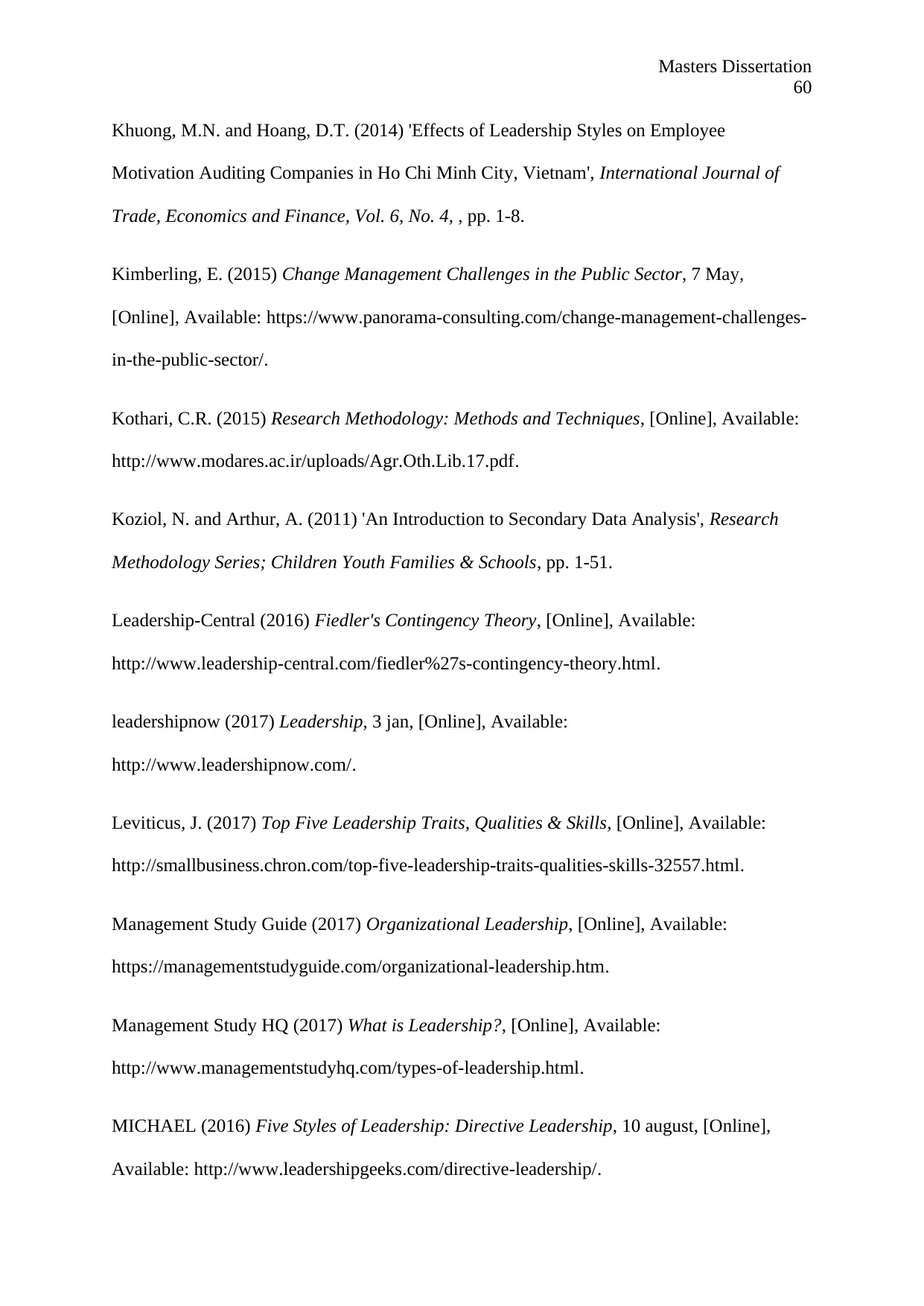
Masters Dissertation
60
Khuong, M.N. and Hoang, D.T. (2014) 'Effects of Leadership Styles on Employee
Motivation Auditing Companies in Ho Chi Minh City, Vietnam', International Journal of
Trade, Economics and Finance, Vol. 6, No. 4, , pp. 1-8.
Kimberling, E. (2015) Change Management Challenges in the Public Sector, 7 May,
[Online], Available: https://www.panorama-consulting.com/change-management-challenges-
in-the-public-sector/.
Kothari, C.R. (2015) Research Methodology: Methods and Techniques, [Online], Available:
http://www.modares.ac.ir/uploads/Agr.Oth.Lib.17.pdf.
Koziol, N. and Arthur, A. (2011) 'An Introduction to Secondary Data Analysis', Research
Methodology Series; Children Youth Families & Schools, pp. 1-51.
Leadership-Central (2016) Fiedler's Contingency Theory, [Online], Available:
http://www.leadership-central.com/fiedler%27s-contingency-theory.html.
leadershipnow (2017) Leadership, 3 jan, [Online], Available:
http://www.leadershipnow.com/.
Leviticus, J. (2017) Top Five Leadership Traits, Qualities & Skills, [Online], Available:
http://smallbusiness.chron.com/top-five-leadership-traits-qualities-skills-32557.html.
Management Study Guide (2017) Organizational Leadership, [Online], Available:
https://managementstudyguide.com/organizational-leadership.htm.
Management Study HQ (2017) What is Leadership?, [Online], Available:
http://www.managementstudyhq.com/types-of-leadership.html.
MICHAEL (2016) Five Styles of Leadership: Directive Leadership, 10 august, [Online],
Available: http://www.leadershipgeeks.com/directive-leadership/.
60
Khuong, M.N. and Hoang, D.T. (2014) 'Effects of Leadership Styles on Employee
Motivation Auditing Companies in Ho Chi Minh City, Vietnam', International Journal of
Trade, Economics and Finance, Vol. 6, No. 4, , pp. 1-8.
Kimberling, E. (2015) Change Management Challenges in the Public Sector, 7 May,
[Online], Available: https://www.panorama-consulting.com/change-management-challenges-
in-the-public-sector/.
Kothari, C.R. (2015) Research Methodology: Methods and Techniques, [Online], Available:
http://www.modares.ac.ir/uploads/Agr.Oth.Lib.17.pdf.
Koziol, N. and Arthur, A. (2011) 'An Introduction to Secondary Data Analysis', Research
Methodology Series; Children Youth Families & Schools, pp. 1-51.
Leadership-Central (2016) Fiedler's Contingency Theory, [Online], Available:
http://www.leadership-central.com/fiedler%27s-contingency-theory.html.
leadershipnow (2017) Leadership, 3 jan, [Online], Available:
http://www.leadershipnow.com/.
Leviticus, J. (2017) Top Five Leadership Traits, Qualities & Skills, [Online], Available:
http://smallbusiness.chron.com/top-five-leadership-traits-qualities-skills-32557.html.
Management Study Guide (2017) Organizational Leadership, [Online], Available:
https://managementstudyguide.com/organizational-leadership.htm.
Management Study HQ (2017) What is Leadership?, [Online], Available:
http://www.managementstudyhq.com/types-of-leadership.html.
MICHAEL (2016) Five Styles of Leadership: Directive Leadership, 10 august, [Online],
Available: http://www.leadershipgeeks.com/directive-leadership/.
Secure Best Marks with AI Grader
Need help grading? Try our AI Grader for instant feedback on your assignments.

Masters Dissertation
61
Nanjundeswaraswamy, T.S. and Swamy, D.R. (2014) Leadership styles, february, [Online],
Available: https://www.mnsu.edu/activities/leadership/leadership_styles.pdf.
nwlink (2015) Concepts of Leadership, 2 august, [Online], Available:
http://www.nwlink.com/~donclark/leader/leadcon.html.
Parikh, V. (2016) Advantages and Disadvantages of Autocratic Leadership, 24 April,
[Online], Available: http://www.letslearnfinance.com/advantages-and-disadvantages-of-
autocratic-leadership.html.
Phan, P. (2015) 'Entering the Israeli market for Finnish technology company', Degree
Programme in International Business, pp. 1-120.
Post, J. (2017) 11 Ways to Define Leadership, 29 March, [Online], Available:
http://www.businessnewsdaily.com/3647-leadership-definition.html.
Pratt, M.K. (2017) situational leadership, [Online], Available:
http://searchcio.techtarget.com/definition/situational-leadership.
Reynolds, G.A. (2015) Transformational Leadership and Organizational Change, 28
october, [Online], Available: http://sites.psu.edu/leadership/2015/10/28/7377/.
Rouse, M. (2017) transactional leadership, [Online], Available:
http://searchcio.techtarget.com/definition/transactional-leadership.
Šimanskienė, L. and Župerkienė, E. (2014) 'SUSTAINABLE LEADERSHIP: THE NEW
CHALLENGE FOR ORGANIZATIONS', Forum Scientiae Oeconomia Volume 2; No 1, pp.
82-92.
Sohmen, D.V.S. (2013) 'Leadership and Teamwork: Two Sides of the Same Coin', Journal of
IT and Economic Development 4(2);
61
Nanjundeswaraswamy, T.S. and Swamy, D.R. (2014) Leadership styles, february, [Online],
Available: https://www.mnsu.edu/activities/leadership/leadership_styles.pdf.
nwlink (2015) Concepts of Leadership, 2 august, [Online], Available:
http://www.nwlink.com/~donclark/leader/leadcon.html.
Parikh, V. (2016) Advantages and Disadvantages of Autocratic Leadership, 24 April,
[Online], Available: http://www.letslearnfinance.com/advantages-and-disadvantages-of-
autocratic-leadership.html.
Phan, P. (2015) 'Entering the Israeli market for Finnish technology company', Degree
Programme in International Business, pp. 1-120.
Post, J. (2017) 11 Ways to Define Leadership, 29 March, [Online], Available:
http://www.businessnewsdaily.com/3647-leadership-definition.html.
Pratt, M.K. (2017) situational leadership, [Online], Available:
http://searchcio.techtarget.com/definition/situational-leadership.
Reynolds, G.A. (2015) Transformational Leadership and Organizational Change, 28
october, [Online], Available: http://sites.psu.edu/leadership/2015/10/28/7377/.
Rouse, M. (2017) transactional leadership, [Online], Available:
http://searchcio.techtarget.com/definition/transactional-leadership.
Šimanskienė, L. and Župerkienė, E. (2014) 'SUSTAINABLE LEADERSHIP: THE NEW
CHALLENGE FOR ORGANIZATIONS', Forum Scientiae Oeconomia Volume 2; No 1, pp.
82-92.
Sohmen, D.V.S. (2013) 'Leadership and Teamwork: Two Sides of the Same Coin', Journal of
IT and Economic Development 4(2);
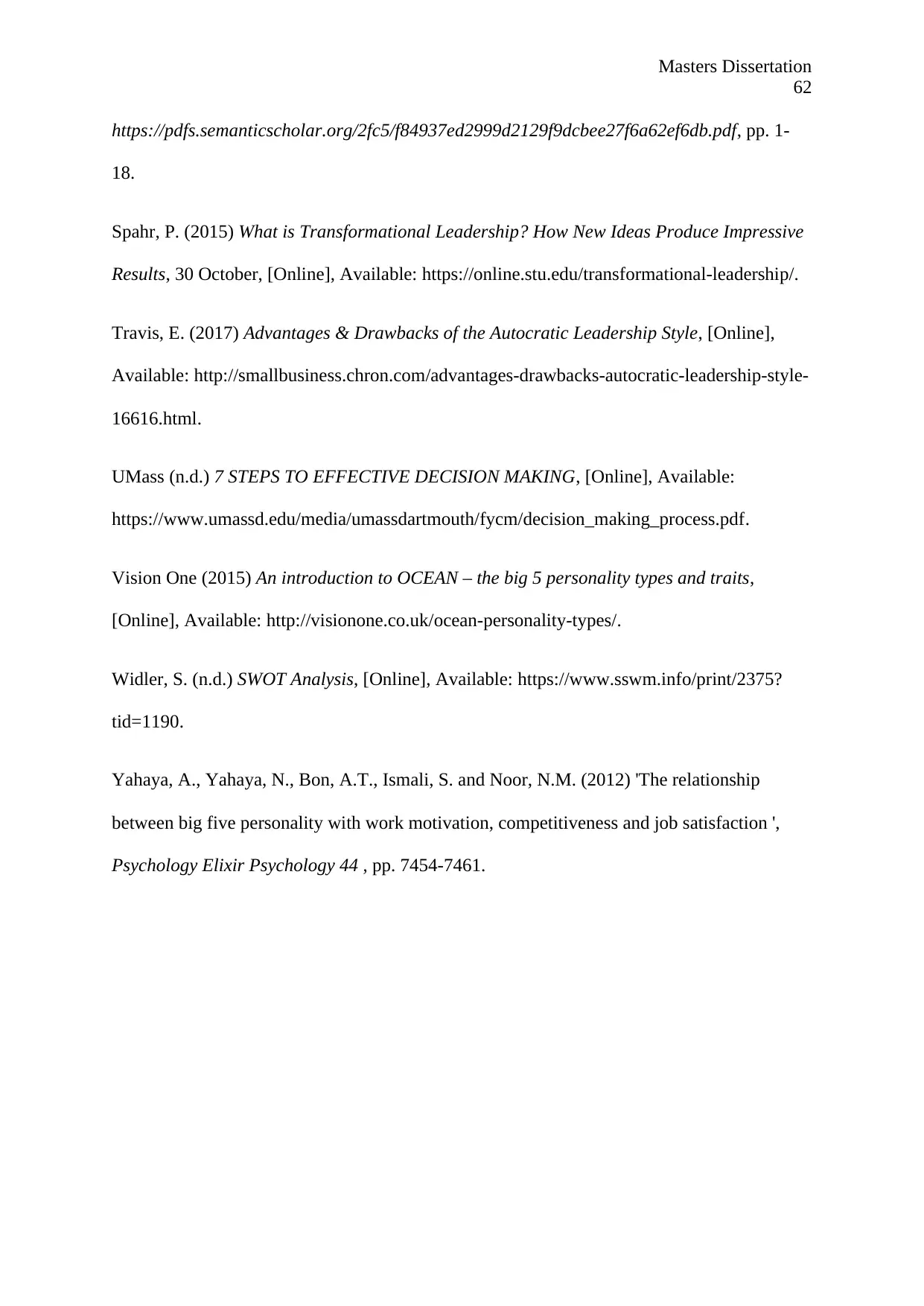
Masters Dissertation
62
https://pdfs.semanticscholar.org/2fc5/f84937ed2999d2129f9dcbee27f6a62ef6db.pdf, pp. 1-
18.
Spahr, P. (2015) What is Transformational Leadership? How New Ideas Produce Impressive
Results, 30 October, [Online], Available: https://online.stu.edu/transformational-leadership/.
Travis, E. (2017) Advantages & Drawbacks of the Autocratic Leadership Style, [Online],
Available: http://smallbusiness.chron.com/advantages-drawbacks-autocratic-leadership-style-
16616.html.
UMass (n.d.) 7 STEPS TO EFFECTIVE DECISION MAKING, [Online], Available:
https://www.umassd.edu/media/umassdartmouth/fycm/decision_making_process.pdf.
Vision One (2015) An introduction to OCEAN – the big 5 personality types and traits,
[Online], Available: http://visionone.co.uk/ocean-personality-types/.
Widler, S. (n.d.) SWOT Analysis, [Online], Available: https://www.sswm.info/print/2375?
tid=1190.
Yahaya, A., Yahaya, N., Bon, A.T., Ismali, S. and Noor, N.M. (2012) 'The relationship
between big five personality with work motivation, competitiveness and job satisfaction ',
Psychology Elixir Psychology 44 , pp. 7454-7461.
62
https://pdfs.semanticscholar.org/2fc5/f84937ed2999d2129f9dcbee27f6a62ef6db.pdf, pp. 1-
18.
Spahr, P. (2015) What is Transformational Leadership? How New Ideas Produce Impressive
Results, 30 October, [Online], Available: https://online.stu.edu/transformational-leadership/.
Travis, E. (2017) Advantages & Drawbacks of the Autocratic Leadership Style, [Online],
Available: http://smallbusiness.chron.com/advantages-drawbacks-autocratic-leadership-style-
16616.html.
UMass (n.d.) 7 STEPS TO EFFECTIVE DECISION MAKING, [Online], Available:
https://www.umassd.edu/media/umassdartmouth/fycm/decision_making_process.pdf.
Vision One (2015) An introduction to OCEAN – the big 5 personality types and traits,
[Online], Available: http://visionone.co.uk/ocean-personality-types/.
Widler, S. (n.d.) SWOT Analysis, [Online], Available: https://www.sswm.info/print/2375?
tid=1190.
Yahaya, A., Yahaya, N., Bon, A.T., Ismali, S. and Noor, N.M. (2012) 'The relationship
between big five personality with work motivation, competitiveness and job satisfaction ',
Psychology Elixir Psychology 44 , pp. 7454-7461.
1 out of 63
Related Documents
Your All-in-One AI-Powered Toolkit for Academic Success.
+13062052269
info@desklib.com
Available 24*7 on WhatsApp / Email
![[object Object]](/_next/static/media/star-bottom.7253800d.svg)
Unlock your academic potential
© 2024 | Zucol Services PVT LTD | All rights reserved.





